In two weeks we are off to Greece on holiday. The island we have been going to for the past few years is small and secluded with only a passing tourist trade, so the few restaurants are used mainly by locals, or holidaying Athenians and Greek expatriots from America and Australia. Alongside the ubiquitous Greek salad there are a number of traditional vegetable dishes served by all the establishments and one of our favourites is the inspiration for this recipe.
The first time we ordered this a large plate of simply dressed beetroot came to the table, piled on top of the wilted leaves and covered in rich garlicky Greek yogurt. It was so simple, and so delicious, we couldn’t believe that we had never thought to eat beetroot greens before. They had always ended up on the compost. We get through a lot of chard and spinach and we now often eat the beetroot leaves alone like these two crops, wilted in olive oil with garlic and dressed with lemon juice. They have the earthy flavour of beets, and the stalks have something of the succulence of chard, but with a distinctive sweetness. It is important to use the leaves of young beetroot and discard the oldest leaves as the stalks of these are stringy.
For variety we grow a number of different coloured beets and the appearance of this dish is lifted by the mix of colours. However, it is just as good with plain purple beets.

From left to right: Beetroot ‘Burpees Golden’, ‘Snowball’, ‘Tonda di Chioggia’ and ‘Egitto Migliorata’
Walnuts and dill are natural companions to beetroot. The earthiness of the nuts complements that of roots and the dill adds a fresh, sweet note that prevents the dish from feeling too heavy. Fennel, parsley or mint could be used instead.
Given the limited number of ingredients this dish is surprisingly rich and a little goes a long way. It can be served as part of a table of meze, with hummus, fried halloumi, meatballs and spanakopita, or as a side dish to accompany grilled white fish or chicken.
Serves 6
Ingredients
1kg beetroot with leaves intact
2 cloves garlic
100g walnut pieces
Juice of one lemon
Extra virgin olive oil
200g Greek yogurt
Dill leaves and flowers
Sea salt
Method
Preheat the oven to 200°C.
Remove the leaves from the beetroot and discard the oldest ones.
Scrub the beetroots well and wrap individually in tin foil. Put into a baking tin and, depending on their size, cook for 40 – 60 minutes until you can pierce them easily with a sharp knife. Remove from the oven and allow the beetroot to cool for 20 minutes in their foil jackets. Before turning off the oven spread the walnut pieces out on a baking sheet and toast in the oven for about 3 minutes until lightly coloured and fragrant.
Remove the foil from the beetroot and rub the skins off under a cold running tap or in a bowl of cold water. Slice from top to bottom into eighths to produce slim wedges. Put into a bowl and dress with lemon juice, olive oil and a little salt. If using mixed colours of beetroot you will need to use separate bowls for each variety to prevent the colours from bleeding into each other.
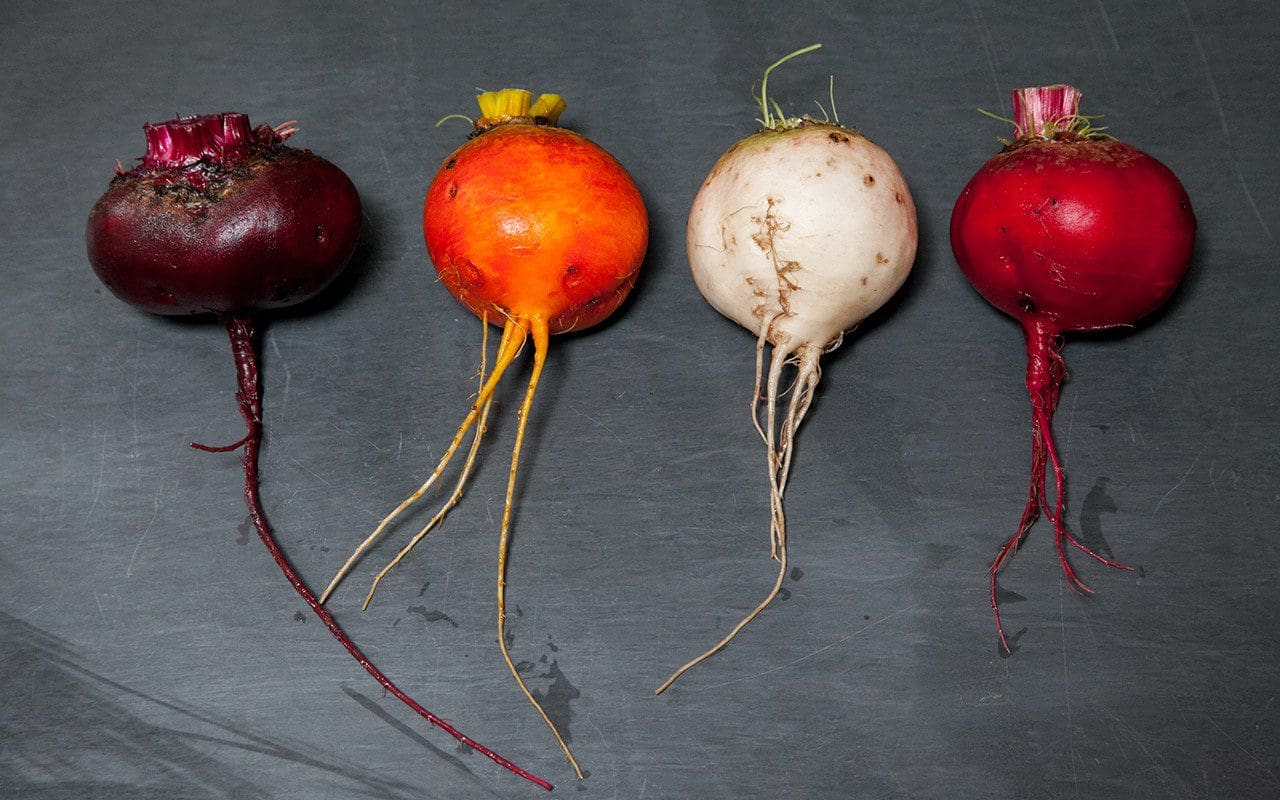 From left to right: Beetroot ‘Egitto Migliorata’, ‘Burpees Golden’, ‘Snowball’ and ‘Tonda di Chioggia’
From left to right: Beetroot ‘Egitto Migliorata’, ‘Burpees Golden’, ‘Snowball’ and ‘Tonda di Chioggia’
Put a large lidded pan on a high heat. Wash the reserved beetroot leaves and immediately put into the pan with as much water as possible still clinging to them. Put the lid on tight. From time to time shake the pan and check to see that there is enough water in the pan to create steam. You may need to add an egg-cupful of water if looks like it is getting dry. They are done when you can pierce the stalks with a sharp knife. Remove from the heat, take the lid off the pan and immediately dress the leaves with lemon juice and olive oil until well coated. Season with salt and allow to cool.
To make the yogurt dressing grate the garlic cloves into a bowl large enough to hold the yogurt. Add the yogurt, salt and 4 tablespoons of olive oil. Stir vigorously until well combined.
To serve arrange the wilted leaves on a plate, place the beetroot wedges on top, then spoon on the yogurt dressing and scatter over the walnuts. Decorate with dill leaves and flowers and a final drizzle of olive oil.
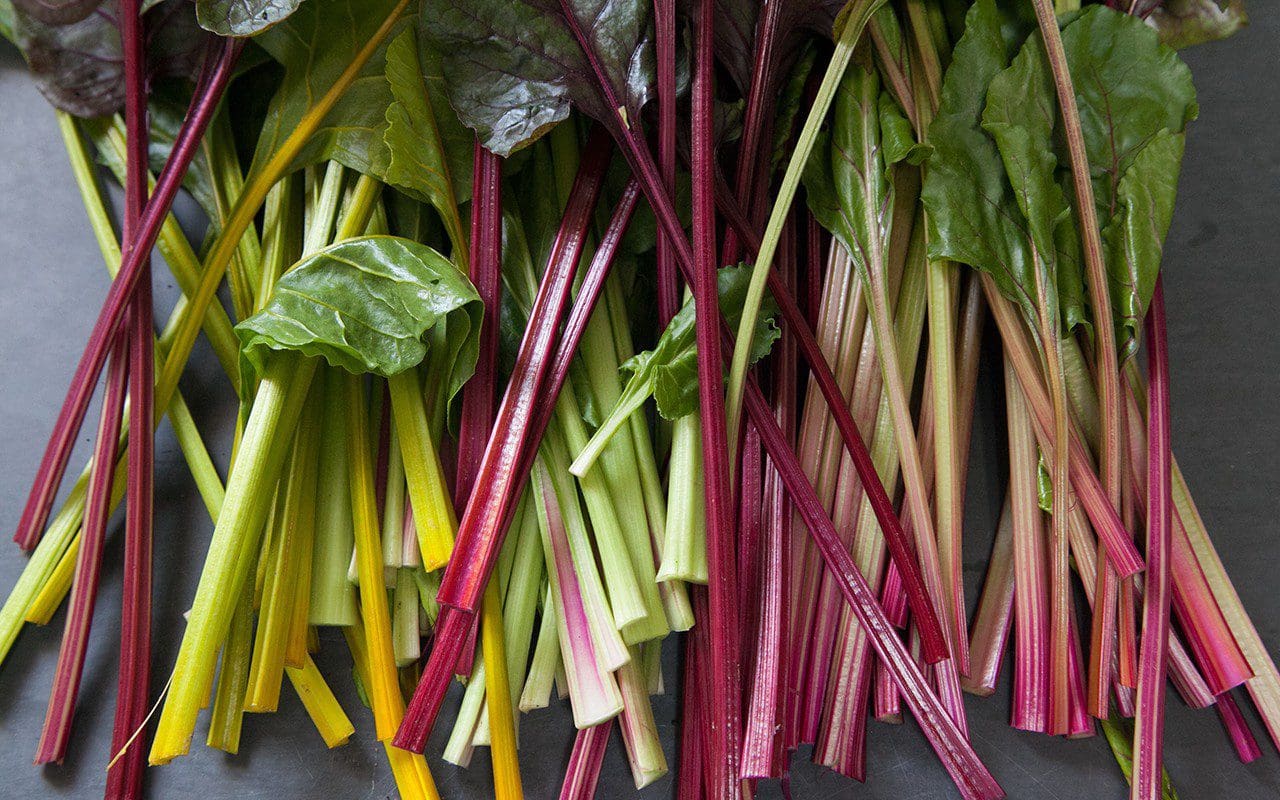
Recipe and photographs: Huw Morgan
This time last week we were down in Cornwall at the Port Eliot Festival. It was the second time I have been asked to speak there and to be one of the judges for the Flower Show. I have a particular fondness for the festival, which takes over the grounds of the estate, wraps around the house, runs alongside the banks of the River Tamar and nestles in a series of old walled gardens. The events and the tents and the happenings are carefully choreographed in a low-key fashion so that, as you roam the grounds, you discover as you go.
The landscape gardens were set out in the 18th century by Humphrey Repton, who made a grand move to push the river away from the house and in its place sweep a rolling lawn that connected a ha-ha in front of the house to the hills and woods beyond. I was lucky enough to stay in the house last autumn at Halloween with Perry and Cathy St. Germans, the Festival Director, and had the opportunity of looking over Repton’s Red Book. His books became one of his signatures as a designer and featured images of the existing landscape with a reveal that you could pull back to see the proposed vision. It is wonderful to walk in this vision today and for this festival to be so easily integrated into the historic setting.
 Mudlarking in the Tamar estuary
Mudlarking in the Tamar estuary
 Picknicking on hay bales
Picknicking on hay bales
 Gyspy caravans and tents amongst the trees
Gyspy caravans and tents amongst the trees
The grounds are filled with delights. You will never see a hi-vis jacket and people are free to roam and picnic or swim wild in the estuary. The tents, which are scattered in clusters that each have their own atmosphere, hold talks, readings, conversations, cooking demonstrations and performances – anything from a discussion with an artist, musician or writer to a blindingly brilliant set by the Japanese band Bo Ningen. There are craft workshops in the Hole & Corner tent, where you can learn to forge a nail, dye with indigo, make a green oak stool or watch Britain’s last traditional clog maker at work. You can learn bushcraft skills or go foraging for food, plants and flowers to make your own botanical inks.
 Indigo dyeing workshop at Hole & Corner
Indigo dyeing workshop at Hole & Corner
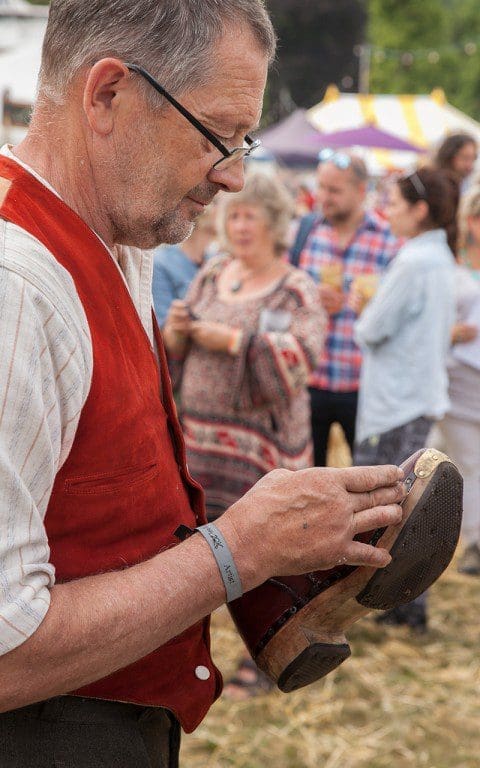 Traditional clog maker, Jeremy Atkinson
Traditional clog maker, Jeremy Atkinson

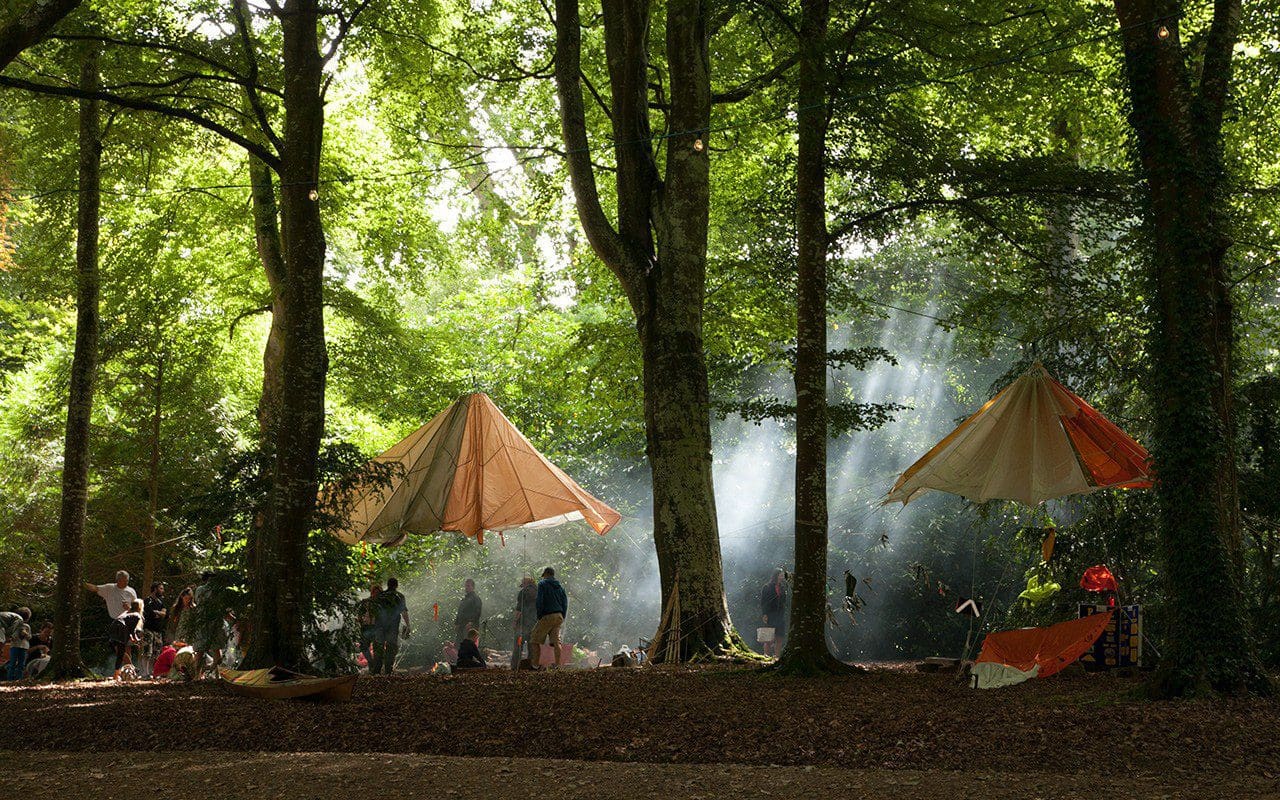 Bushcraft workshop
Bushcraft workshop
In the Wardrobe Department kids can take life drawing lessons from Barbara Hulanicki – with models including Oscar-winning Costume Designer, Sandy Powell – have a hat made by top milliner Stephen Jones, or take part in themed fashion shows – last year it was Game of Thrones, this year ’80’s Disco. The eateries are plentiful and always good and between events you can retire to the waterside gin bar and sit in a deck-chair people-watching with a backdrop of mudlarkers when the tide is out. There is a Wild West saloon with live music and real swing doors to make an entrance. You can take a hot tub on the banks of the river under the stars as we did, or boogie in the woods till dawn, or both if that is the way that the evening pans out.
Finding respite from the crowds in the house, the high ceilings and faded grandeur provide an elegant setting for magical installations and exhibitions of historic interest. In the Dining Room this year two articulated dolls made by Leonidas set an appropriately spooky tone, which put us in mind of The Turn of the Screw.
 Life drawing with Barbara Hulanicki
Life drawing with Barbara Hulanicki
 Costume Designer, Sandy Powell (right), posing for the life drawing class
Costume Designer, Sandy Powell (right), posing for the life drawing class
 Dan chatting to milliner, Stephen Jones
Dan chatting to milliner, Stephen Jones
 Dolls by Leonidas of La Poupée Mécanique
Dolls by Leonidas of La Poupée Mécanique
The garden, which rolls over the undulating terrain in a series of copses and clearings boasts some magnificent trees and, wherever you go, there are surprises; a huge Magnolia delavayi, a camellia walk, a maze that took Perry years to plan. The Walled Garden, which is gardened lightly today, has runs of colourful Higgledy Garden annual seed mixes jostling against high, lichened walls. A huge Crinum powelli ‘Album’ makes an appearance next to the Orangery and hydrangeas burst from behind box hedges, as if from another age. As you swing down to the estuary, dramatically spanned by Brunel’s viaduct, you are greeted by a lawn punctuated with clumps of giant Pampas grass. This is the way to see them, marching confidently across the landscape.
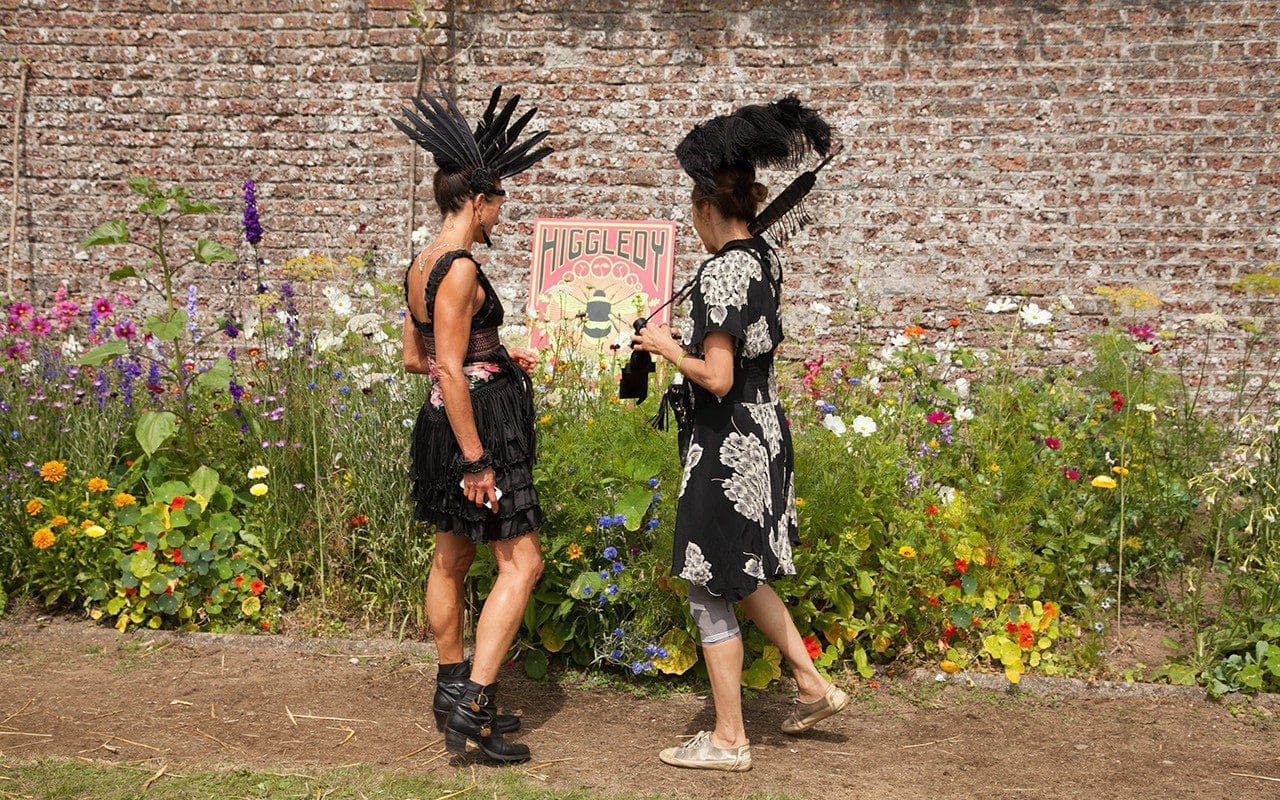
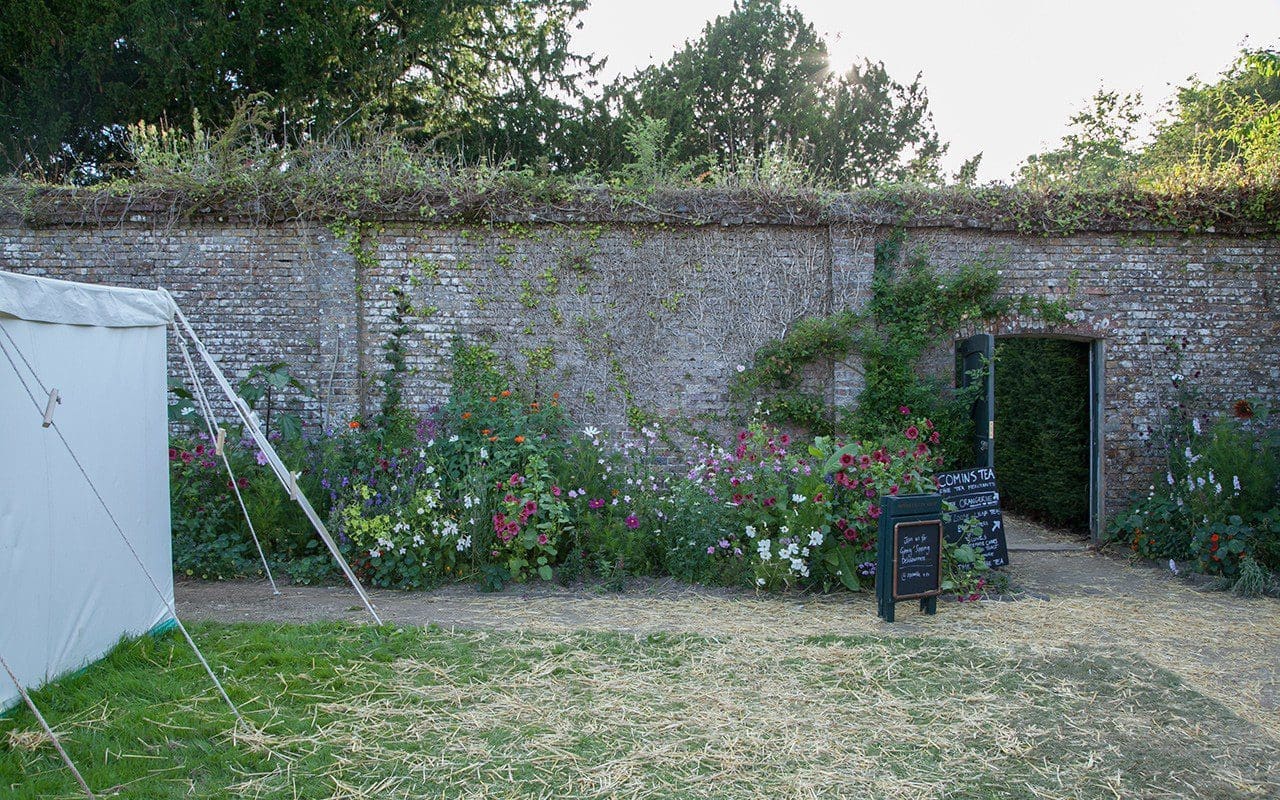 Higgledy Garden borders in the Walled Garden
Higgledy Garden borders in the Walled Garden
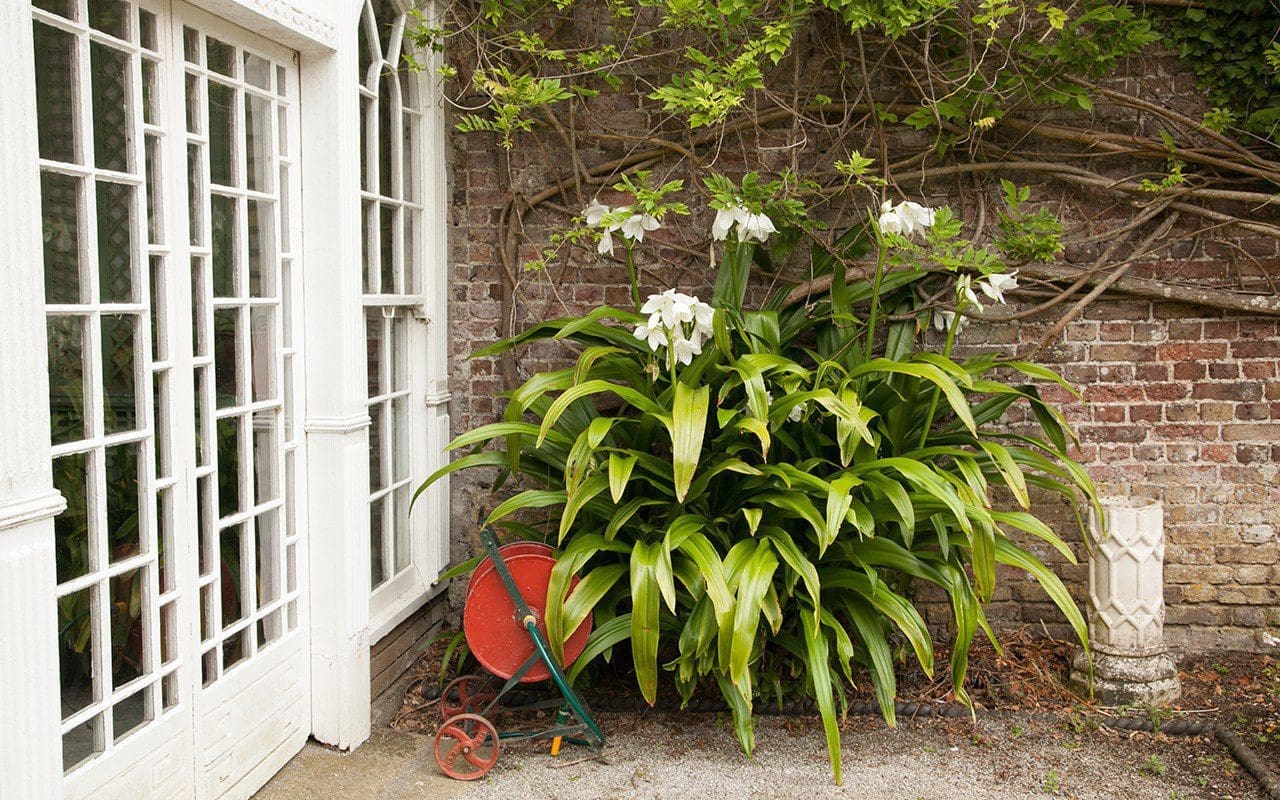 Crinum powelli ‘Album’ by The Orangery
Crinum powelli ‘Album’ by The Orangery
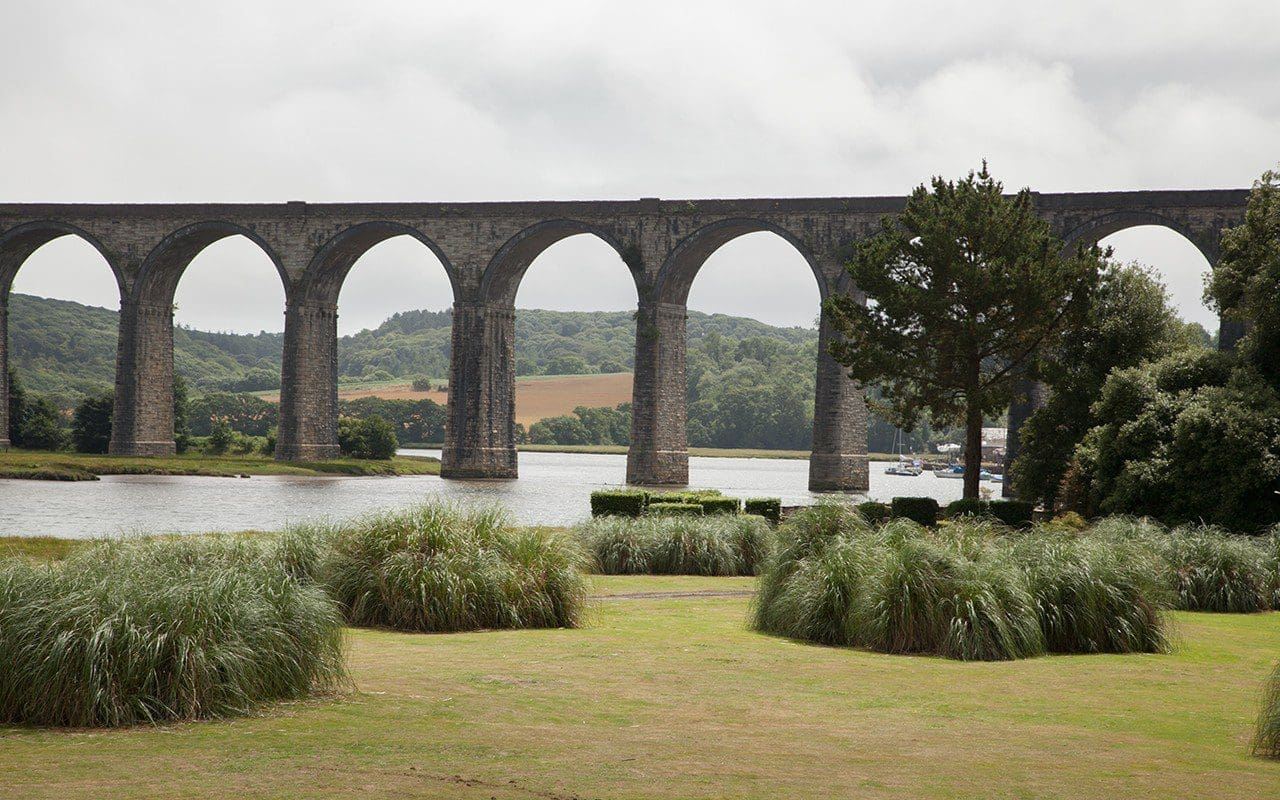 Brunel’s viaduct and Pampas grass
Brunel’s viaduct and Pampas grass
The serious matter of judging the Flower Show started on Friday afternoon as we took a sneak preview of the entries as they started to arrive into the below-stairs corridors beneath the house. Cool flag floors and no windows provided a perfect environment for the flowers, which were arranged on trestle tables according to the entry classes. A workbench at the end of the corridor was set up for last minute arranging and adjustments, and the judging started at 9:30 prompt the following morning.
Michael Howells, the festival’s Creative Director, adjudicated. The judges, Sarah Husband, Tony Howard, Huw and myself followed behind to make our selections. A pair of redoubtable local WI members ensured that the judging was rigorous and fair, recorded the names and entry numbers of the entrants and placed rosettes and cups. The themes of the Flower Show at the festival are always inspiring and spawn great leaps of imagination amongst the entrants. True to the best of English flower shows there are sections for both adults and children.
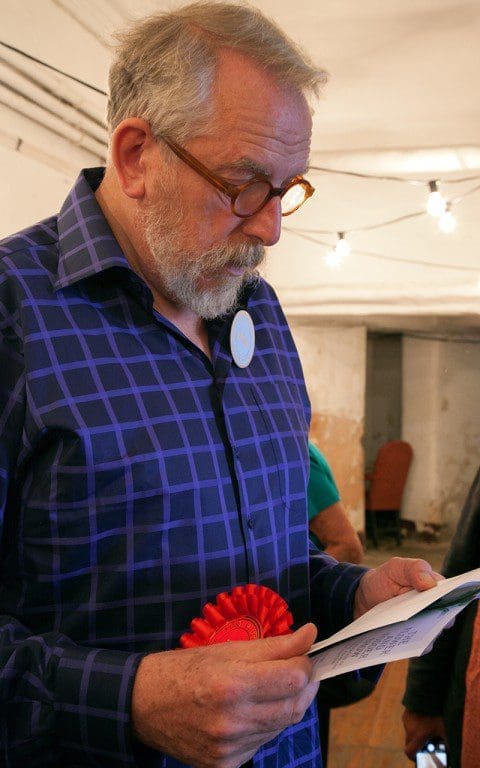 Creative Director, Michael Howells
Creative Director, Michael Howells
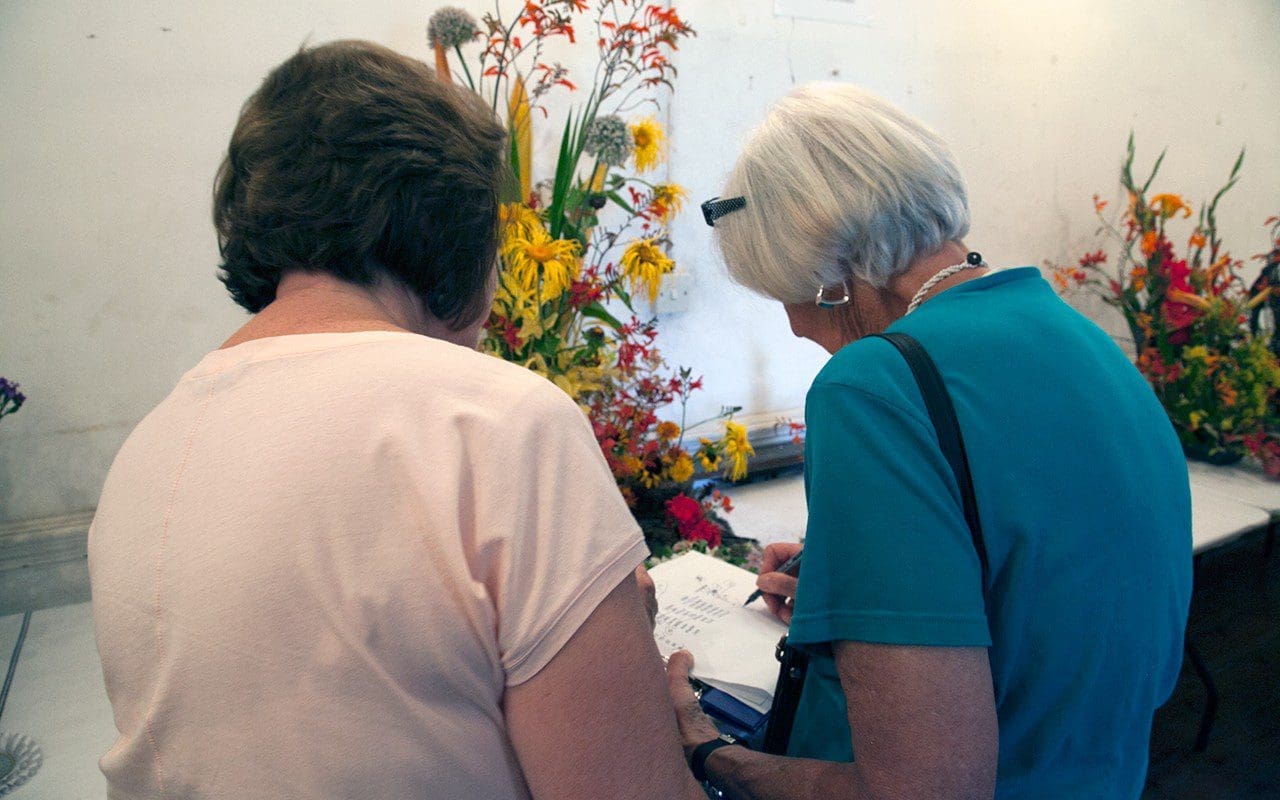 Members of the local Women’s Institute record the judging
Members of the local Women’s Institute record the judging
The adult classes this year included a range of subjects marking a number of significant anniversaries. The 300th anniversary of the birth of Capability Brown was celebrated in a miniature landscape garden. I love a miniature garden and attribute my career to a rosette-winner I made when I was ten for the Liss Flower Show.
The class ‘Fire Fire !!’ marked the 350th anniversary of the Great Fire of London and entries used the best of high summer colour to paint this picture.
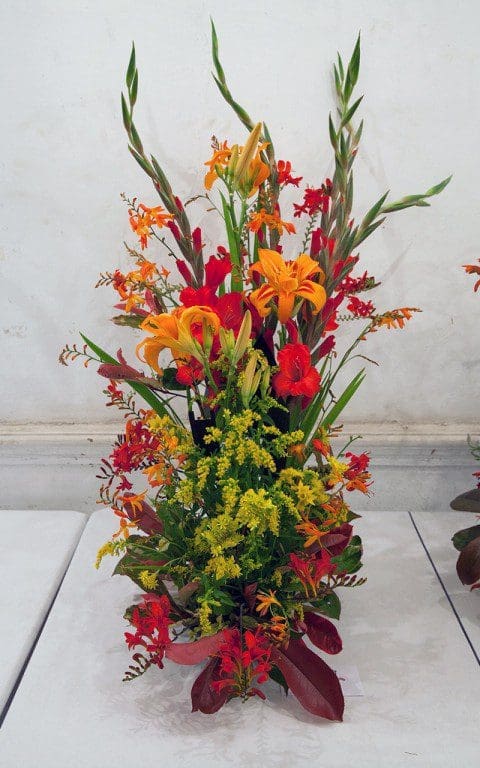
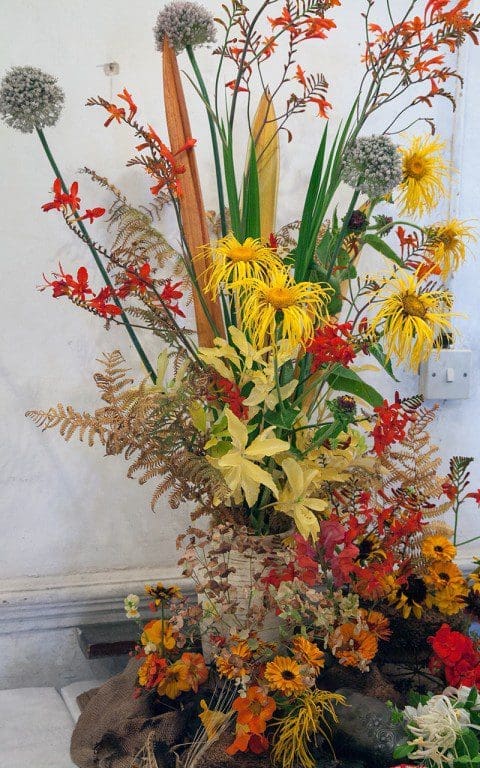 Entries in the ‘Fire Fire !!’ class
Entries in the ‘Fire Fire !!’ class
‘All the World’s a Stage’ celebrated the 400th anniversary of the death of William Shakespeare, whilst ‘A Sight for Sore Eyes’ (commemorating the 950th anniversary of the Battle of Hastings) generated the Best in Show award with a gory battlefield, set against a bloodied English flag. King Harold, made from torn paper, arms and legs akimbo, lay with an arrow in his eye and drops of glistening blood.
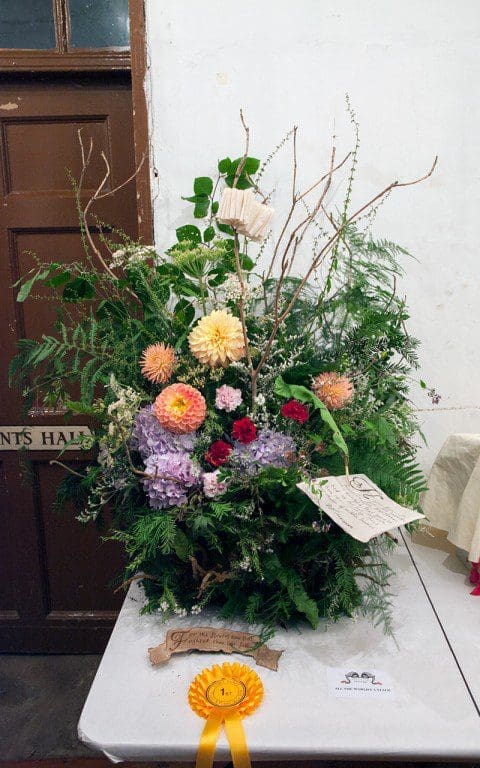
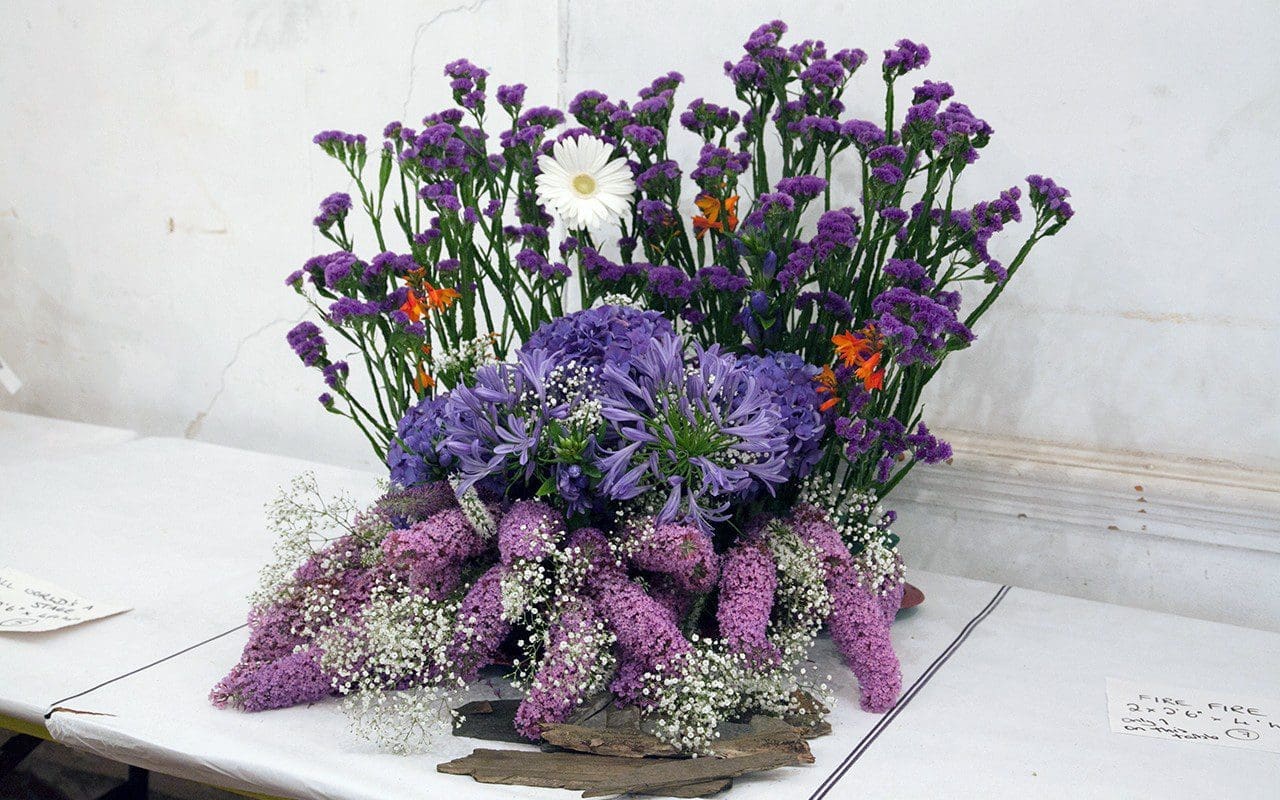 Entries in the ‘All the World’s a Stage’ class
Entries in the ‘All the World’s a Stage’ class
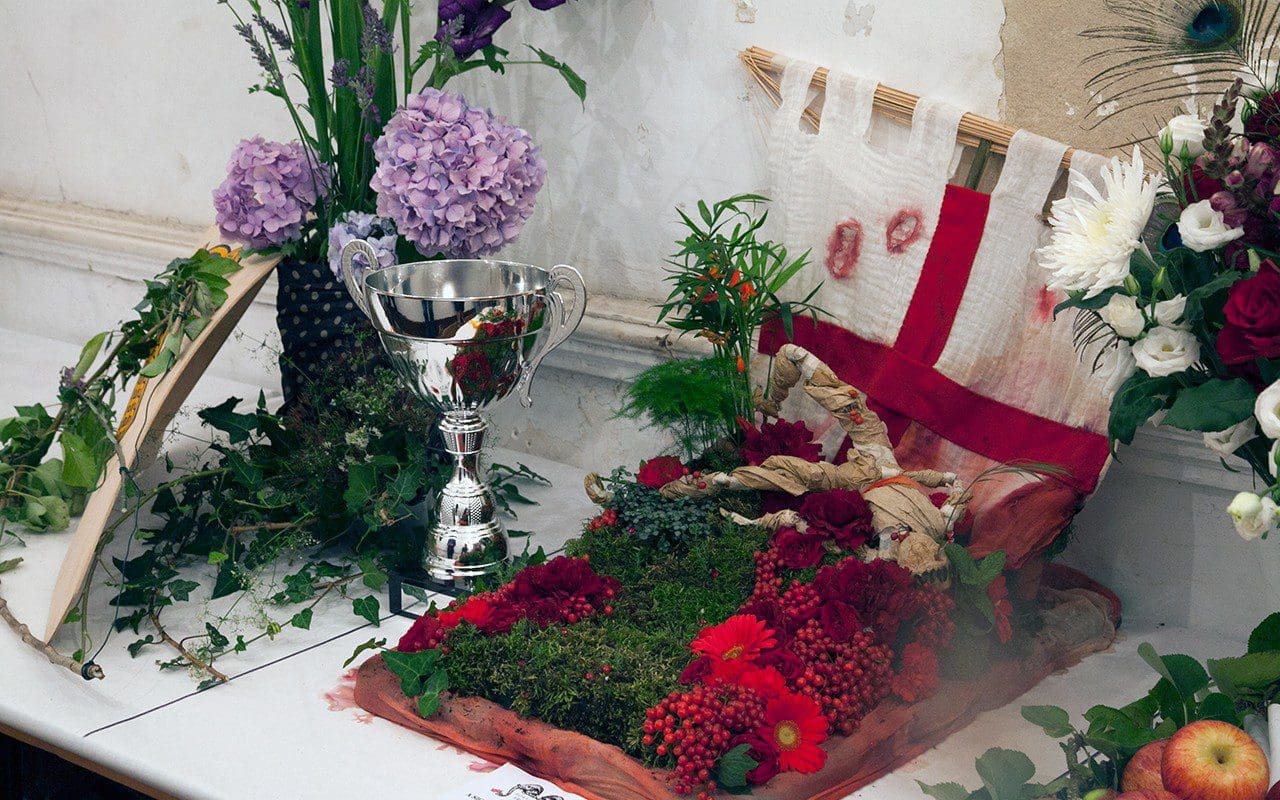
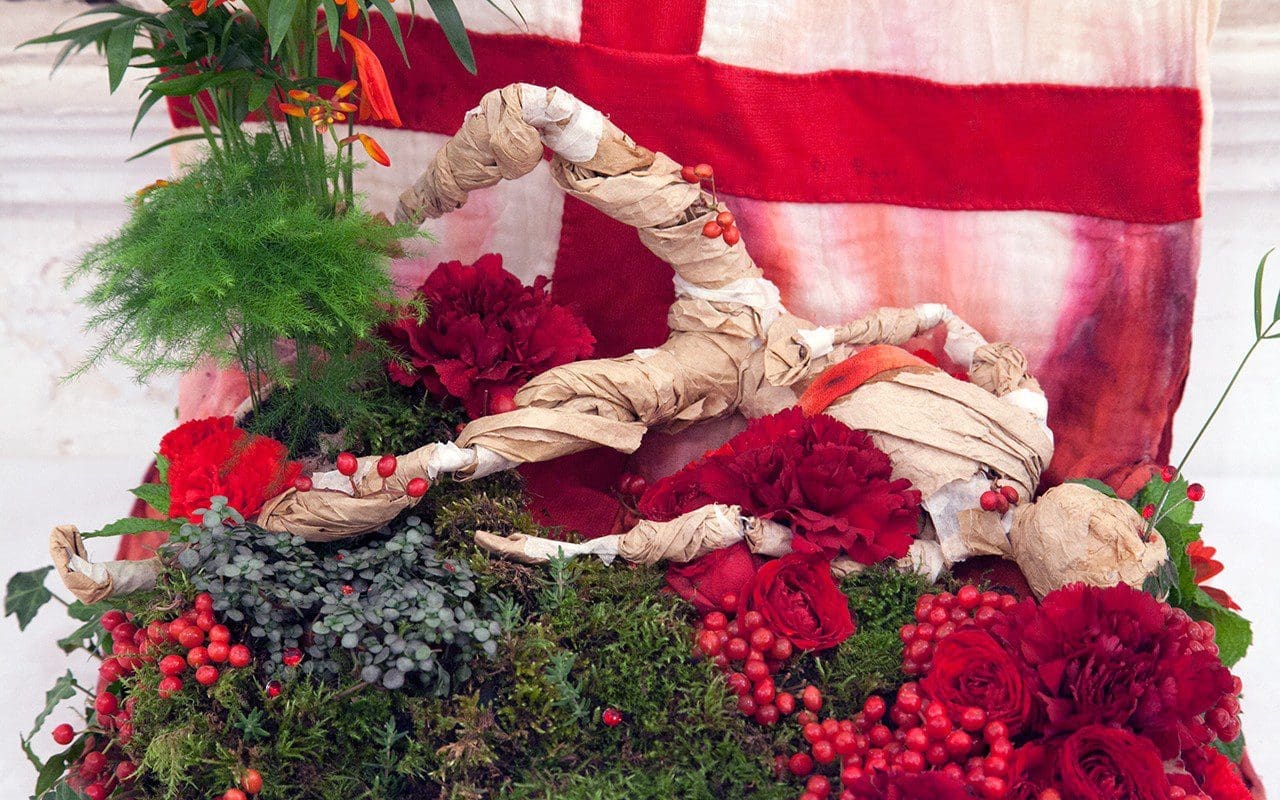 Winner of Best in Show and First Prize in the ‘A Sight for Sore Eyes’ class
Winner of Best in Show and First Prize in the ‘A Sight for Sore Eyes’ class
‘Down the Garden Path’, celebrating the 150th anniversary of the birth of Beatrix Potter was, not surprisingly, a delight and one exhibit stood out immediately for its attention to detail with miniature tools and even a tiny cross bearing Peter Rabbit’s blue coat. It was a world within a world and a unanimous First Prize winner.
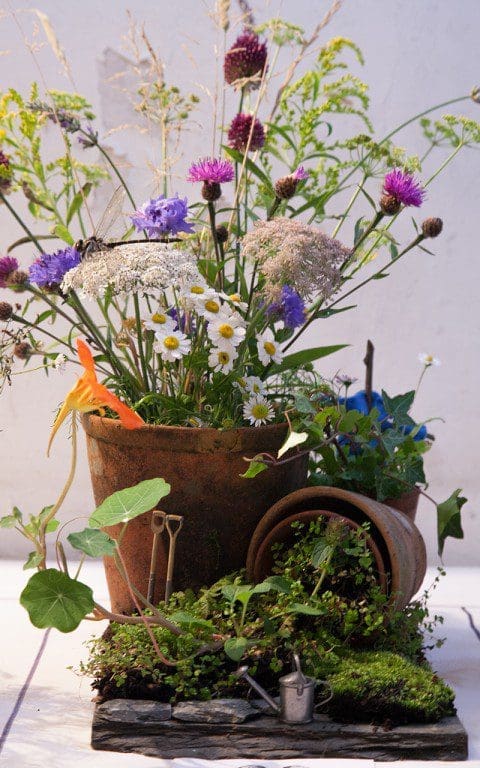
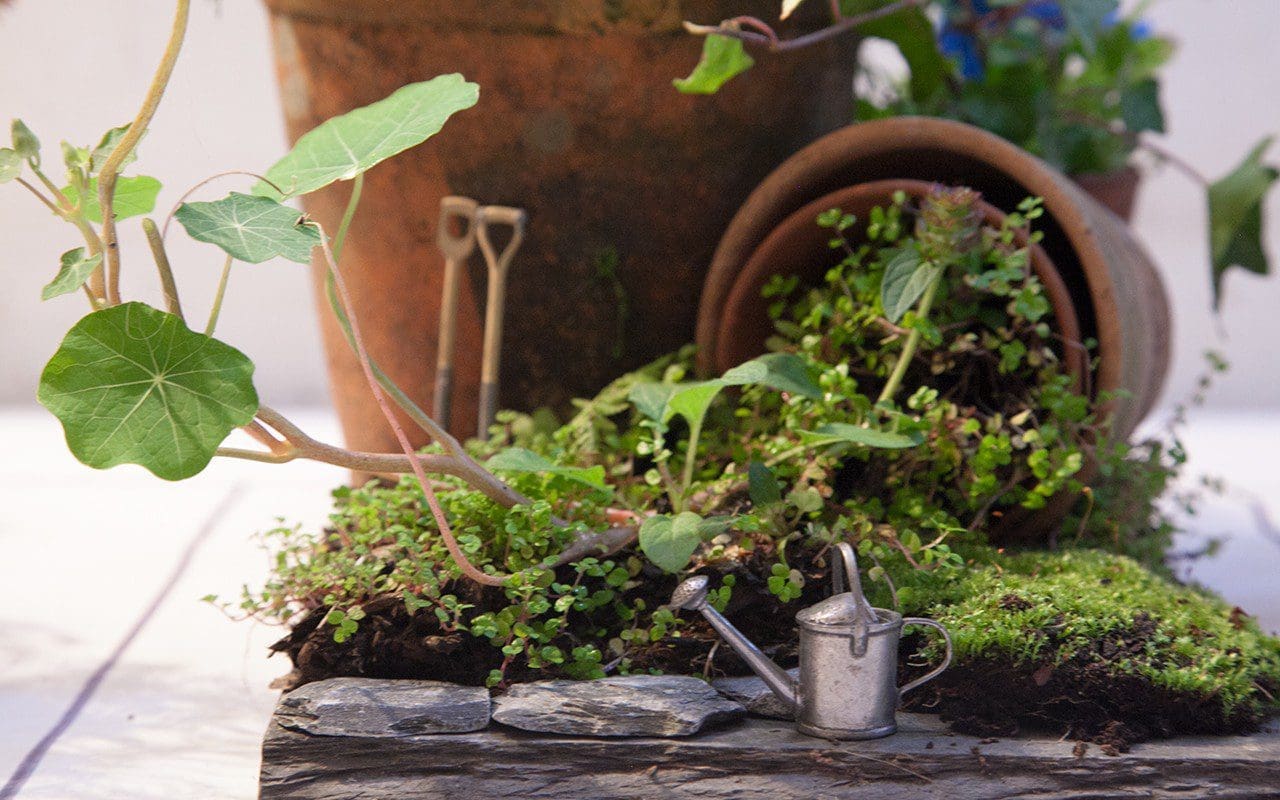 Winner of the ‘Down the Garden Path’ class
Winner of the ‘Down the Garden Path’ class
The children’s section (“‘My Hero’ – a sculpture of your favourite Roald Dahl character made of fruits and vegetables”) is always fun and shows great inventiveness, and we struggled from wondering if one or two had had adult assistance, they were that clever. I loved the anthropomorphic transformation of fruit and veg into characters. They were pure unbridled fun.
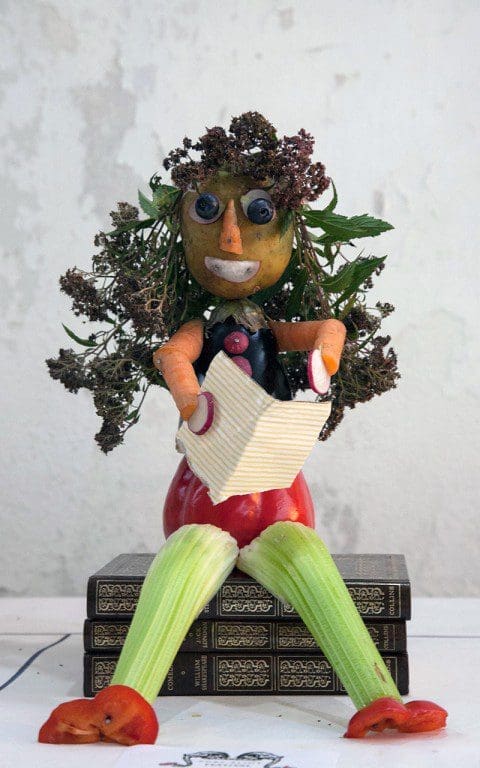
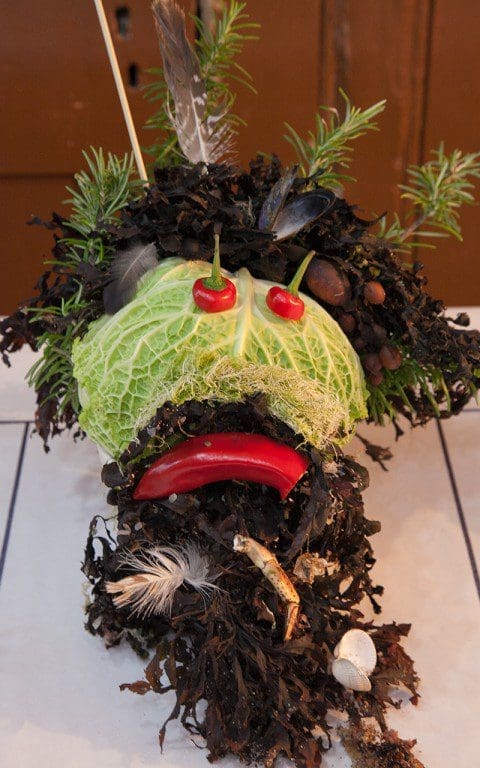

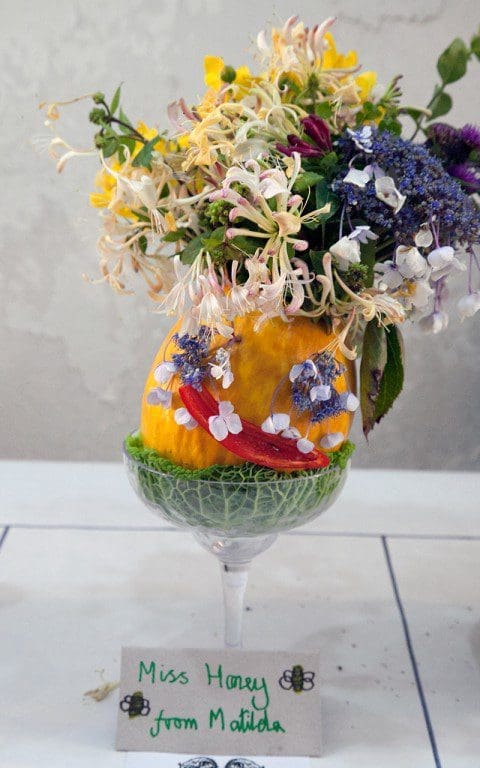

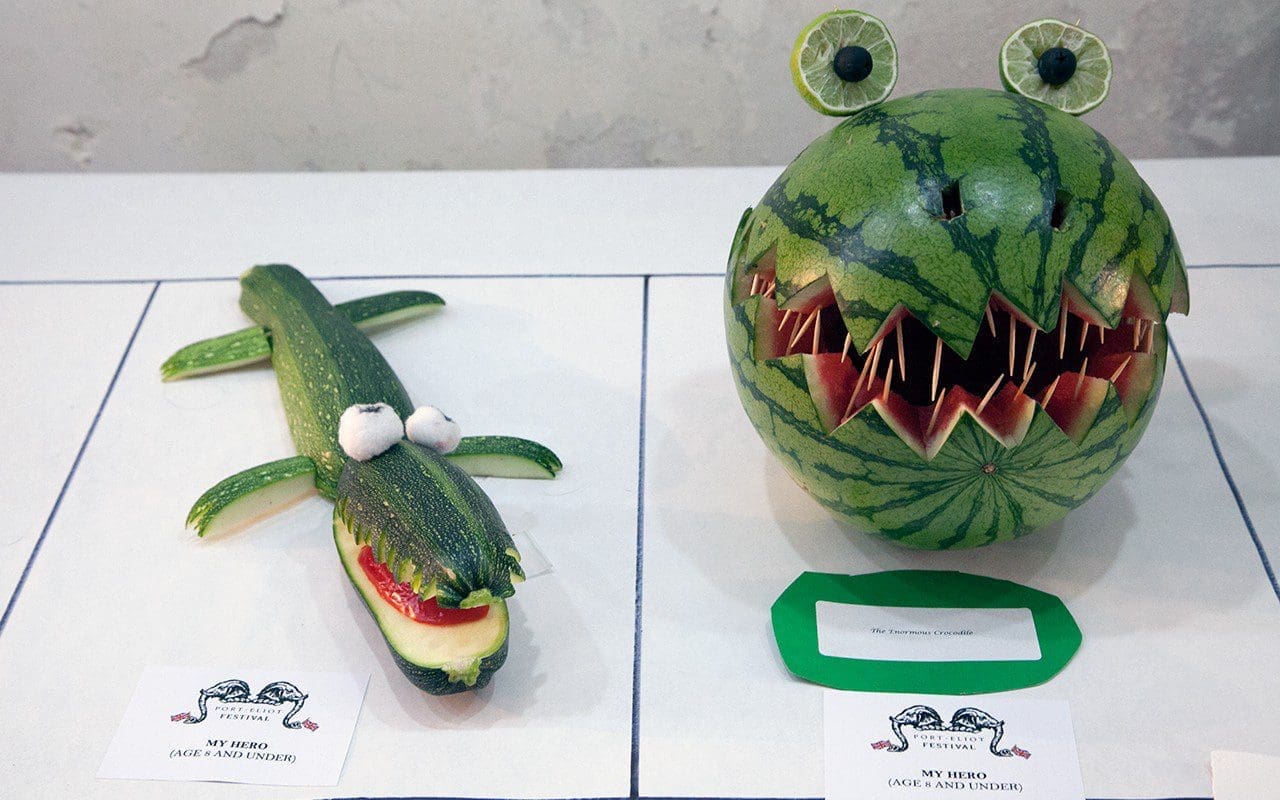
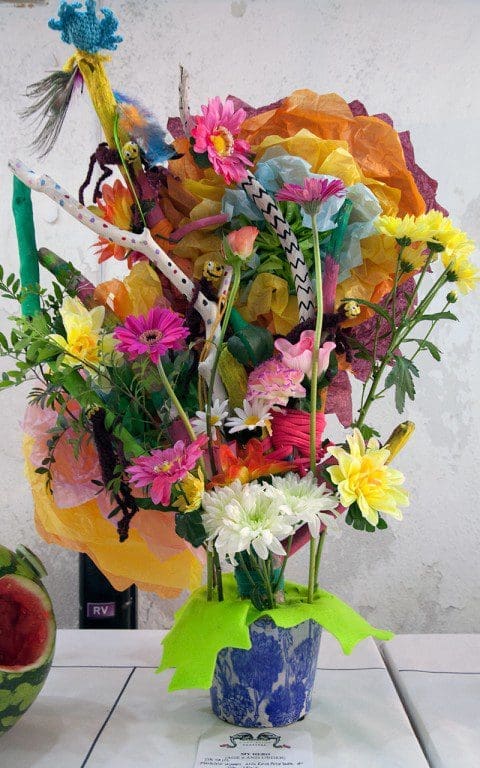 Entries in the ‘My Hero’ class
Entries in the ‘My Hero’ class
We finished by moving out into the light again to the banks by the house to judge the scarecrow competition. Ancient Magnolia grandiflora pressed themselves tight to the walls of the house and great billowing clouds furnished the sky above us. This year’s theme was Angels and Devils. My favourite scarecrow was of Boris Johnson, complete with mop of straw hair and a Brexit badge. It felt like he had found an appropriate and fitting home for himself.


 Entries in the Scarecrow class
Entries in the Scarecrow class
This year’s was a particularly meaningful festival, because Perry (Peregrine Eliot, 10th Earl of St. Germans) was buried little more than a day before it opened. It was extraordinary timing on his part and, given that he and Cathy have always been the most generous of hosts, exceptionally fitting and true to his spirit that the party simply continued.
 Festival Director, Cathy St. Germans
Festival Director, Cathy St. Germans
Words: Dan Pearson / Photographs: Huw Morgan
It is 13 years since Michael and Angela Cronk approached me to come and look at the Georgian rectory they had recently bought in the Windrush Valley in the Cotswolds. Initially they only wanted me to advise them on replacing the plantings but, after some discussion, I suggested it should be a more involved exercise, which would mean taking apart the garden that was there before and starting again.
The existing garden had been laid out by Nicholas Ridley, the Conservative Party politician, and although a completely new garden was rather more than Michael and Angela had anticipated, they were confident that a clean sweep was the best approach. Ridley had harnessed water from the river, which was fed across the site through a series of pipes (some of which even passed along the top of a miniature aqueduct) and used in a series of water features. The original bog garden was completely silted up and had been colonised by thickety willows, and some of the pipes that carried water to the canal were broken and had filled the cellar a foot deep.

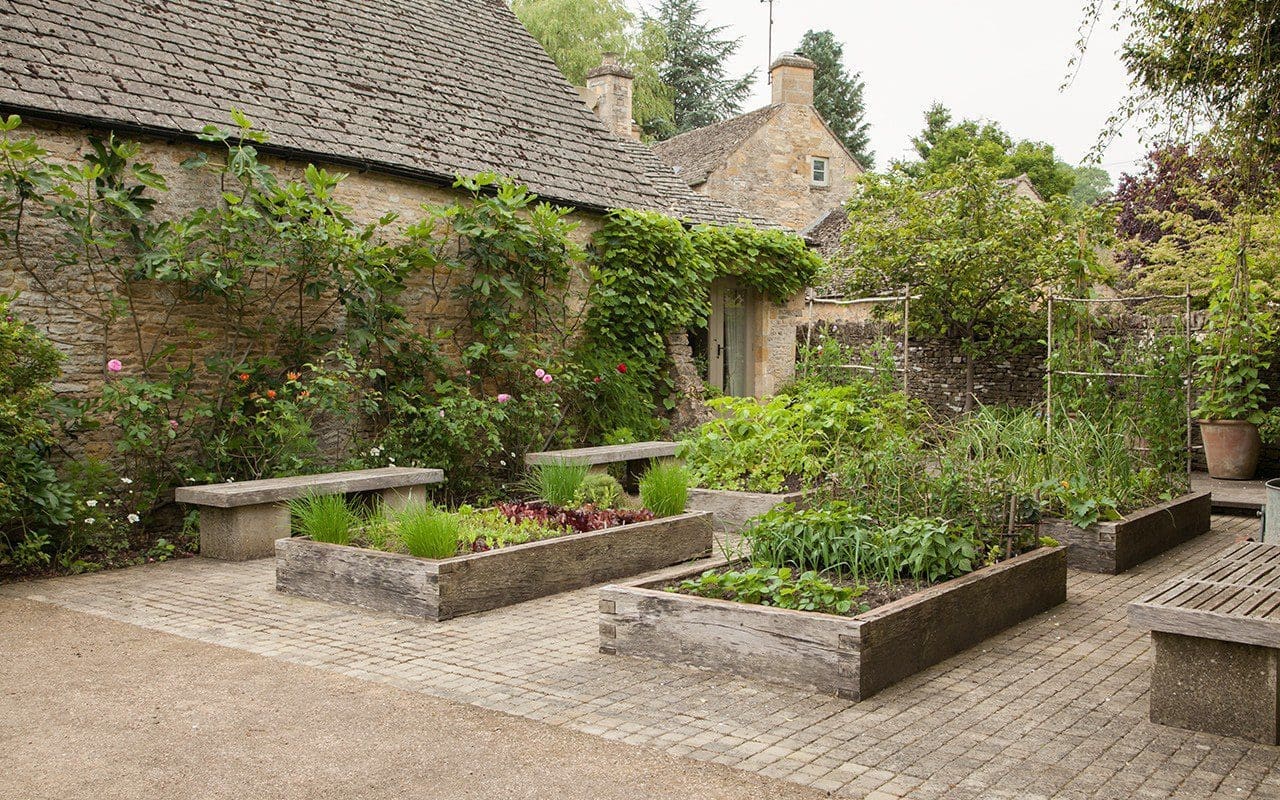
Steve Swatton, the landscape contractor who helped Cleve West win Best in Show for his garden at this year’s Chelsea Flower Show, and who was also responsible for creating all of Christopher Bradley-Hole’s Chelsea show gardens, was our impeccable contractor. With him we created a series of garden rooms that surround the house, which sits in the middle of a near perfect acre.
The original stone boundary wall was the inspiration for a series of new dry stone walls, which define each of the garden spaces. It was essential that these walls were beautifully built and, to that end, Steve employed some of the stonemasons who had worked with Andy Goldsworthy on his dry stone pieces. When they had finished the head stonemason told us that they had carved the initials of everyone involved in the garden’s making into stones in different parts of the garden and we spent several hours trying to track them all down. Arrow slots in the walls lined with green oak offer glimpses of the gardens beyond. These teasing views draw you through the space and make visual connections between the enclosures. Each garden’s planting is colour-themed to heighten the distinct mood of each.
Reached via a rose scented passage between two barns and the immaculate vegetable garden, the first garden area has a new pond at its heart made on the site of the original bog garden. It is open to the River Windrush on one side and was designed to elevate the contrast between fast running and still water by containing it within a clean stone elipse. There are shallow steps down to the river’s edge so that, on a hot day, you can dangle your feet in icy water. The pond is boldly planted with native and ornamental marginals including Osmunda regalis, Iris x robusta ‘Gerald Derby’, Darmera peltata, Rodgersia aesculifolia, Ligularia przewalskii ‘The Rocket’, Aruncus dioicus and white water lilies (Nymphaea alba). Ancient yews were our fortuitous legacy from a much earlier incarnation of the garden and they form a dark wrap around its perimeter.
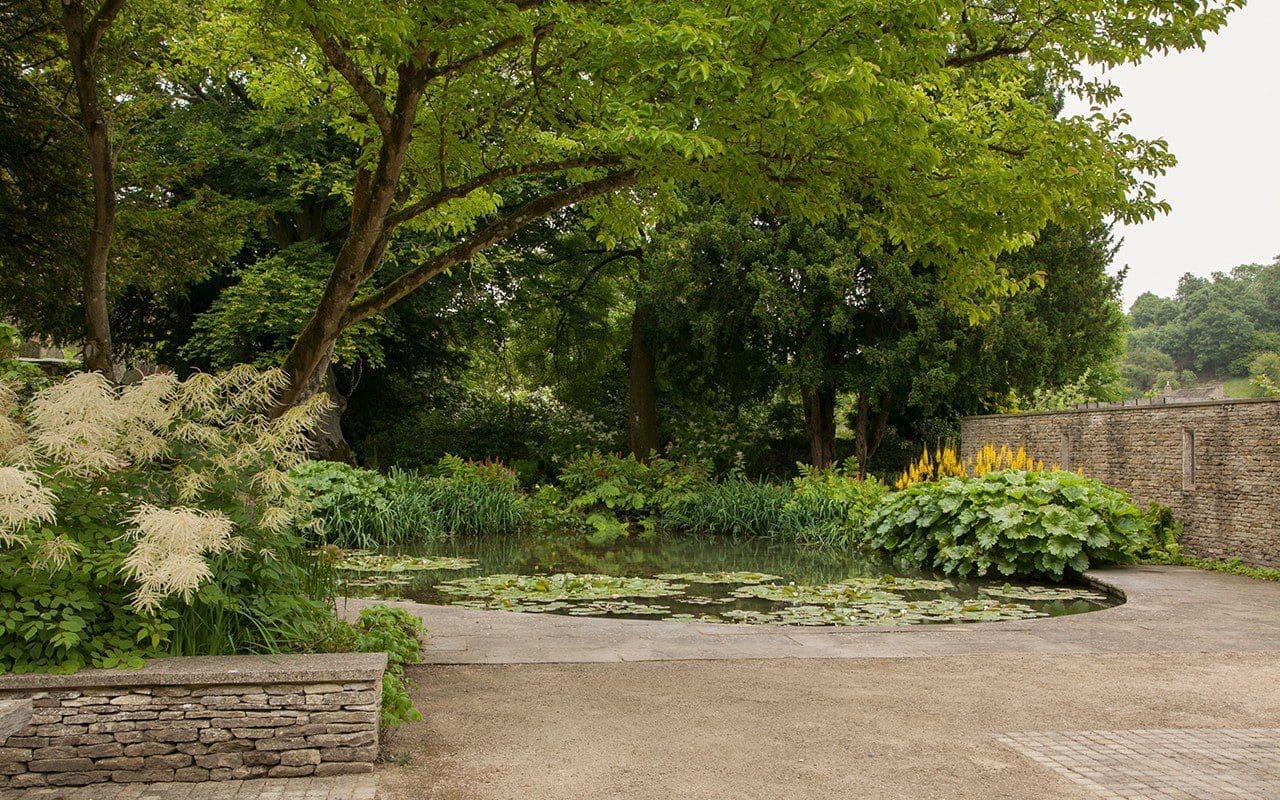
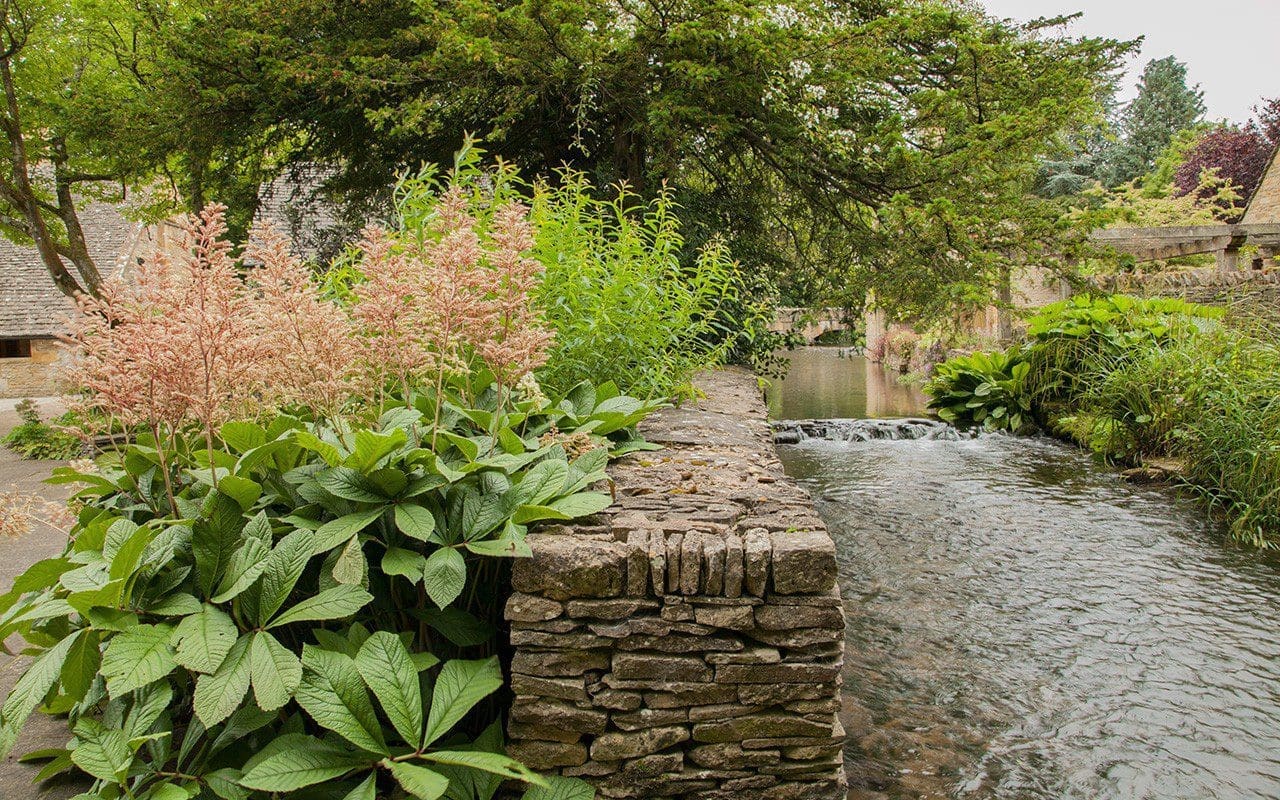
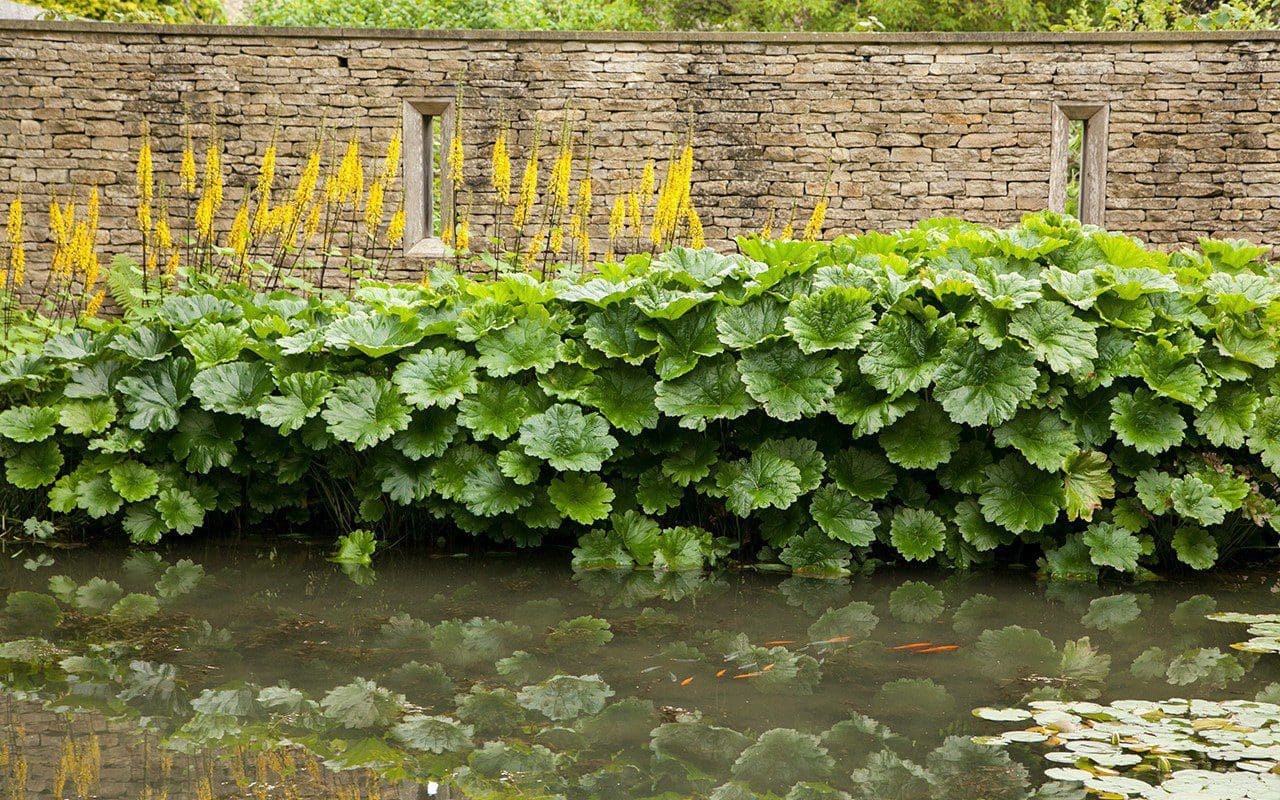
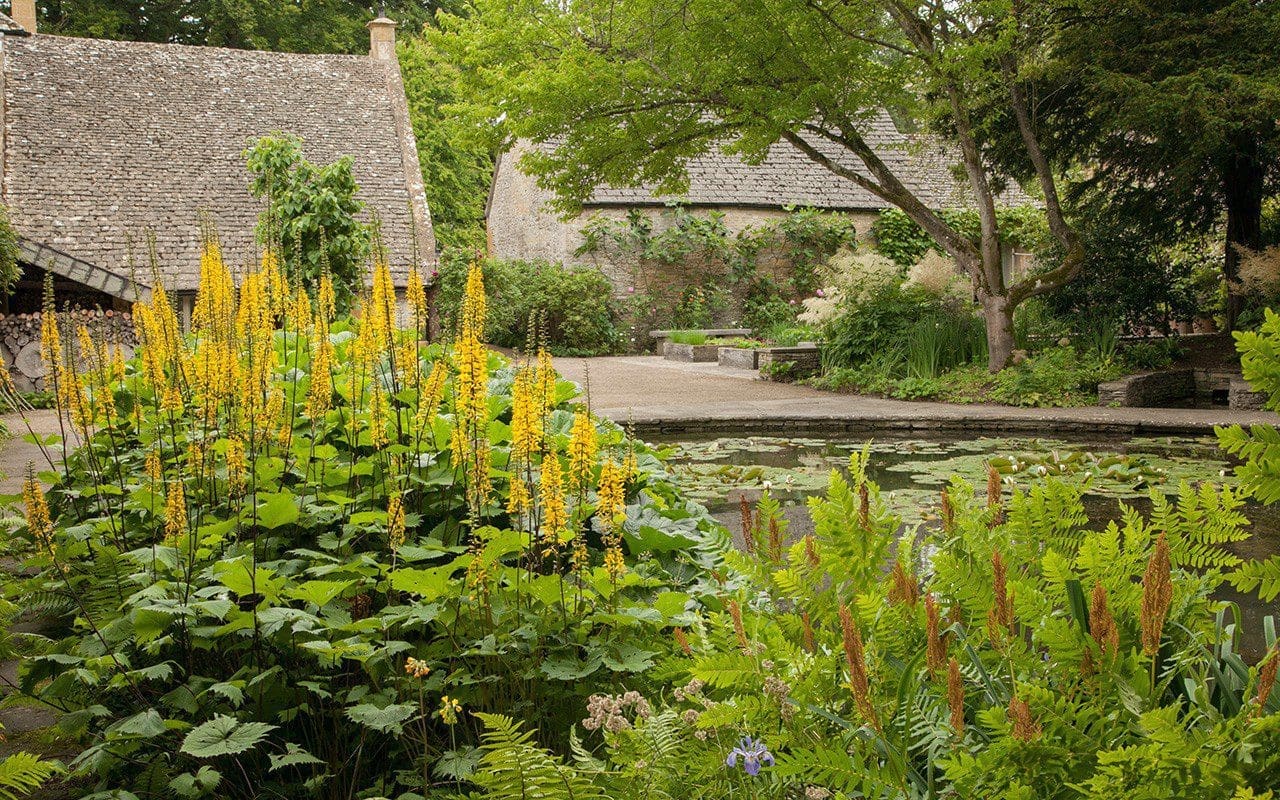
At the back of the pond a woodland walk planted with Sambucus nigra f. laciniata, Luzula nivea, Vinca minor ‘Gertrude Jekyll’ and Euphorbia amygdaloides var. robbiae leads you to the top of the Canal Garden, where the stone walls enclose a bench and support a pergola on which we are growing a white wisteria. The first one died mysteriously last year and so we are now trying with another. The bench faces the house and gives a view onto the upper half of the garden, which is planted in shades of white and yellow, including Hemerocallis ‘Hyperion’, Chamaenerion angustifolium ‘Album’, the white rosebay willow herb, Selinum wallichianum and white astrantia. Solid structure is supplied by twelve hefty pudding-shaped clipped box.
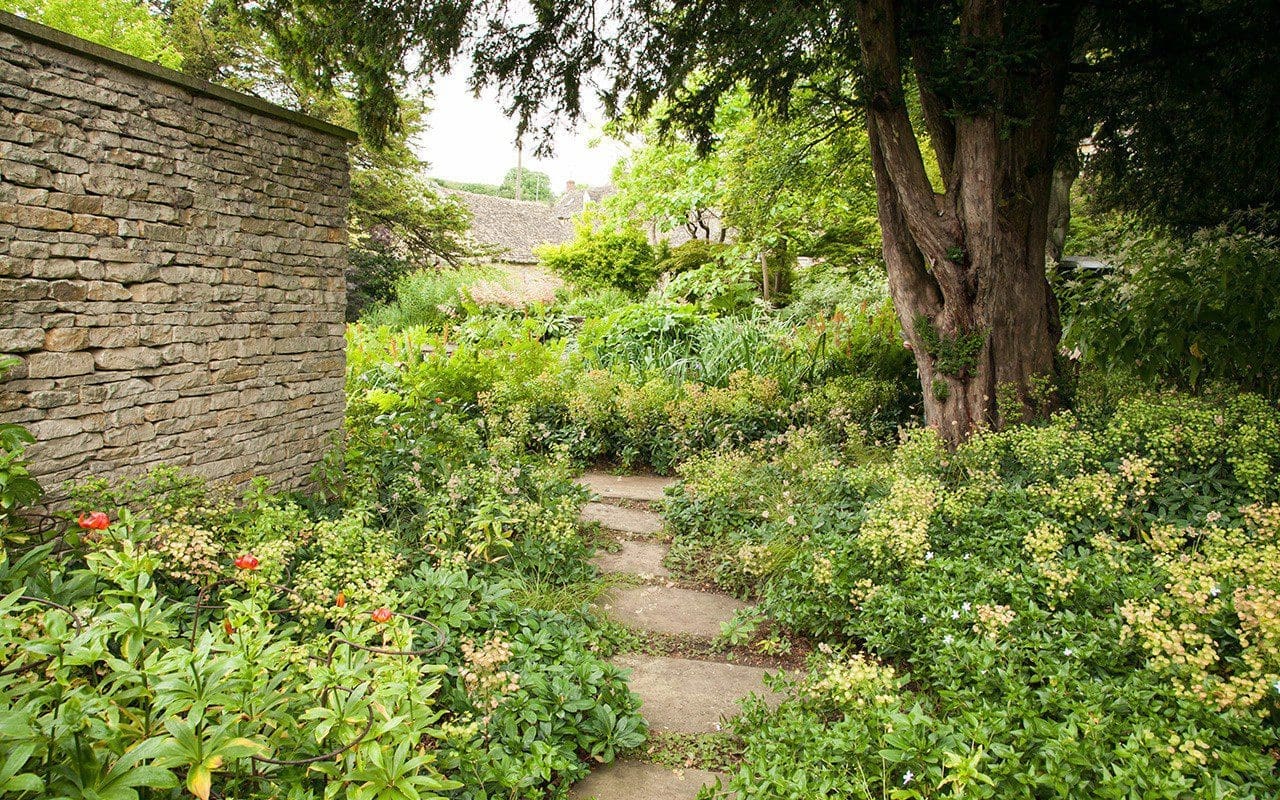
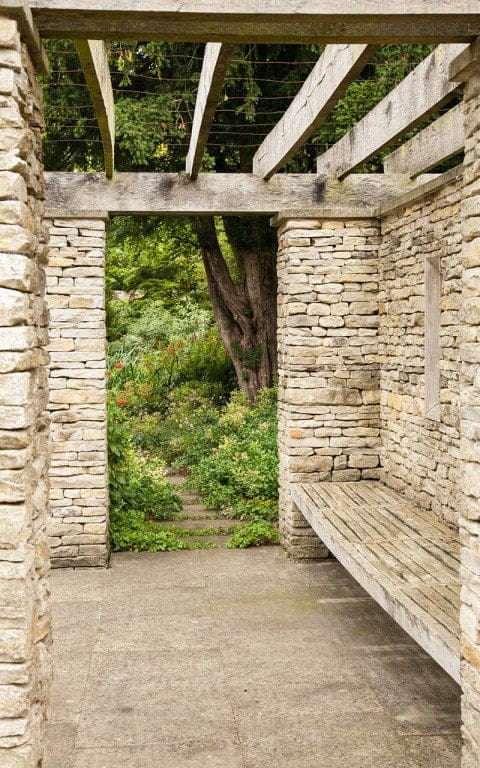
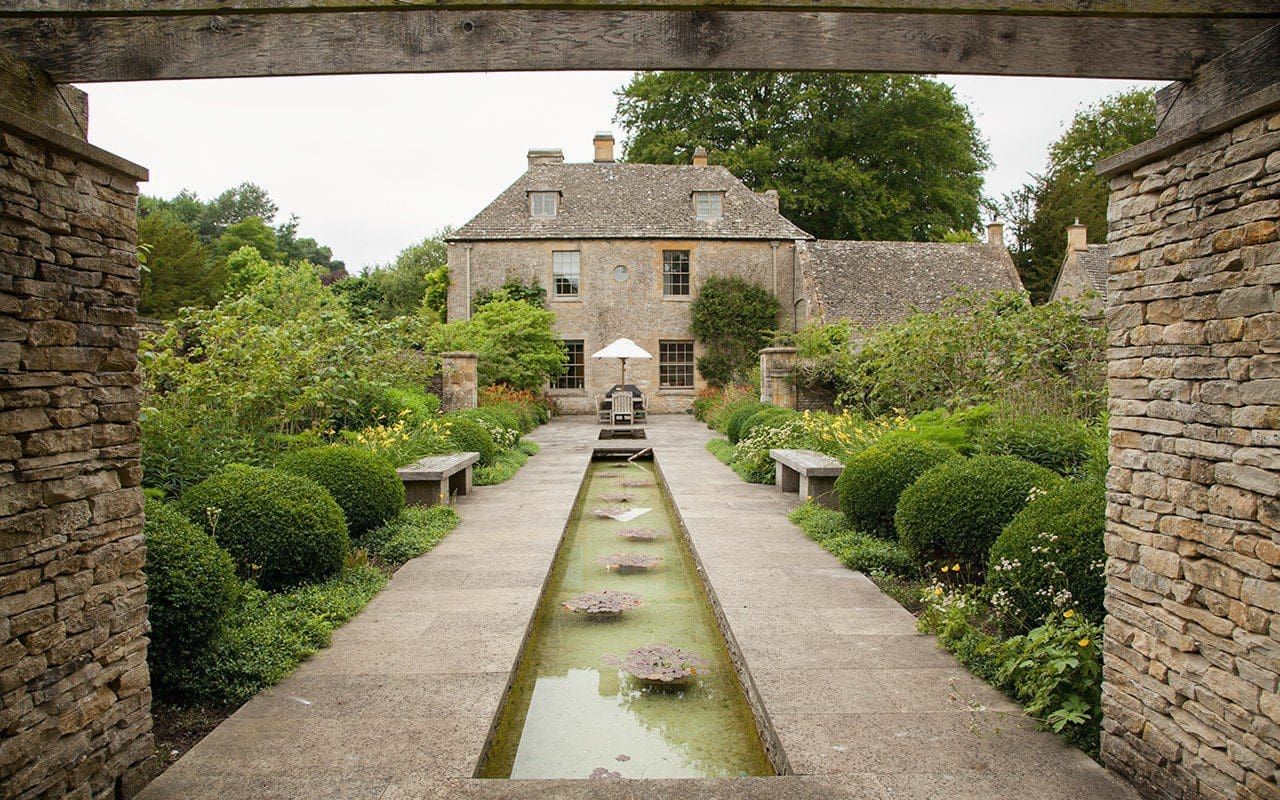
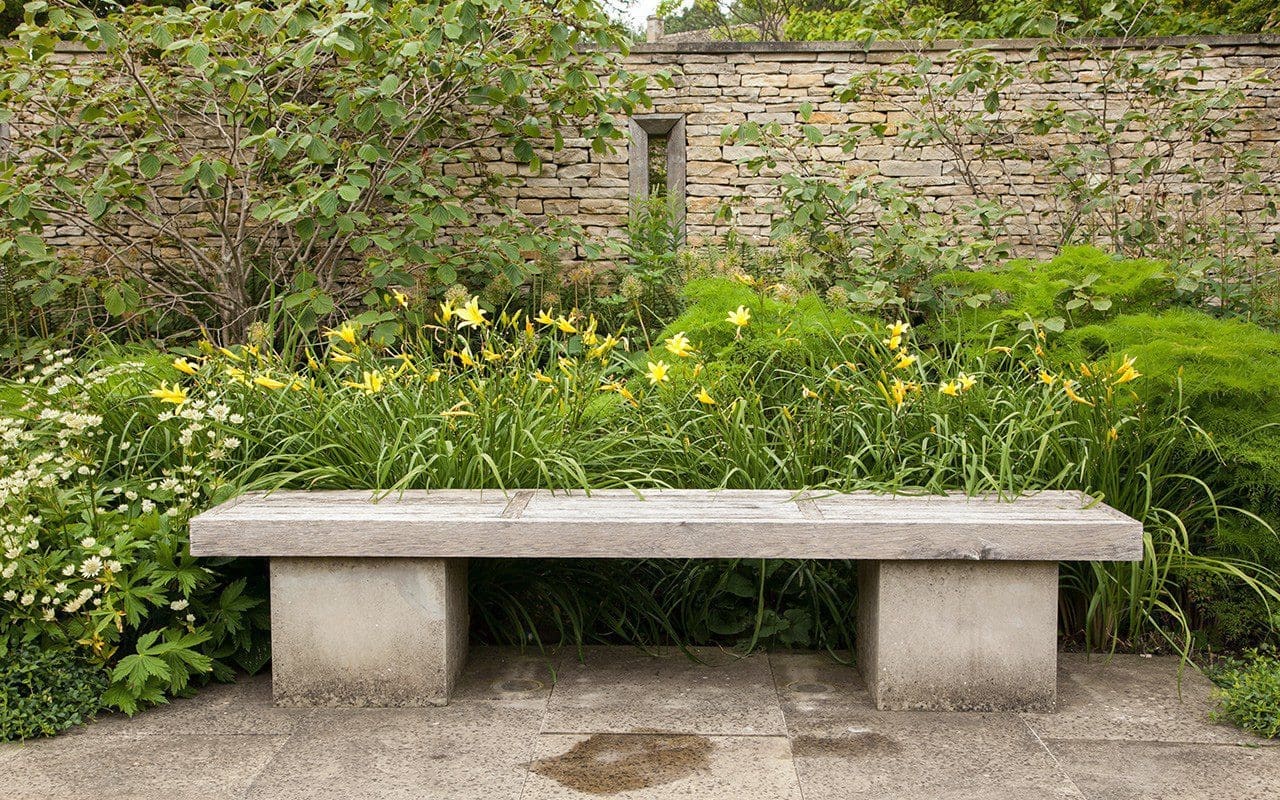

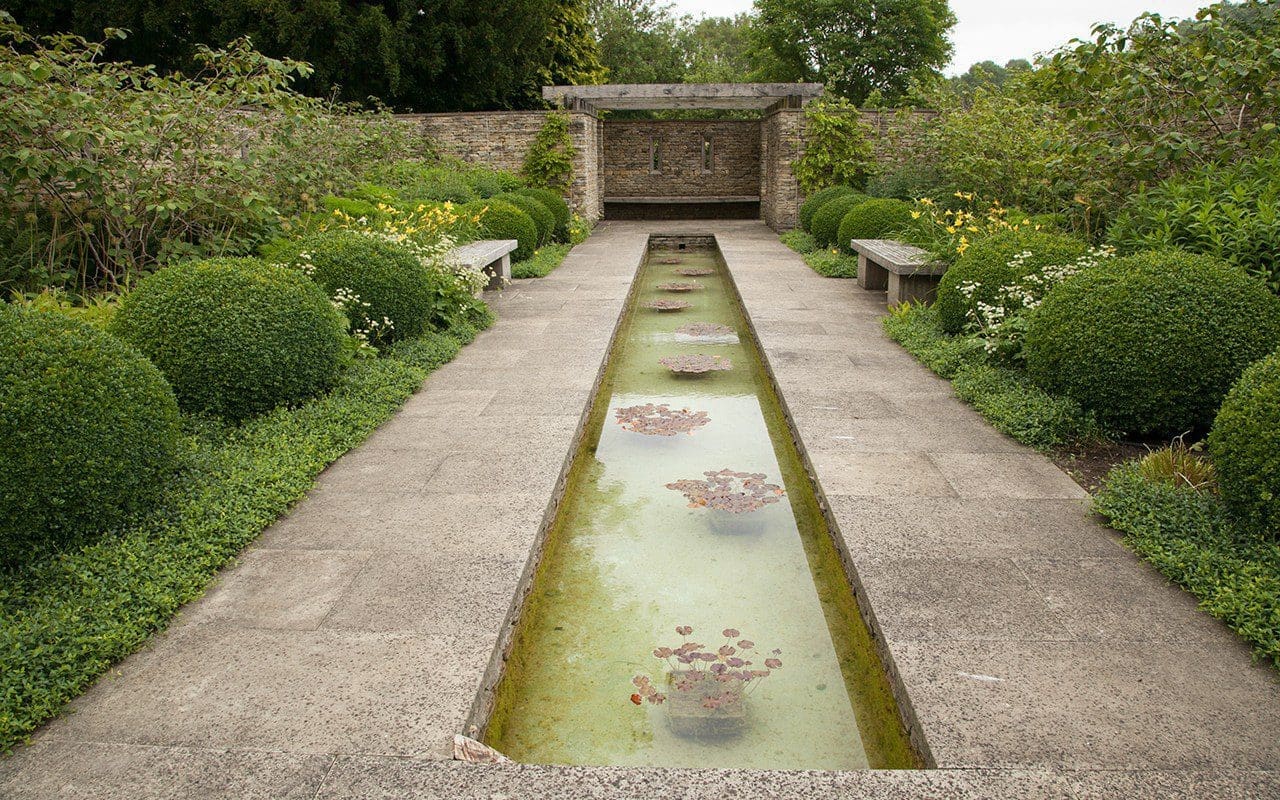
From here you have a choice to explore the far end of the Canal Garden in front of the house, or continue on the boundary circuit which passes through a small nuttery where slabs set into the grass lead you to the top of the swimming pool. Here a stilted, clipped hornbeam hedge shades a wide stone seat with a background planting of white-flowered and scented Choisya ternata and Clematis ‘Marie Boisselot’.
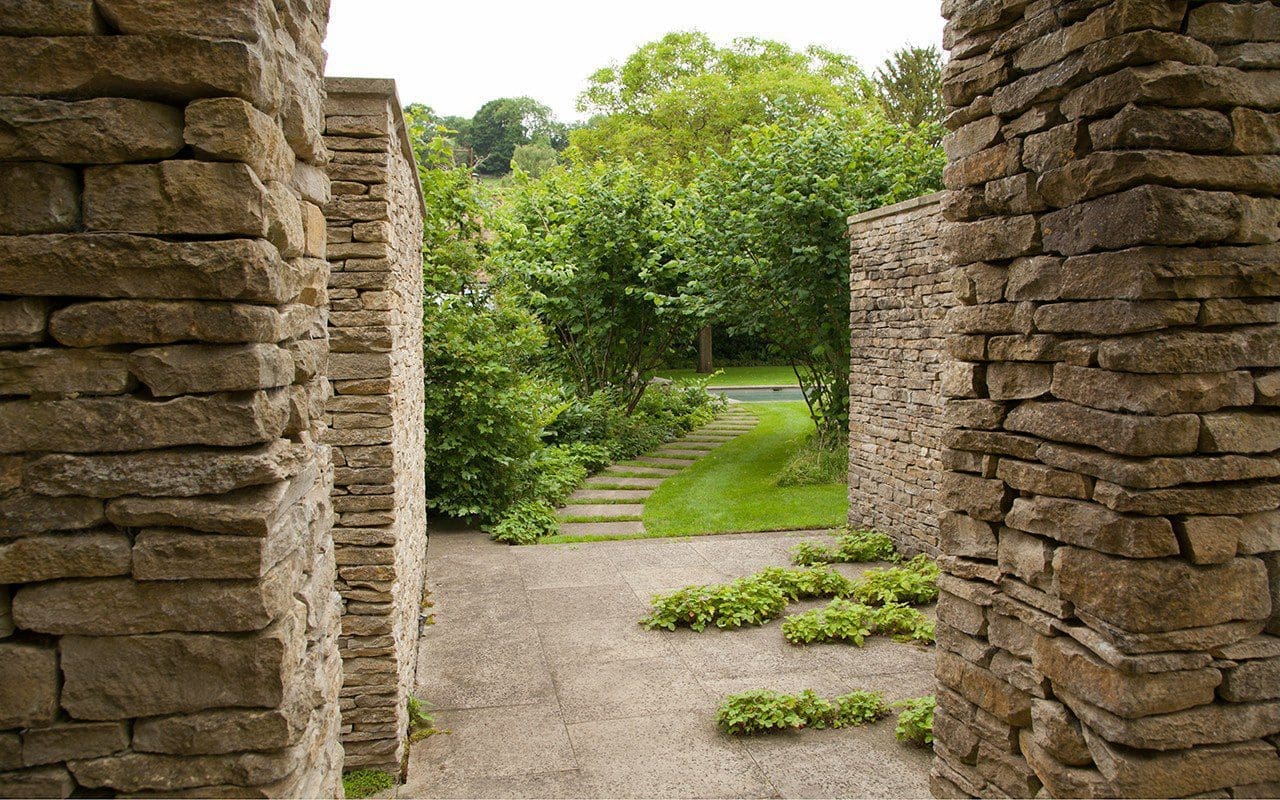

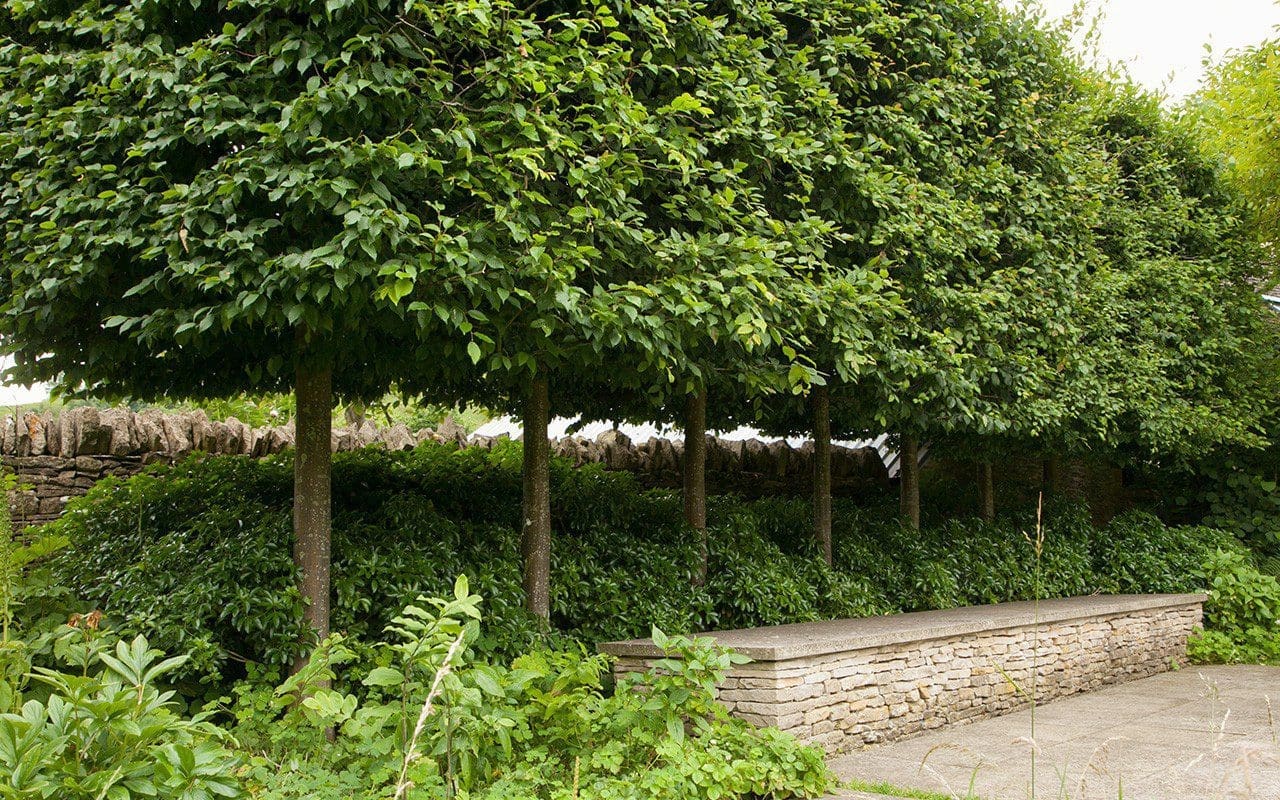
The swimming pool is set in an immaculate lawn with panels of wildflowers into which a number of apple cultivars have been planted. The lawn that was originally in this location is purported to be the one on which Lewis Carroll based the Croquet Lawn in Alice’s Adventures in Wonderland, as he was a friend of the rector and a frequent visitor.
The pool is lined with ceramic tiles the same colour as the stone-tiled roof of the house, giving the water a more recessive sea-green hue than the usual turquoise, which always looks harsh in a British garden. Beyond the pool the Yew Walk takes its name from the line of ancient yews planted against the boundary wall. The trunks were originally cleared of any lower growth to show them to their best advantage. The decidedly tricky area of dry shade beneath them is planted with tough evergreens such as Hedera helix ‘Poetica arborea’, Luzula sylvatica ‘Marginata’ and Dryopteris filix-mas.
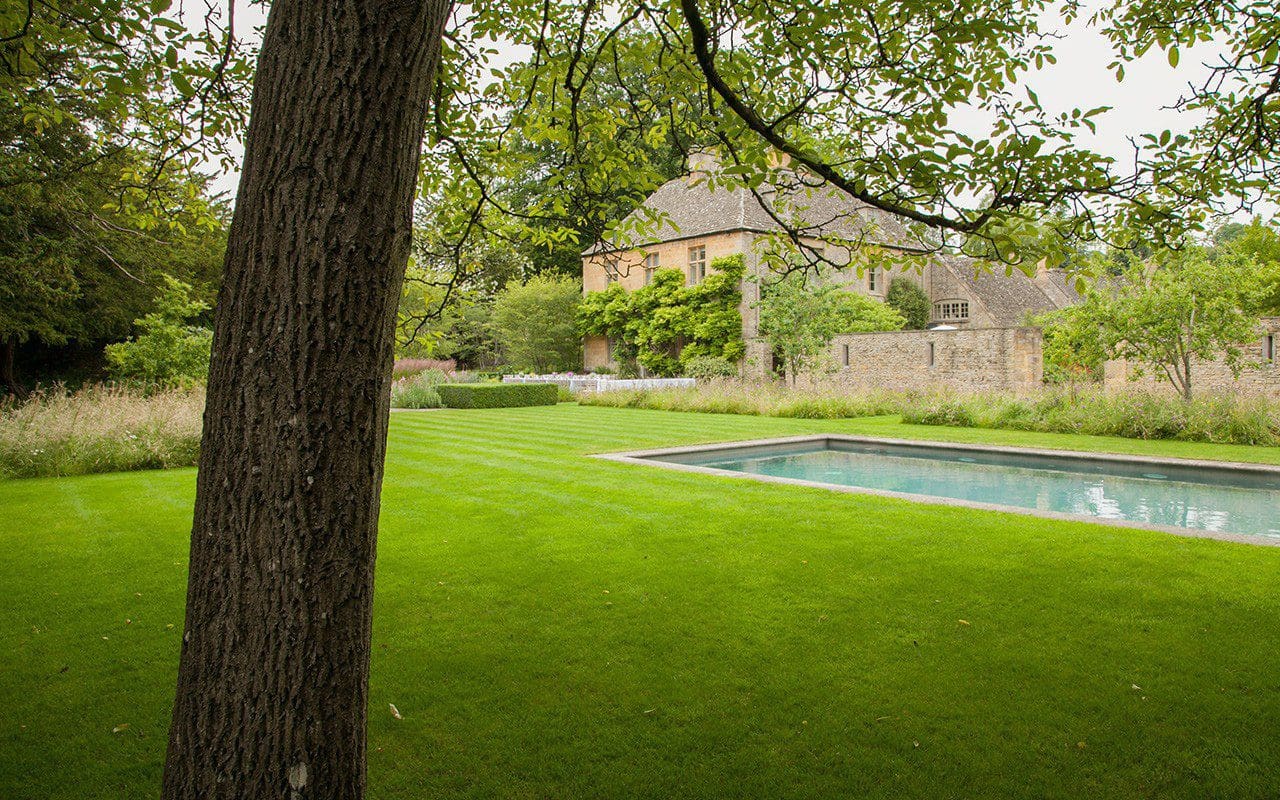
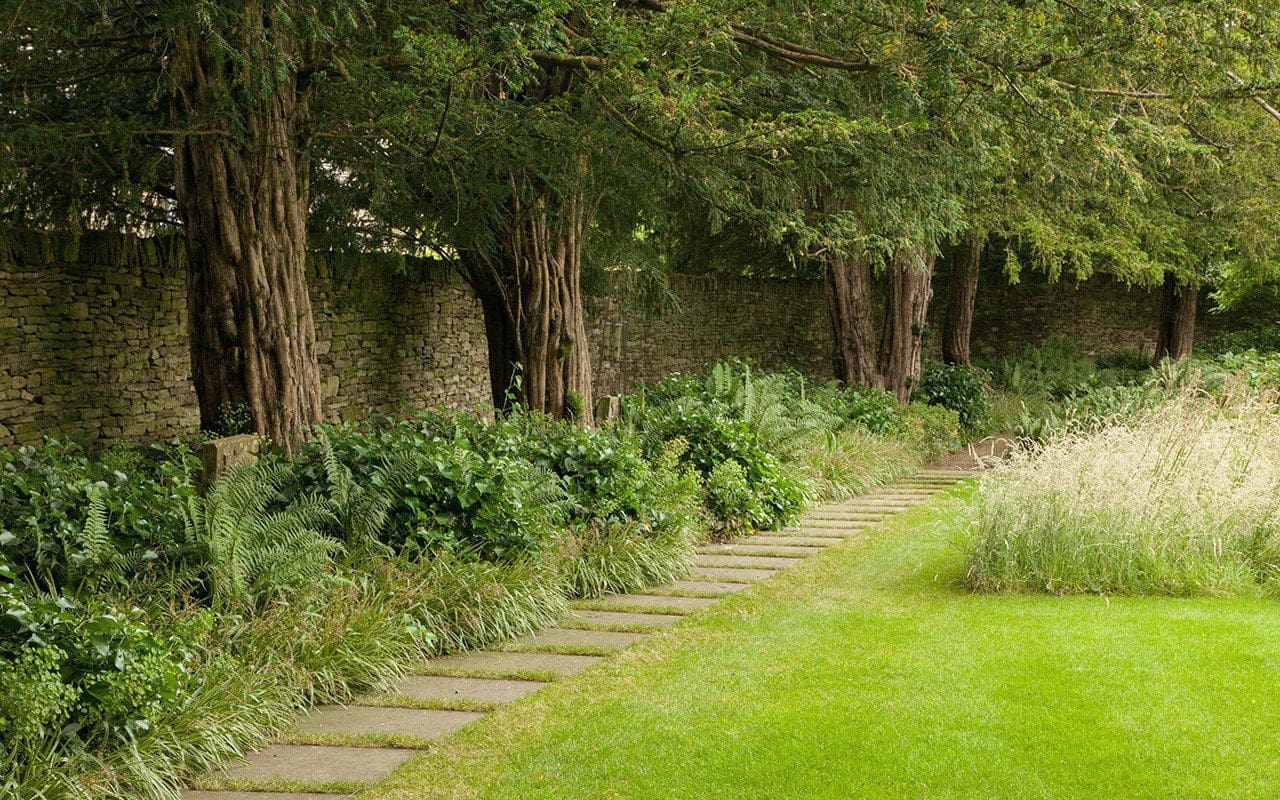
At the end of the Yew Walk the Southern Terrace is punctuated with a number of low plinths of clipped box, which provide a counterpoint to rhythmic plantings of Calamagrostis x acutiflora ‘Karl Foerster’ of exactly the same dimensions. This rectilinear structure, one vertical and static, the other horizontal and mobile, is overlaid with a light and delicate planting in shades of mauve, blue and pink. In the open this consists of of dry-climate plants including Dierama pulcherrimum, Echinops ritro ‘Veitch’s Blue’, Verbena bonariensis, Dianthus carthusianorum and Salvia verticillata ‘Purple Rain’. The shadier side includes Rosa glauca, Veronicastrum virginicum ‘Lavendelturm’, Geranium ‘Patricia’, Thalictrum rochebrunianum, Aconitum ‘Spark’s Variety’ and, for later in the season, Anemone hupehensis var. japonica ‘Splendens’. Towards the front of the house three of the box plinths have multi-stemmed Amelanchier lamarckii growing from their centres. As well as holding the corner of the house these volumes provide both a backdrop and a screen for the seating terrace.
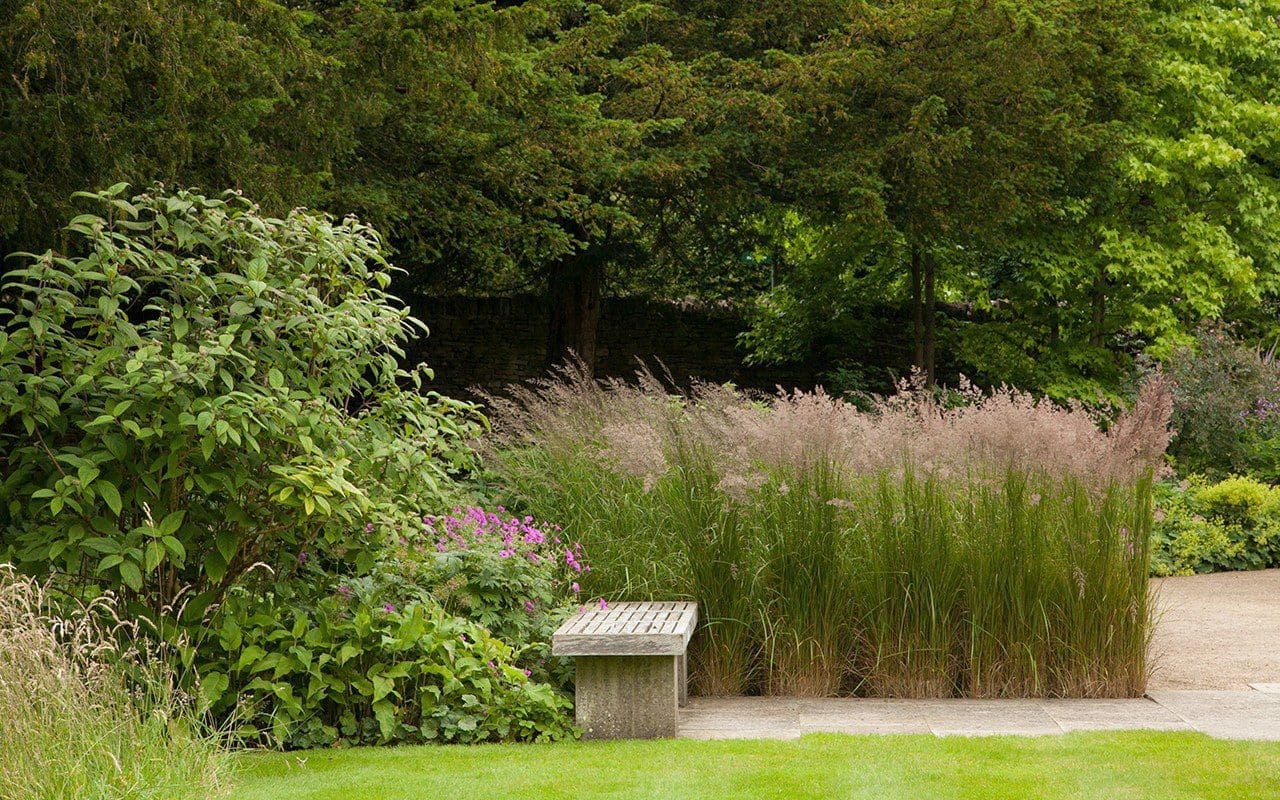
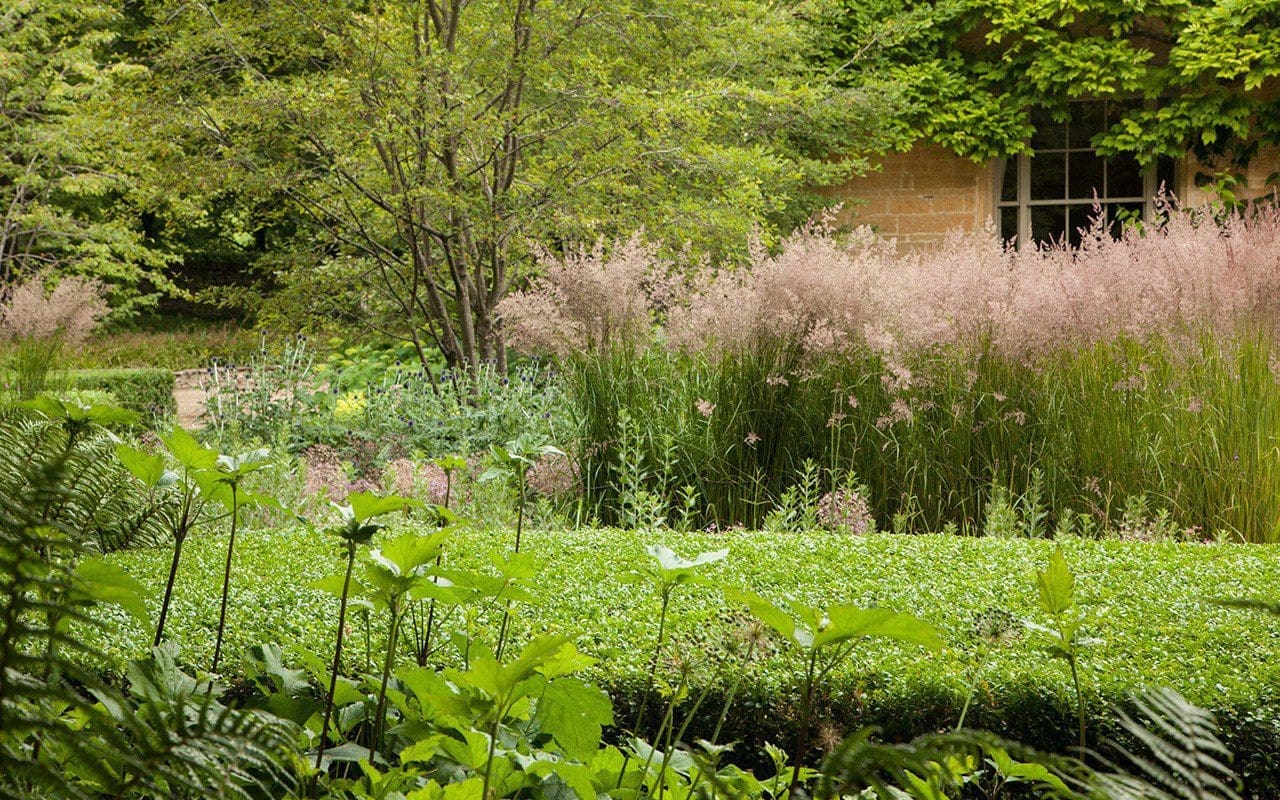
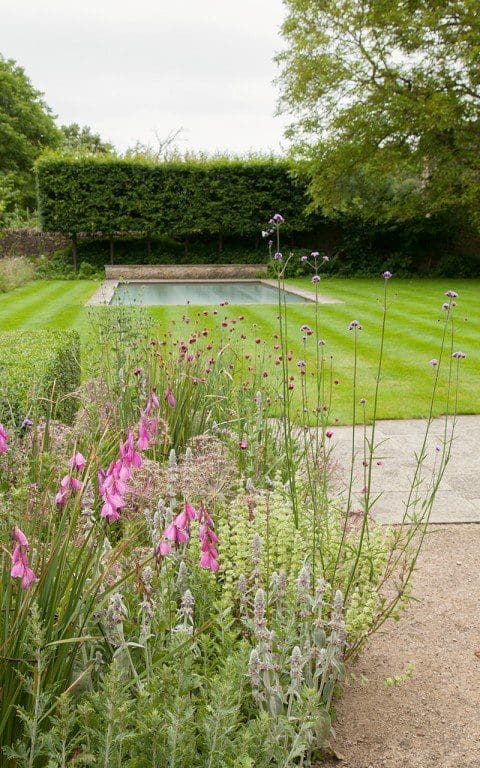
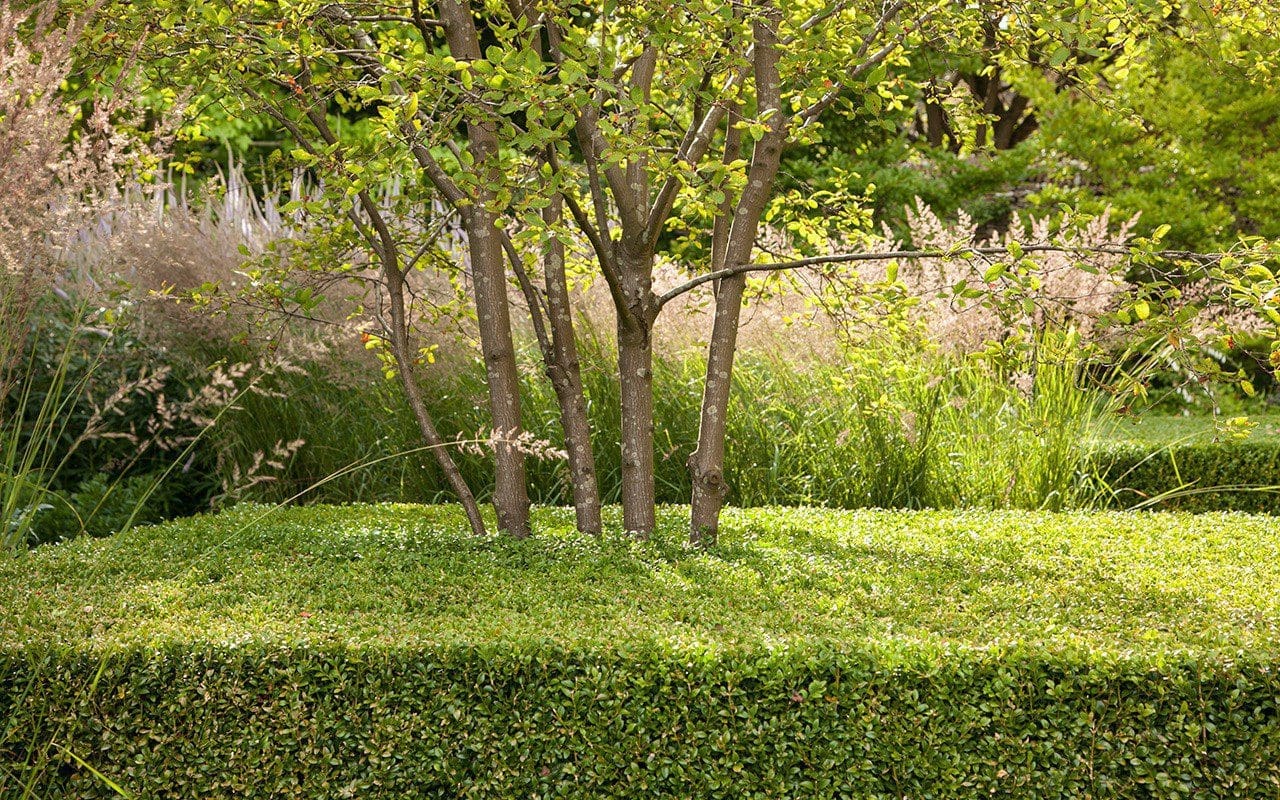
Returning to the back of the house via the wildflower meadow and then through a slot in the dry stone wall you pass beneath the spreading limbs of a Cercis siliquastrum ‘White Swan’ and arrive in the lower half of the Canal Garden. The richly coloured planting scheme here was inspired by Angela’s request to have some Fuchsia magellanica somewhere, a reminder of the summer lanes of her native Ireland. These are wall-trained and underplanted with Astrantia ‘Hadpsen Blood’ and Geranium ‘Patricia’. The beds to either side contain a succession of flowering perennials, shrubs and climbers in shades of scarlet, orange, yellow and bright pink including Persicaria amplexicaule ‘Taurus’, Clematis tangutica ‘Bill Mackenzie’, Sanguisorba officinalis ‘Tanna’, Hemerocallis ‘Stafford’, Knautia macedonica, Crocosmia ‘Lucifer’ and Potentilla fruticosa ‘Gibson’s Scarlet’.
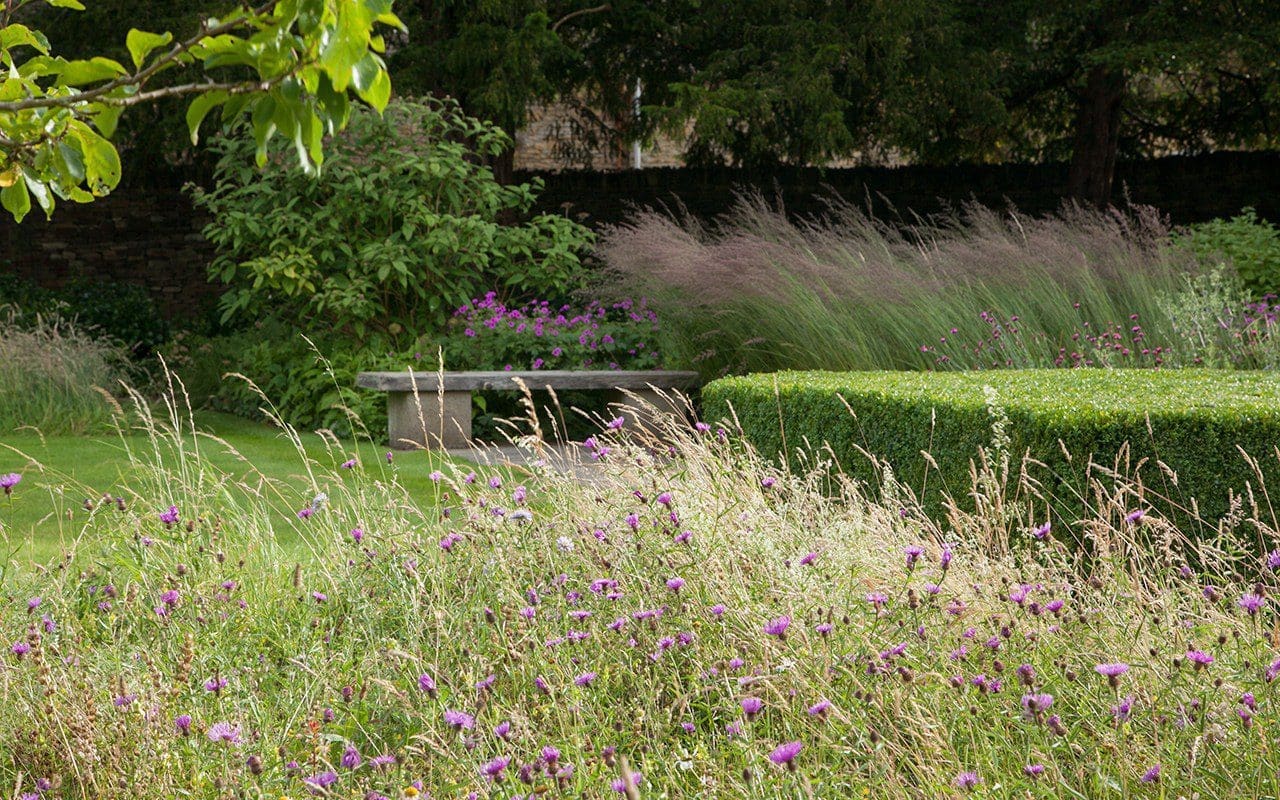
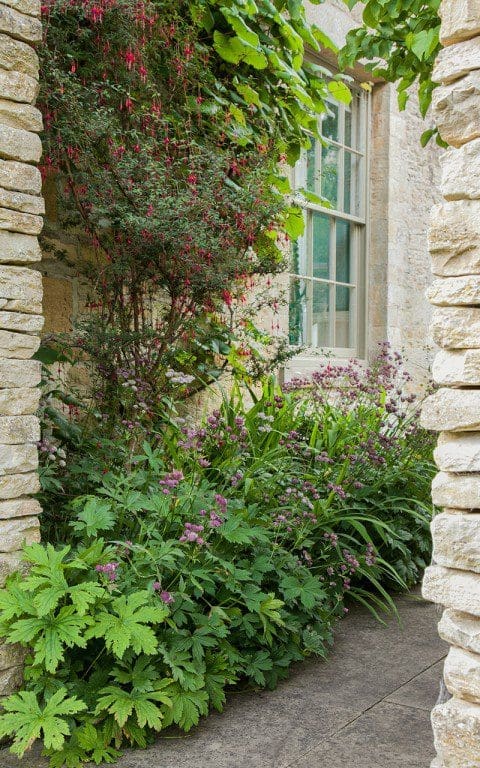
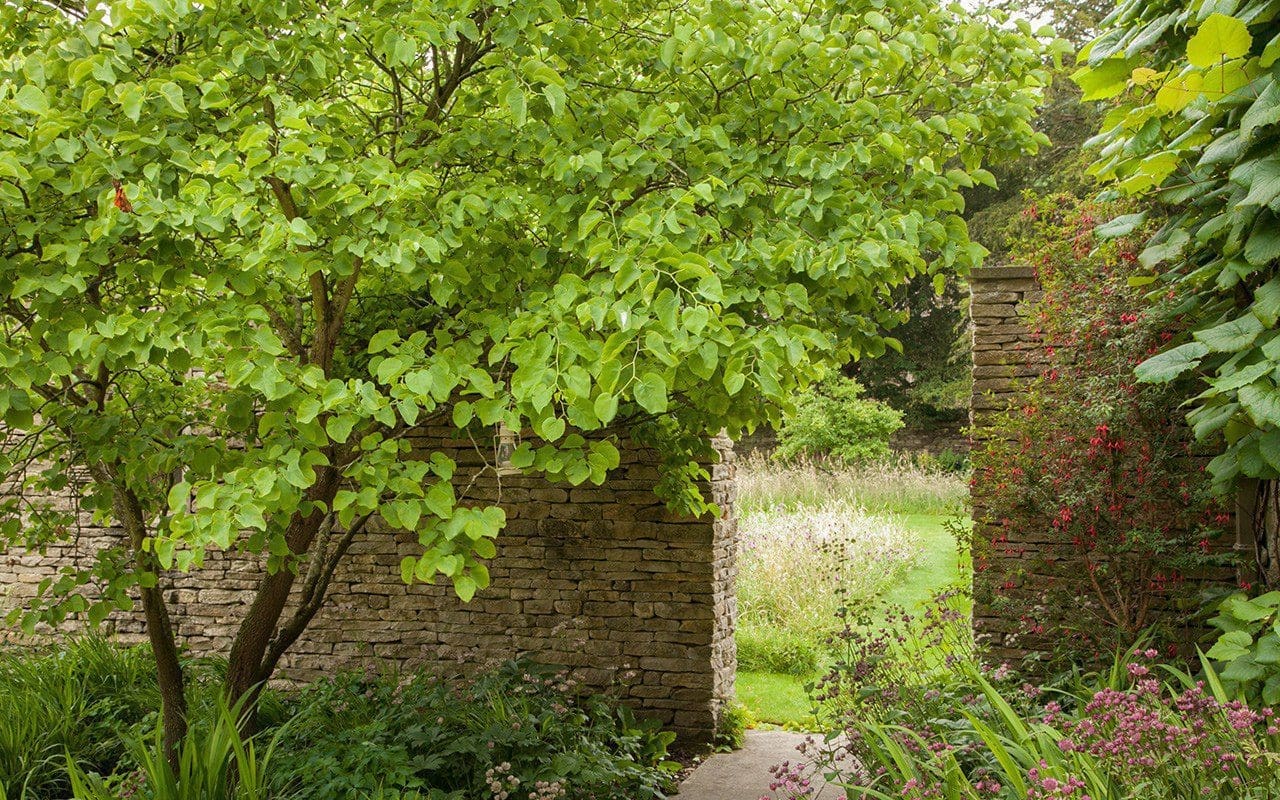
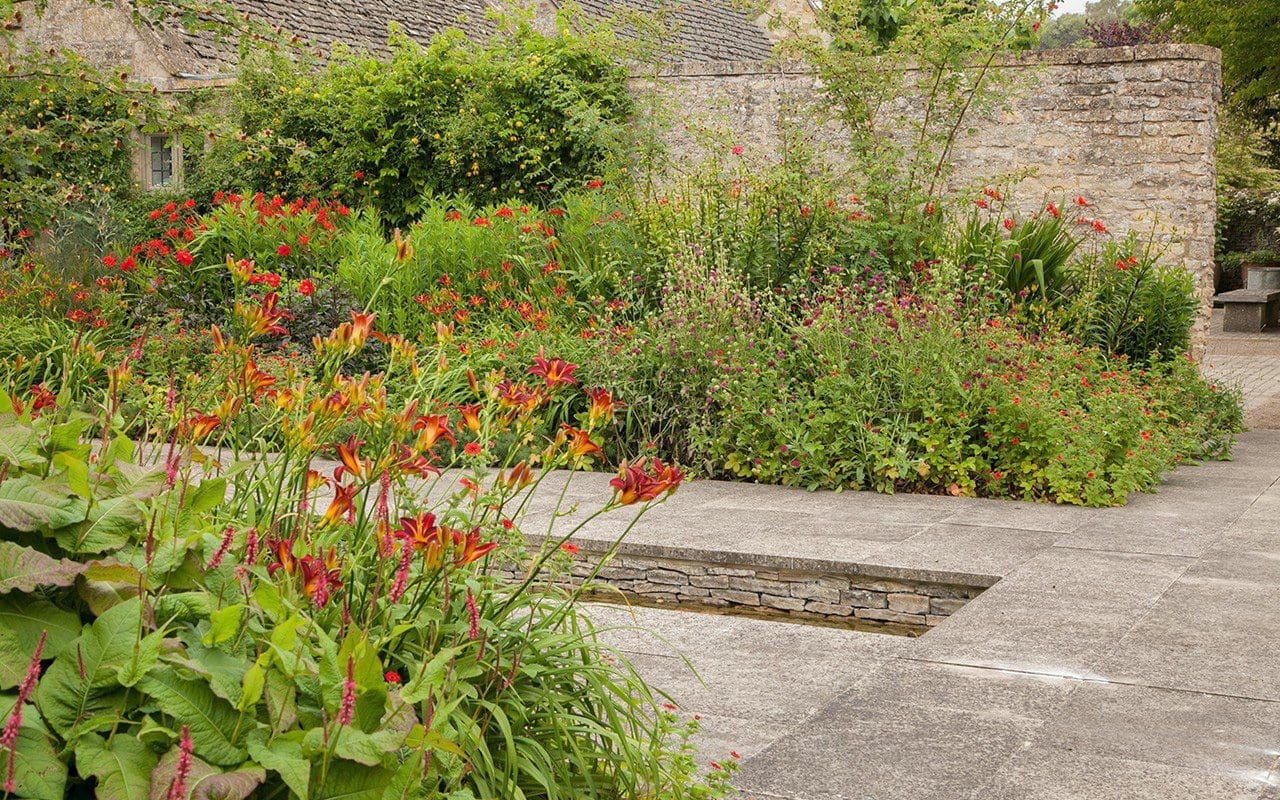

Michael and Angela have been some of our most generous and thoughtful clients and have been completely committed to the collaborative process and the importance of working with people who have the skills to make and maintain a garden like this. Jacky Mills was recommended to me by Fergus Garrett at Great Dixter, due to her keen eye for detail and strong work ethic. She and her partner, Ian, started working with me before the garden was complete and helped to plant it, which has given them a huge sense of investment and a deep understanding of the desired effect. Without them the garden would not be possible. They maintain the garden impeccably on two days a week and bring a lot to the table with their breadth of experience working, as they have, for other designers like Arne Maynard and Sarah Price. They are now helping me with the garden at Hillside.
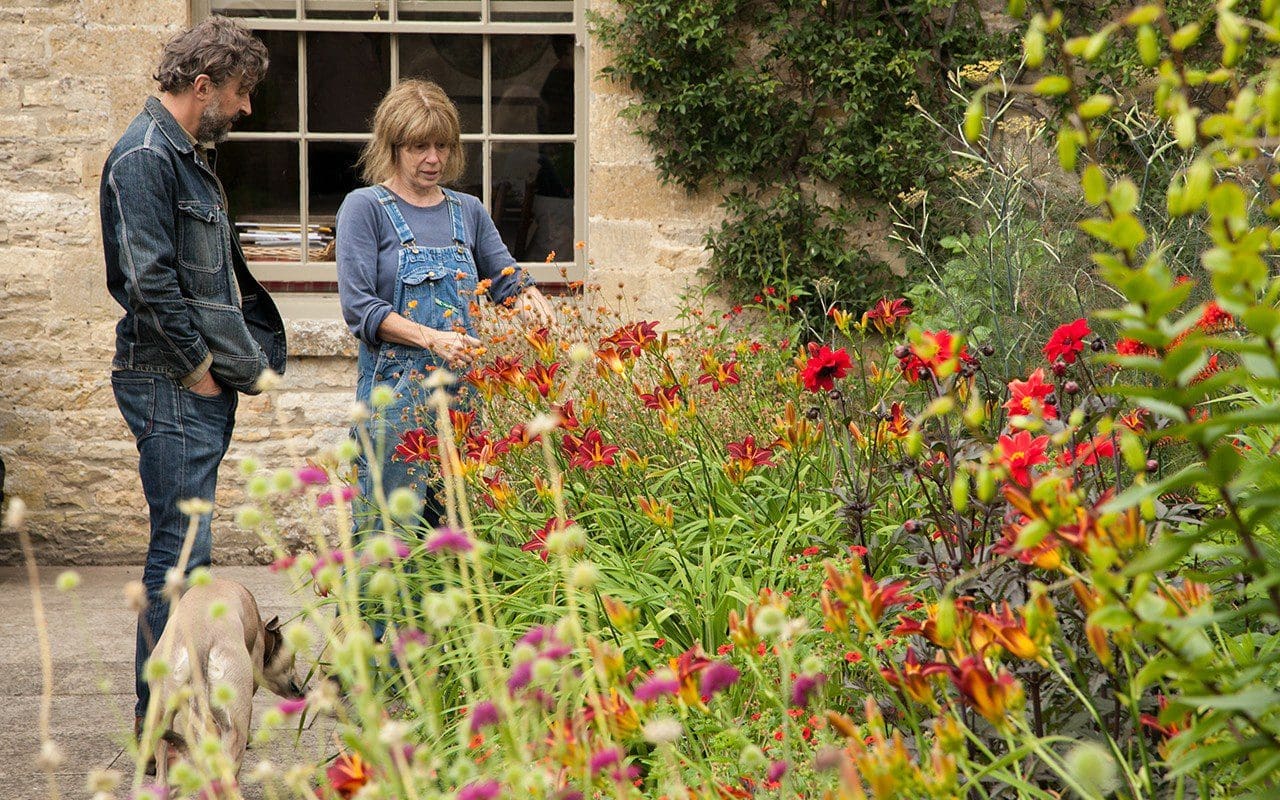
Michael and Angela had the idea to hold a garden party for Jacky and Ian and their friends and colleagues including other designers and gardeners from local and notable west country gardens and so, last week, we spent a magical afternoon chatting, wandering and eating in the garden, in a way that allowed everyone to relax and really feel part of the space.
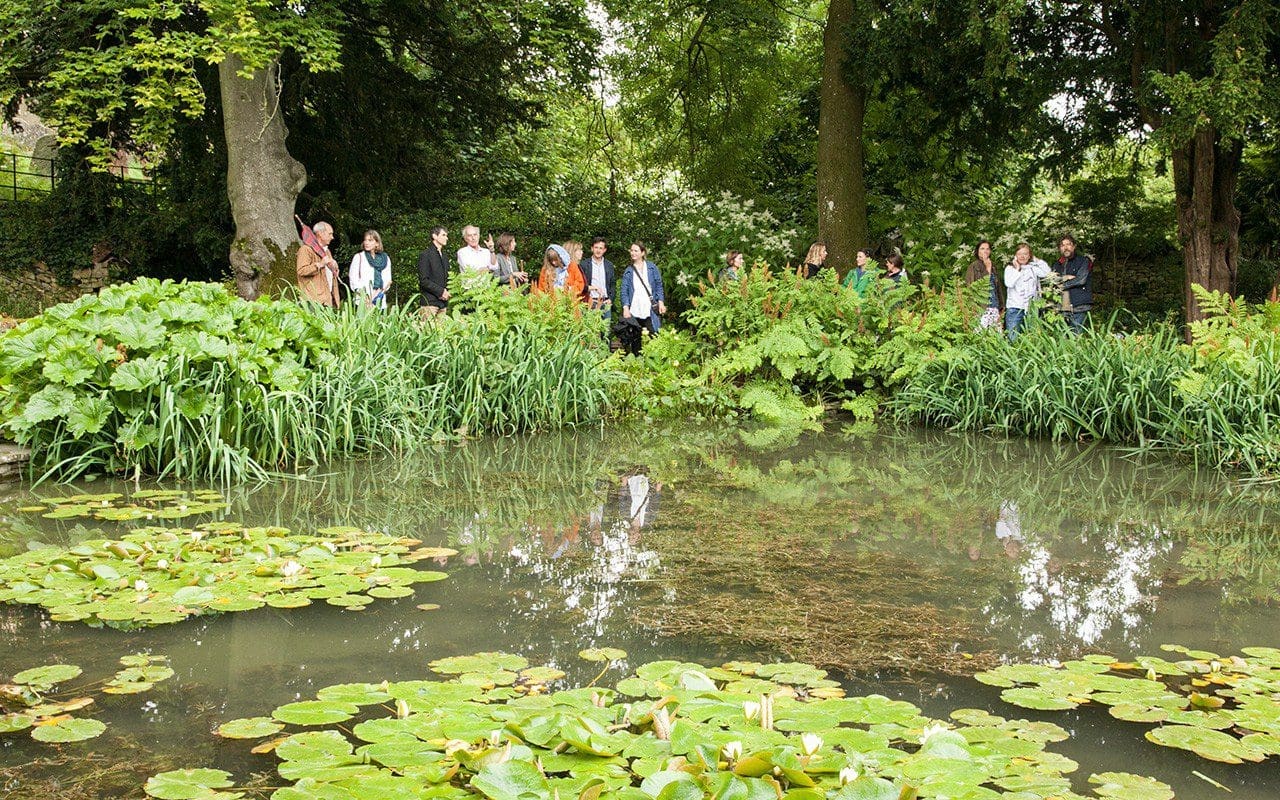
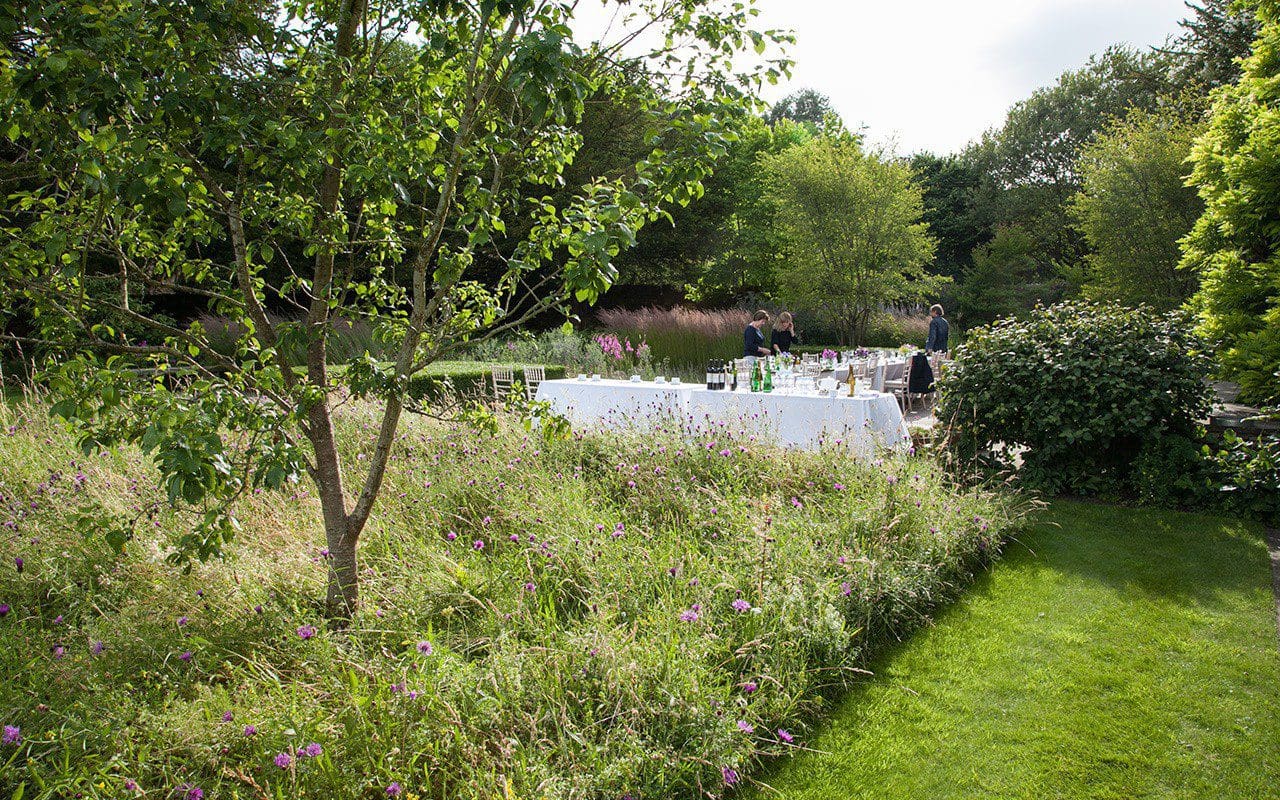
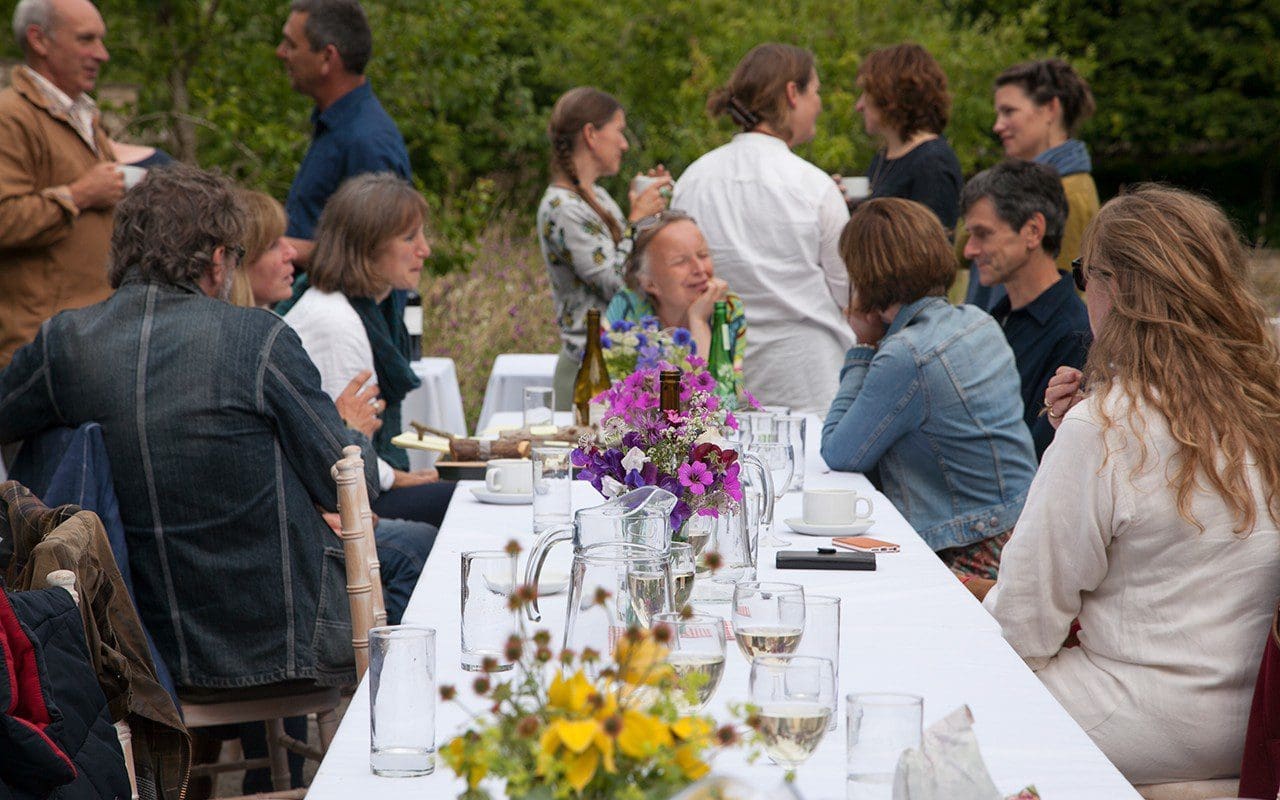 Words: Dan Pearson / Photographs: Huw Morgan
Words: Dan Pearson / Photographs: Huw Morgan
This week has been an important one. The digger men are here, carving out the new garden and shaping the land around the house. A great divide of mud has marooned us. Venture out in any direction and you are met by instability.
There is nothing like the crunch of a decision having to be made to focus the attention on what you really need to keep. I have been taking out roses in full bloom to make way for new paths. After holding on for as long as I could, it was strangely liberating. A running rudbeckia and the bolting boltonia are now on the compost heap. I’ve been curtailing their spread since they came here, despite knowing that they were trouble. The inulas that were grown from seed are sitting in a heavy un-liftable knot that was levered by the digger and covered with damp hessian ready to be divided and potted up this weekend. Their removal has tuned my mind to decide where I eventually want them.
In planning for this moment I planted a sanctuary bed that runs at the front of the house, locked in by the path. Most of the plants here were grown from seed. You care more for seed-raised plants somehow and their volunteer seedlings have shown that they like it in this spot. Today’s posy illustrates something of the transparency in the planting. I want to see through it, for it to be light and for it to shift against the weight of the walls of the house. Yellows and greens and browns are the backbone of the planting. Of the half dozen in the bunch, the greater number are umbellifers. They make wonderful companions in associations that are naturalistically driven and bring the same feeling into a bunch.
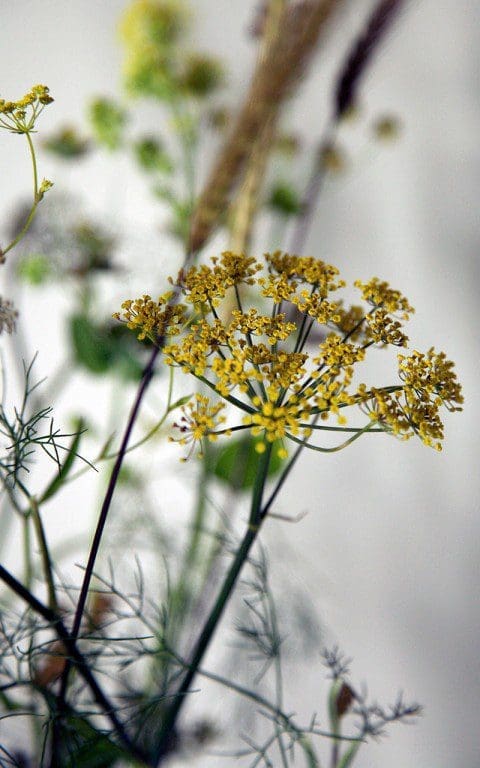 Foeniculum vulgare ‘Purpureum’
Foeniculum vulgare ‘Purpureum’
I have grown bronze fennel forever, liking the way it is from the moment its new growth pushes through to the point at which I have to cut away last year’s skeletons to make way for it. It loves our ground here, the sunshine and the free draining soil, so I only leave the plants standing over winter where I know the smoky haze of new seedlings can be managed. Now they are just showing flower, which has pushed free from the net of dark foliage. Foeniculum vulgare ‘Purpureum’ looks good with almost anything and I love the horizontality of the gold umbels when they mass more strongly later in the month.
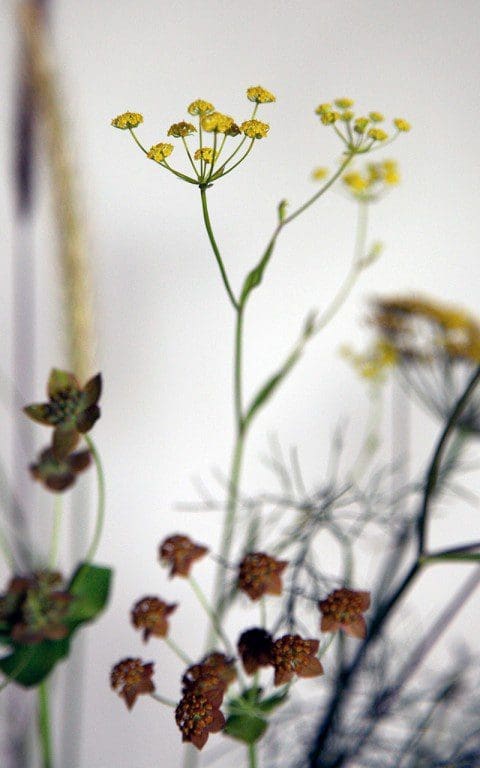 Bupleurum falcatum
Bupleurum falcatum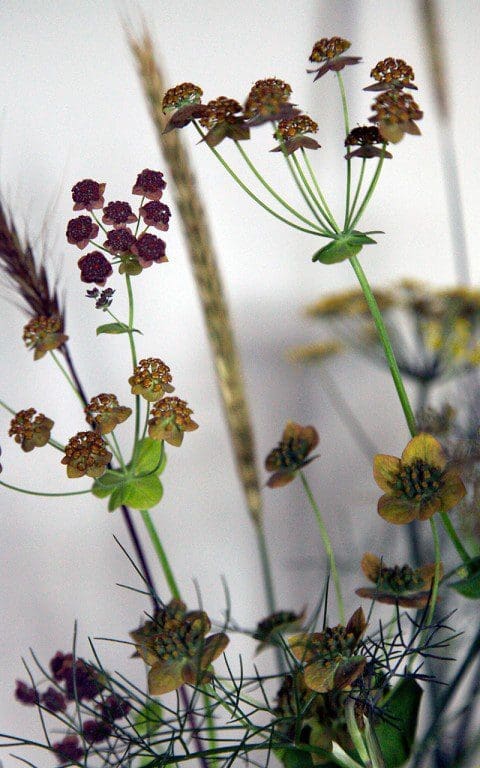 Bupleurum longifolium ‘Bronze Beauty’
Bupleurum longifolium ‘Bronze Beauty’
The acid-yellow umbel in the mix is the biennial Bupleurum falcatum. I threw fresh seed into the rubble around the barns and potted some up to plant them where I wanted them. They have just started to flower and will continue to form a bright cage of flower, so small and filamentous that it creates a haze of vibrancy. Bupleurum longifolium ‘Bronze Beauty’ is it’s perennial cousin. I shall write more on this later as it is an old favourite that deserves more time.
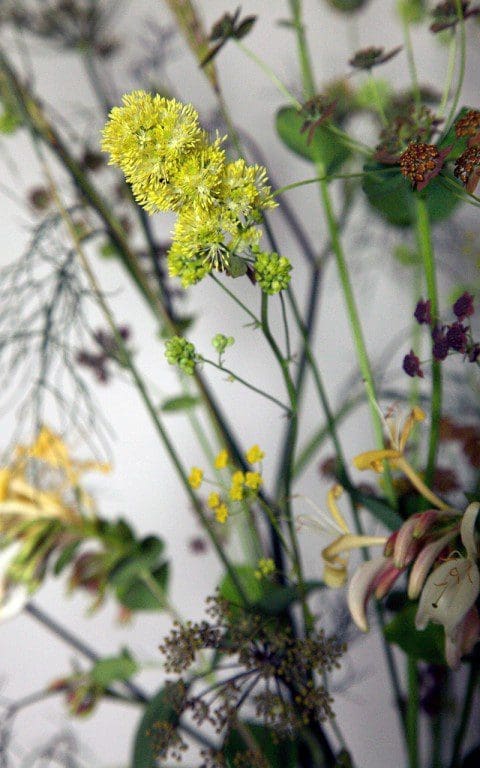 Thalictrum flavum ssp. glaucum
Thalictrum flavum ssp. glaucum
Thalictrum flavum ssp. glaucum rises up and above most of its companions on wire thin stems which catch our breezes, but there is no need for staking until they hang heavier with seed. I cut them to the base to avoid the seedlings at this point as the clumps are long-lived and you need just a handful to make an impression. The fluffy flowers are a pure sulphur-yellow and the leaves are the blue green of cabbages but fine, like lace.
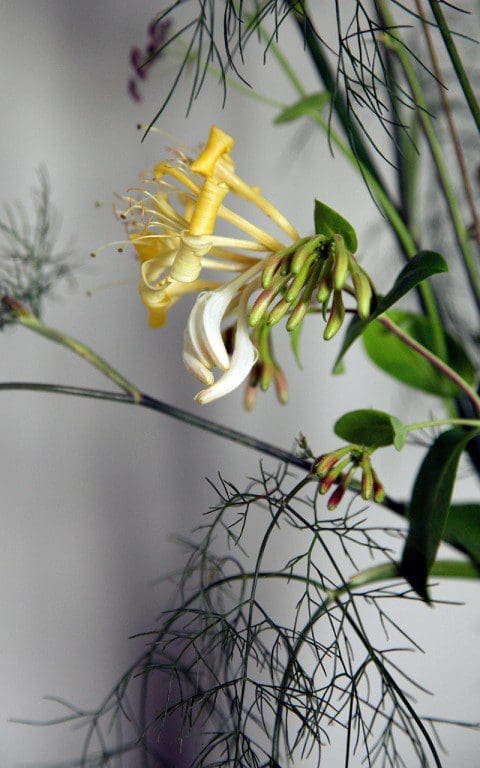 Lonicera periclymenum ‘Graham Thomas’
Lonicera periclymenum ‘Graham Thomas’
This is a good selection of the wild honeysuckle called ‘Graham Thomas’. I first saw it growing on his house when we were taken to meet him as Wisley students. I had no idea then how influential a plantsman he was, nor how much I would have enjoyed his namesake all these years later. I much prefer it to the brickier, shorter-flowering varieties such as ‘Belgica’ and ‘Serotina’. It also flowers far longer than its native parent and, after its first July flush, continues off and on into September.
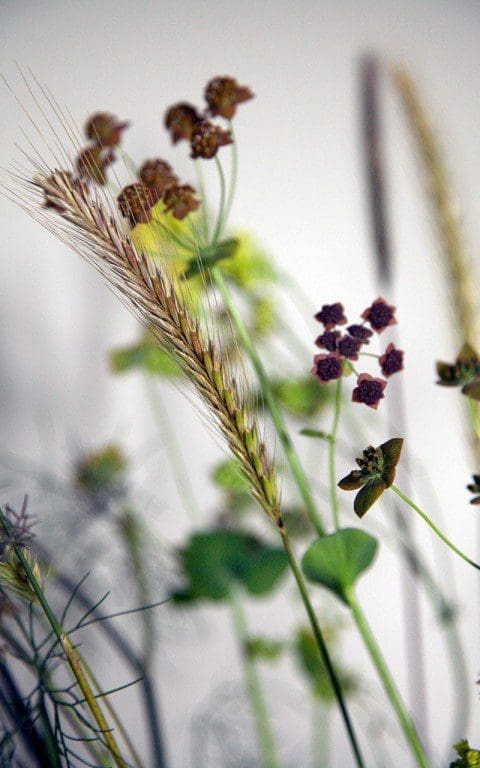 Hordeum bulbosum
Hordeum bulbosum
The bulbous barley, Hordeum bulbosum, was collected on a trip to Greece a few years ago. It has proven to be completely perennial, retreating to a basal cluster of storage organs after flowering. I cut it before it seeds to limit its spread, as it germinates freely. In Greece the storage organs (which give it its species name) would keep it alive during a summer without rain to reactivate growth in the autumn. Here, without a water shortage to speak of, it is happy to return with a second flush in September. The flowers are early, rising in April, to trace every breath of wind outside the windows.
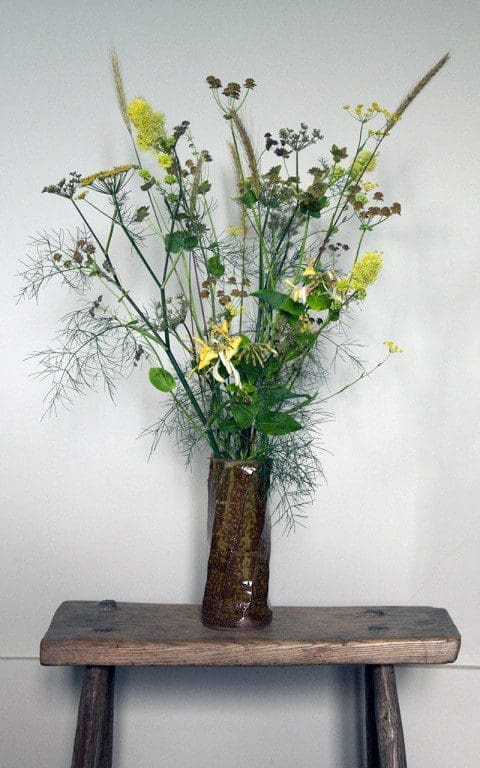
Words: Dan Pearson / Photographs: Huw Morgan
Artichokes are one of the pre-eminent Italian ingredients and so it makes sense to look to Italy for ways in which to prepare them. This recipe is from the River Café Cook Book Green which, alongside Jane Grigson’s Vegetable Book, is the cook book I turn to most frequently when looking for inspiration for good simple vegetable recipes.
Recipes for artichoke are legion, but they usually follow one of a number of tried and tested treatments; boiled and eaten with vinaigrette or another sauce such as bagna cauda, braised with herbs in stock or oil (sometimes with a stuffing), deep-fried, roasted or chargrilled or, more unusually, sliced very thinly and eaten raw as a salad vegetable.
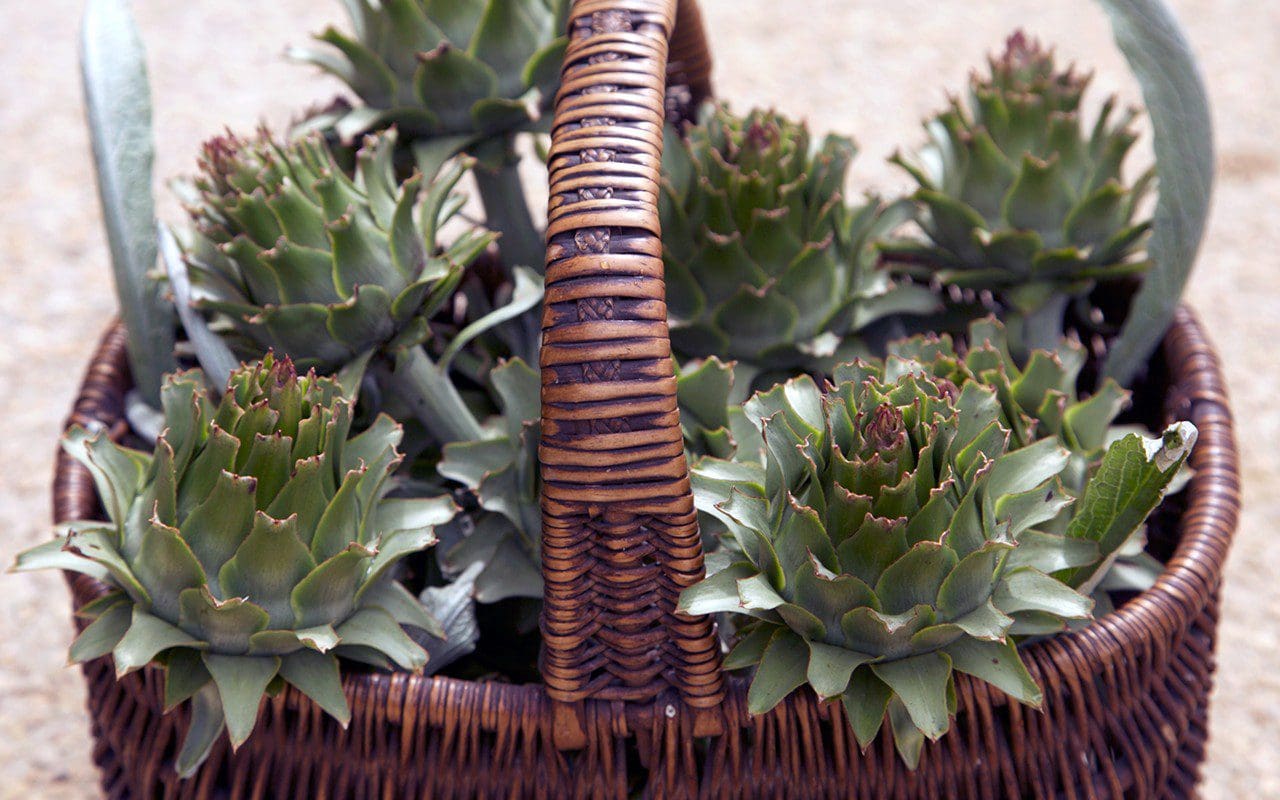
This recipe attracted my attention as the artichoke hearts are used raw to make a pesto-like sauce for pasta. The pesto itself is a pale beige colour and so this is not necessarily the most photogenic of platefuls, but it is the delicate flavour of the artichokes that is so readily captured; their slightly resinous and nutty flavour foregrounded by this simple treatment. The sauce is deliciously creamy and rich, yet it has a completely vegetal freshness. I have halved the number of garlic cloves called for in the original recipe as, to my taste, they overwhelm the subtlety of the artichokes.
At this time of the year I trim the stalks and bases from all the artichokes, even the smallest, as these parts become increasingly fibrous towards the end of the season. If you make this earlier in the season with young artichokes it is possible to use the first 5cm of the stalk too, once the fibrous outer layer has been peeled away.
The pesto can also be used like a tapenade on bruschetta or crostini topped with some shaved Parmesan or Pecorino, or a slice of Parma or San Daniele ham. To use it in this way prepare as for the sauce below, but allow the pesto to cool after adding the butter.
Serves 6
Ingredients
400g spaghetti Sea salt and freshly ground black pepper Freshly grated Parmesan
ARTICHOKE PESTO 6 small globe artichokes 2 lemons 100g pine kernels or blanched almonds 2 cloves garlic 250ml milk 2 handfuls flat leaf parsley 150g Parmesan, freshly grated 150ml olive oil 75g unsalted butter
Method
First prepare the artichokes. Squeeze one of the lemons and put the juice and the quartered lemon hull into a bowl containing enough cold water in which to submerge the prepared artichokes. Slice the second lemon in half and keep close by.
Carefully pull the tough leaves away from the base of the artichokes, proceeding in concentric circles until you reach the softer cream leaves towards the heart. With a small, very sharp knife carefully remove the stalk and trim any dark green remnants of the leaves from the base. Immediately rub all cut surfaces with one of the lemon halves.
Cut off the green and spiny tops of the leaves and discard. Cut each artichoke heart in half and remove the hairy choke in the centre with a small teaspoon. Rub all surfaces with one of the lemon halves again and put the artichokes into the acidulated water. Continue until they are all done. You should have around 200g of artichoke hearts.
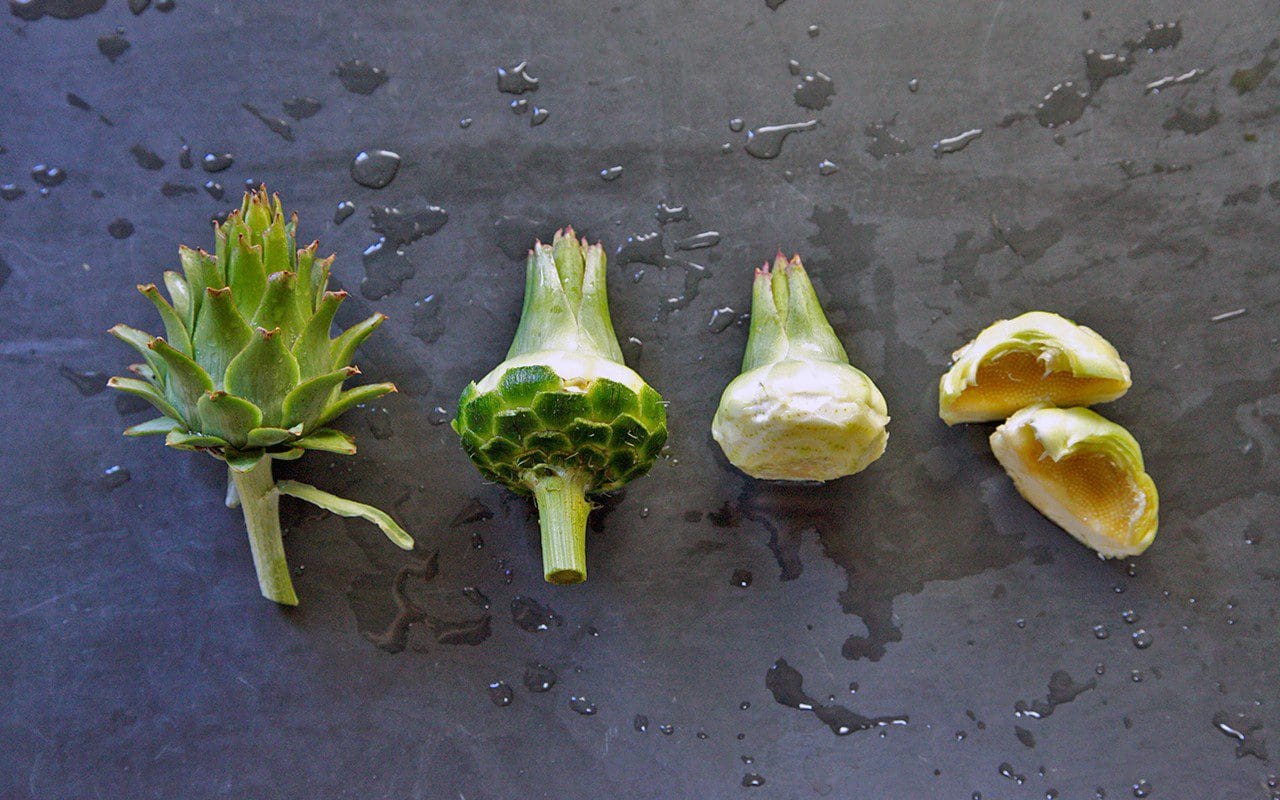
Drain and dry the artichoke hearts and put into a food processor with the garlic and pine kernels or almonds. Process quickly until coarsely chopped. Add the milk, parsley leaves and Parmesan and process quickly again. With the food processor running at a slow speed gradually add the olive oil. You should have a fairly wet cream, but it will thicken as it stands. Season with salt and put into a small saucepan.
Cook the spaghetti in boiling salted water until al dente. Drain and return the spaghetti to the pan with a ladleful of the cooking water. While the pasta is cooking add the butter to the pesto and put over a low heat. Stir frequently until the butter has melted and is well incorporated and the sauce has heated through. Add the sauce to the pasta and stir well to coat. If it seems a little thick add some more of the pasta water until a coating consistency is achieved. The sauce should be quite wet.
Serve with freshly grated Parmesan and a sprinkling of coarsely chopped flat leaf parsley.

Words & photographs: Huw Morgan
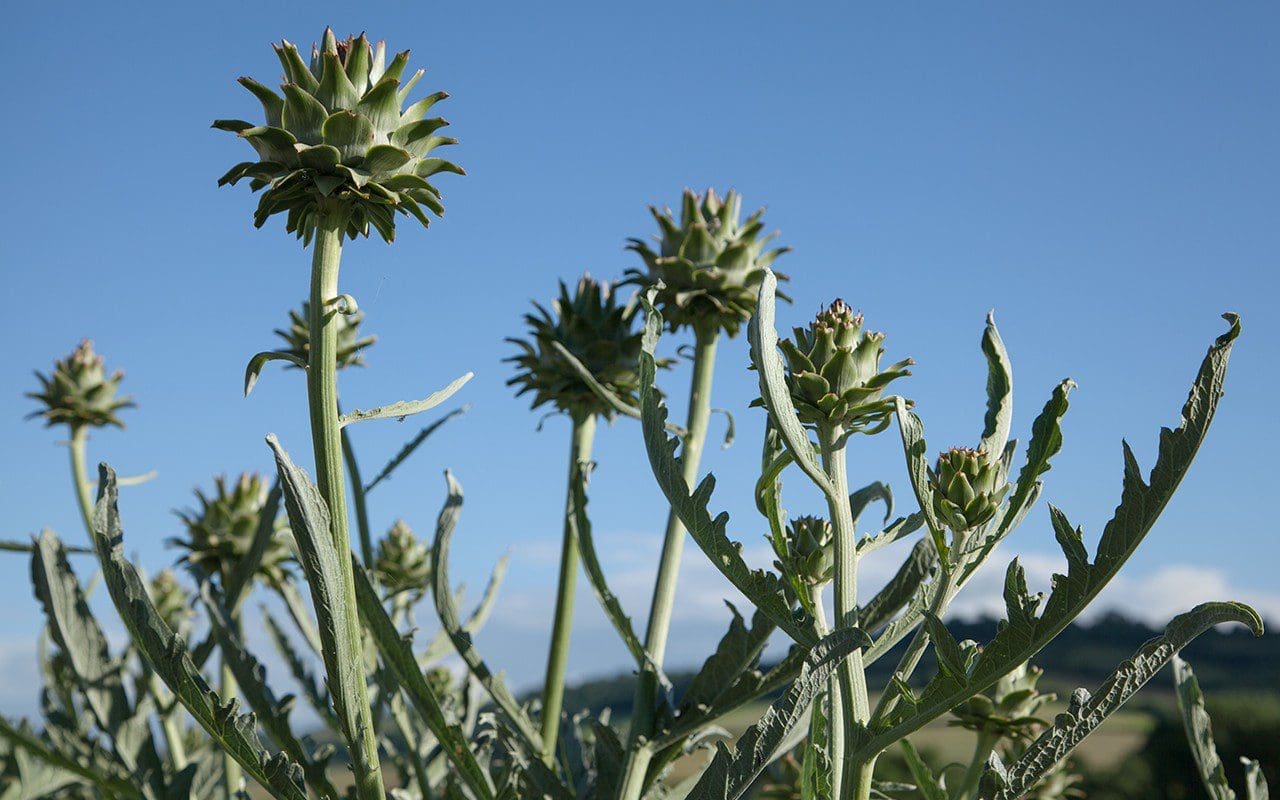
The globe artichokes (Cynara cardunculus Scolymus Group) were some of the first plants to go into the new kitchen garden. They are a luxury vegetable, taking far more space than they provide reward for and shading their neighbours if, indeed, there is room left in their shadow. Nevertheless, I gave them a bed to themselves, in prime position and against the radiated heat of the newly built wall.
They have grown in spectacular fashion – which is the greater part of the reason for having them – doubling and trebling their bulk in the course of the first summer and continuing onward to take all the space which was offered them. Cold weather in combination with winter wet is their nemesis but, since they were planted, both winters have been mild and they have only had a brief down time in the darkest months when they retreat to a core cluster of leaves.
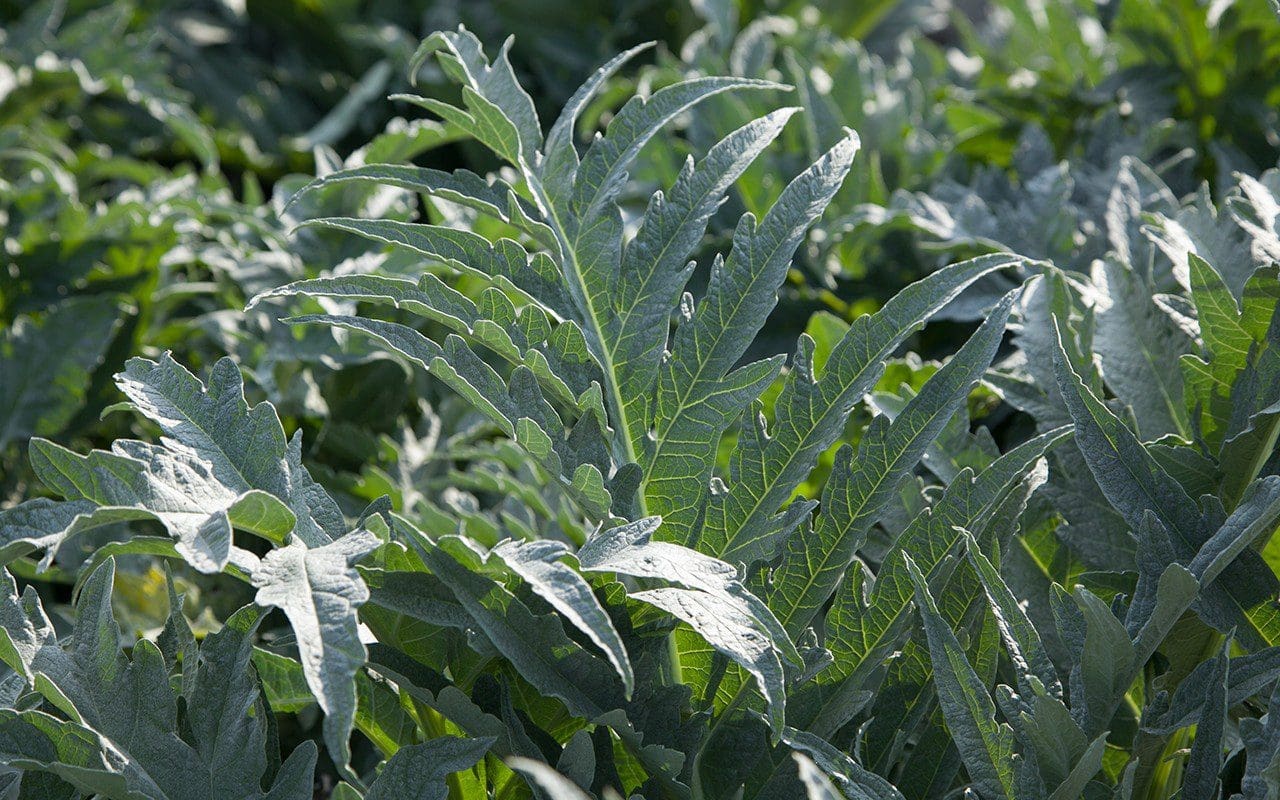
Their aluminium foliage is wonderful in its ascendancy and as good as acanthus in its architecture. As soon as the weather warms in March it reaches from the clump, each leaf larger and more dramatic than the last, scrolling and bulking steadily until you see that, some time in May, the parent foliage has gathered enough energy for the flower spikes. These push proud of the forest of leaves, but it is whilst the heads are small that you need to curtail their reach and harvest the artichokes.
We grow a variety called ‘Bere’, which Paul Barney of Edulis Nursery offers, and is the selection his father found growing in the walled garden there in the 1950’s. It is spinier than some of the named varieties, but Paul says it is the best tasting of them all. Indeed, it is a wonderful plant if you pick the heads whilst they are still young and before they are fully armoured. The best and meatiest parts are still soft when the leaf spines are forming, but leave them to harden and fulfil their thistly leanings and you end up with an impossibly fibrous mouthful.
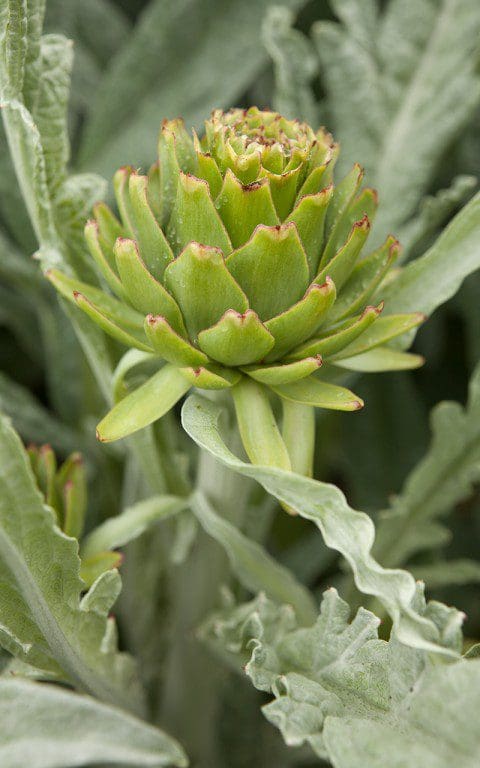 Cynara cardunculus Scolymus Group ‘Bere’
Cynara cardunculus Scolymus Group ‘Bere’
I plan to split my clumps in the spring, when growth is on the move and the crowns are manageable. Being mediterranean, they start life as soon as there is warmth and moisture in combination but, being sensitive to the cold, you have better chances in spring than if you move them at end of the season. It is a two-man job to lift the clumps and then prise a division, with root, from the clump. The divisions or ‘starts’ will be planted in the new herb garden, where they will provide ornamental architectural structure amongst the herbs.
I have six plants now, far too many of the same variety, so the plan is to thin the ‘Bere’ to three and equal it with the same number of purple-tinged ‘Romanesco’ to make up the half dozen. ‘Romanesco’ is an altogether friendlier plant without spines, and the scales that form the thistle head are soft and can easily be harvested and prepared without the need for gloves.
Each plant will be spaced a metre apart and inter-planted with stands of bronze fennel, which will cover for the artichokes’ collapse, which happens in high summer once all their energy has gone into flower production. At this point, once the old leaves start to fail revealing bare ankles, it is best to cut the lot to the ground and let the foliage regenerate. It will be back for the autumn, whilst the fennel covers during the recovery period.
In Italy the cardoon is also prized in the early spring for its edible leaves. The midribs, which look like celery, are stripped of the leaves and fibres, and then blanched and buttered, or baked in a gratin. You need rhubarb amounts of room for such a short season vegetable, but if you do have a spare corner in sunshine they are sure to provide you with drama at the very least.
I first grew the ornamental cardoon (Cynara cardunculus) as a border plant at Home Farm. Innocent looking divisions arrived from Beth Chatto, as beautifully wrapped in damp newspaper as they are described in her catalogue. They were planted in an ambitious group of three on a sunny slope and took their position, rearing up in a mound of metallic foliage. Tapering in August to a magnificent pinnacle of branching flower, the plants reach about three metres in height, and need staking if they are not to topple once the flowers break colour. Look up and you see bees staggering about drunk on the fist-wide pools of neon violet filaments.
The butterflies love them too, but the giant needs to be felled if it is not to leave you with a gaping hole once the collapse starts to happen. At Home Farm I planted it within a corral of late summer perennials, spaced at a sensible distance so that they can swallow the hole whilst it regenerates. Asters and rudbeckia will do the job, but you have to give the cardoon space in spring as it is an early season riser.
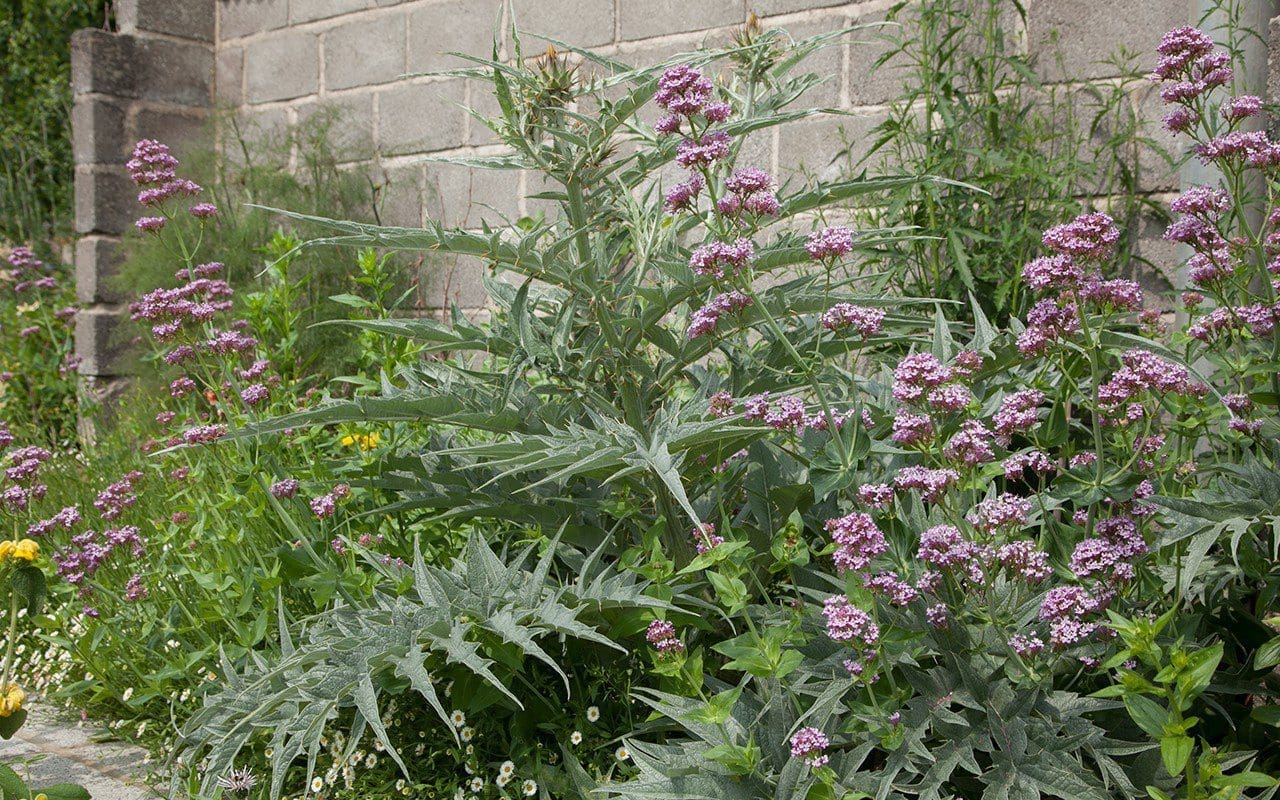 Cynara cardunculus ‘Dwarf Form’ with Centranthus lecoqii
Cynara cardunculus ‘Dwarf Form’ with Centranthus lecoqii
Fergus Garret pointed me to a dwarf form that they have in the garden at Great Dixter and I grow it here against the barn. I am not usually a fan of plants selected for dwarfism, but this cardoon makes for a better-behaved plant. It is distilled in all it’s parts, and more evil to the touch, the undersides of every leaf defended with an armoury of needle-sharp spines. Its foliage is as beautiful, possibly more finely divided, and certainly more compact. It tops out at about a metre and so avoids the need for staking. In the border where I grow it with Centranthus lecoqii and Romneya coulteri it has taken it’s territory, but the repercussions are altogether more manageable, and I still feel I have the drama I am looking for.
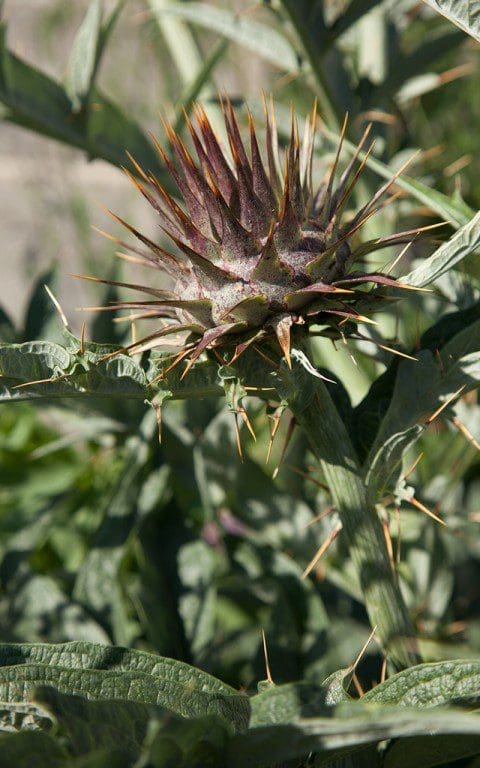 Cynara cardunculus ‘Dwarf Form’
Cynara cardunculus ‘Dwarf Form’
Words: Dan Pearson / Photographs: Huw Morgan
The third week in June, around the solstice, is when the roses are at their best – first flowers opened and buds yet to come. The week usually coincides with weather and this bunch was picked just before a black sky gave way to thunder, lightning and downpour.
The roses are part of my trial of getting to know good garden plants. There was never room to indulge their showiness in the Peckham garden and, when we arrived here, they were one of the first things that were planted. I felt I could get away with them if they were treated as part of a productive garden. They push against the flow of what we want to do here and couldn’t be more out of place with the landscape backdrop. But a bunch brought in for the house is an opulent indulgence.
They are now in their sixth summer and I am beginning to see which are the good ones and which are the weaklings. There are twenty four varieties in total, all David Austin selections and each was chosen for their perfume, colour, flower shape and general mood. Here are a bunch of a half dozen.
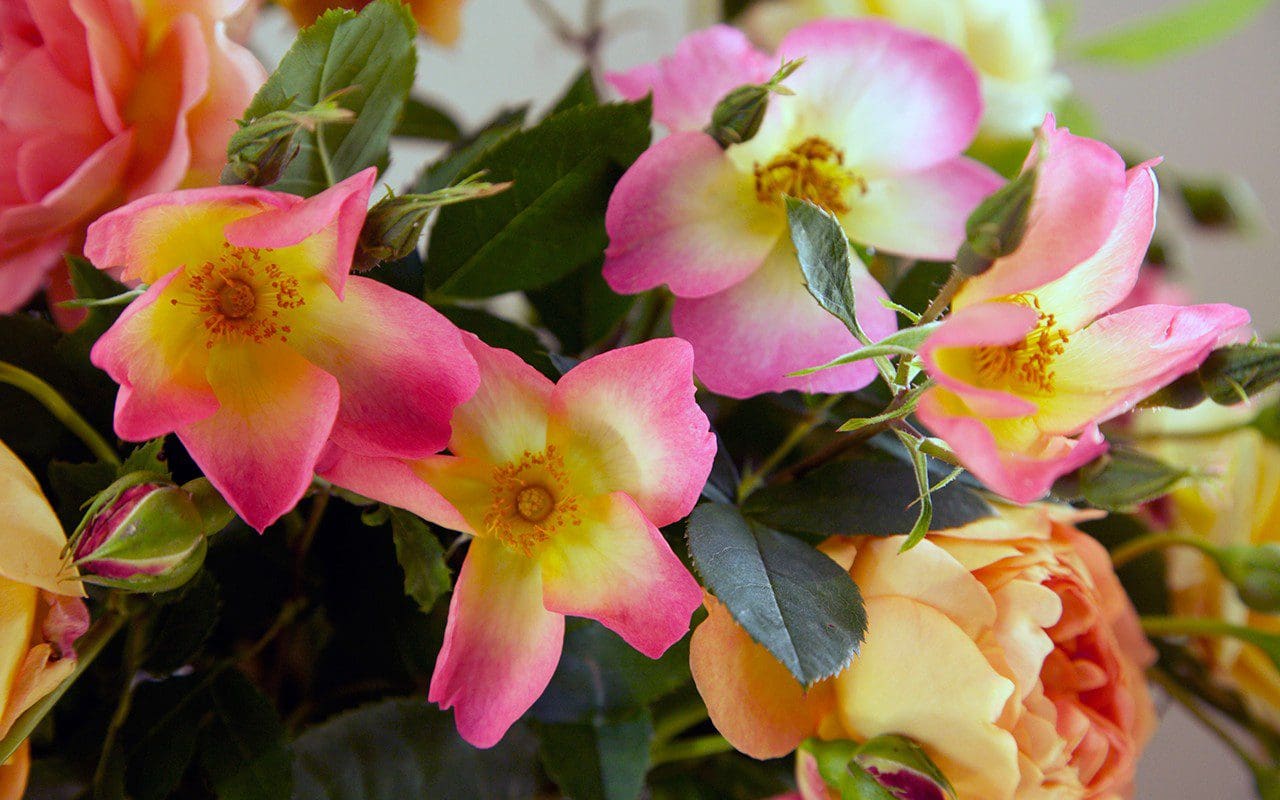 The Alexandra Rose
The Alexandra Rose
I like to have singles in the mix as they bring a little of the wild as a contrast to the doubles. The Alexandra Rose is one of my favourites, making a relaxed bush and open sprays of flower that fade as they age.
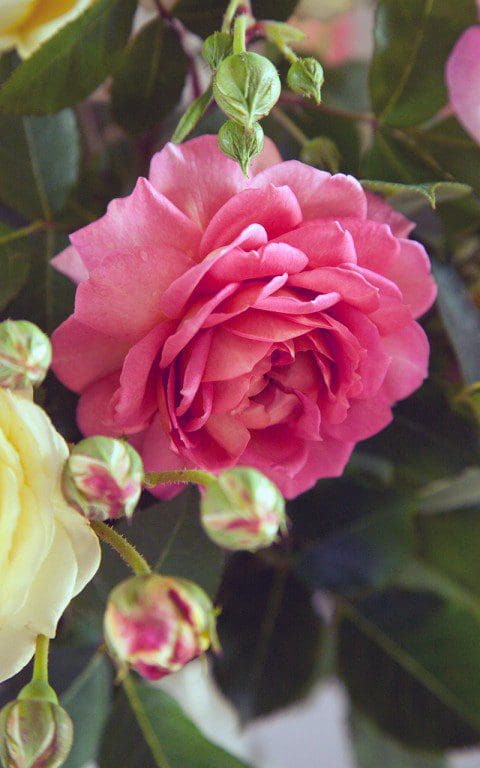 Jubilee Celebration
Jubilee Celebration
Jubilee Celebration is perhaps the weakest plant, but not unhealthy, and it has a strong true rose scent. The colour is a very distinctive old rose which ages to apricot. It is also a wonderful shape with backward curled petals.
 From the top; Pat Austin, Lady of Shallott & The Lark Ascending
From the top; Pat Austin, Lady of Shallott & The Lark Ascending
Pat Austin is a rangy grower, but healthy and consistent. The flowers are a golden peach, slightly pendulous on the bush and smell of Earl Grey tea.
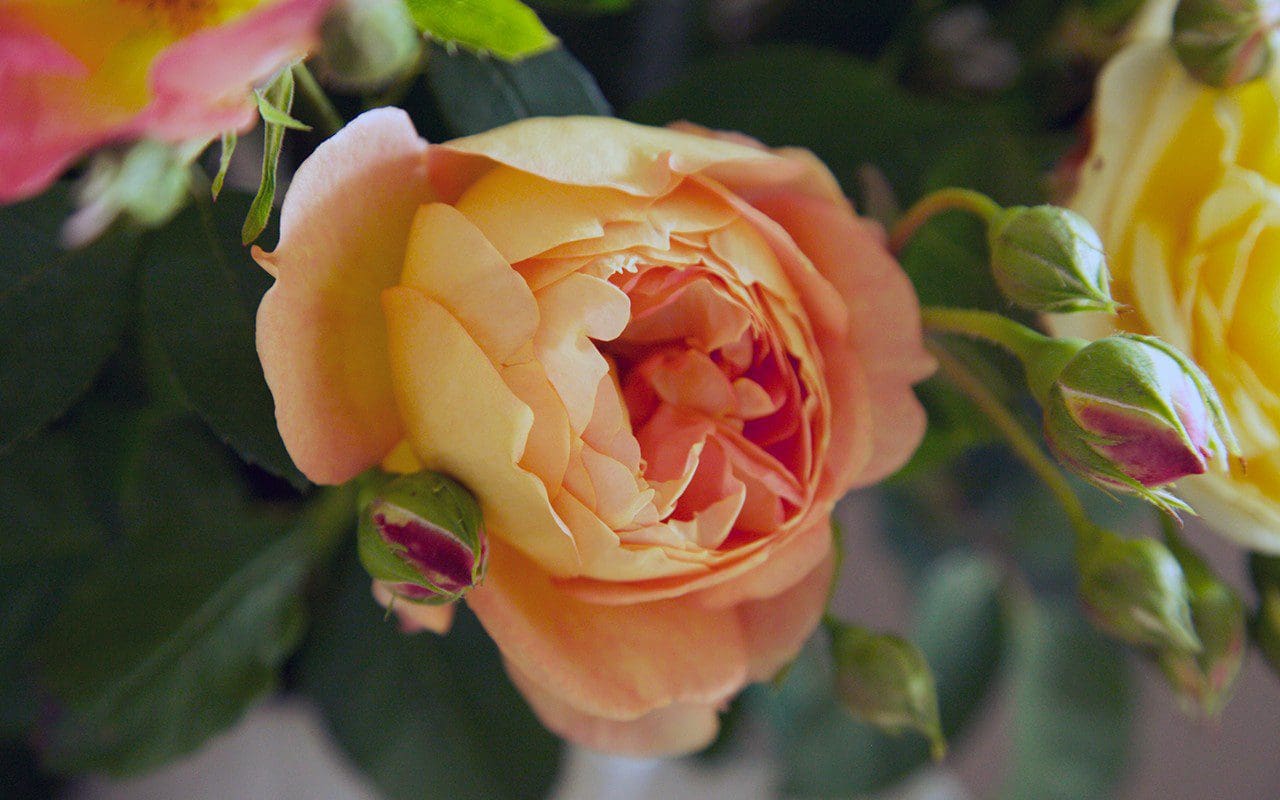 Lady of Shallott
Lady of Shallott
Lady of Shallot’s bowl-shaped blooms are shot pink over apricot. The colour is duller than Pat Austin but no less lovely.
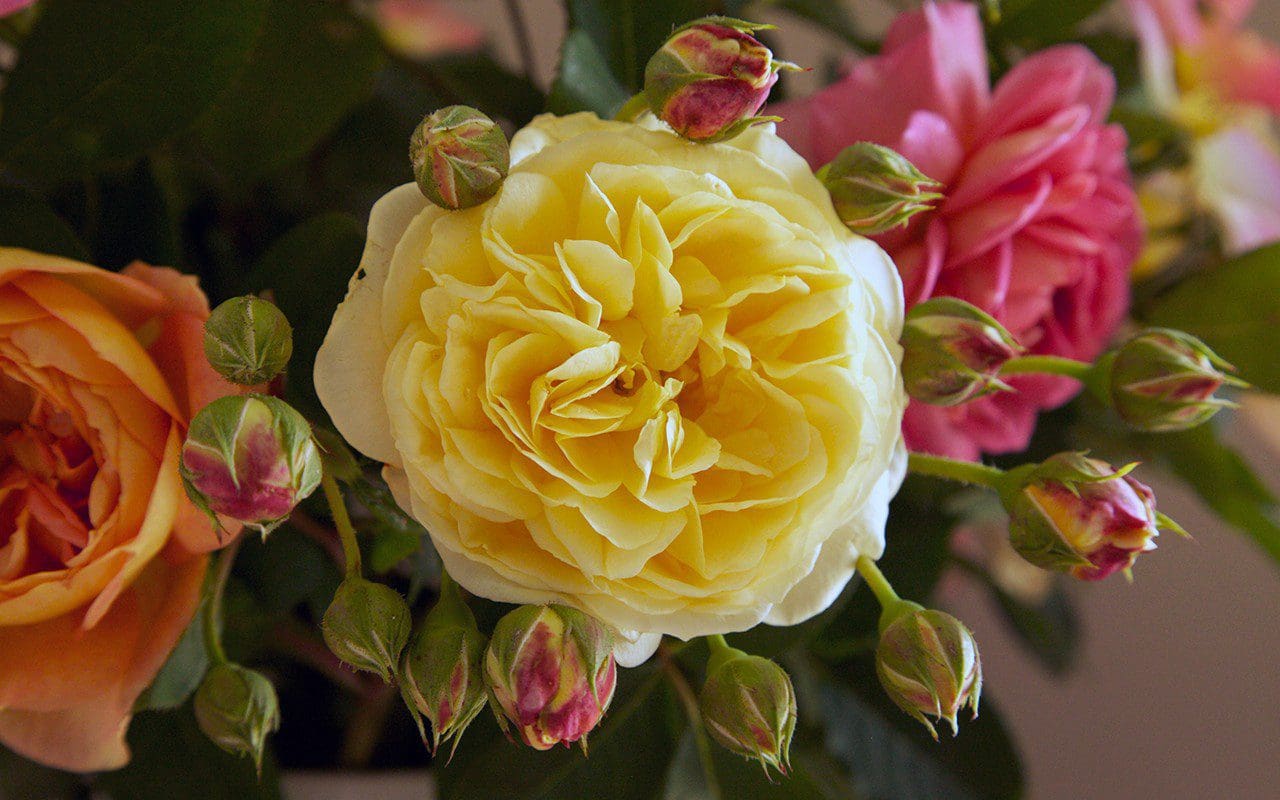 Teasing Georgia
Teasing Georgia
Teasing Georgia is the most yellow of this bunch. It is a really good rose with plenty of vigour, which can be put to a wall and trained as a climber. The flowers are the most quartered of this selection and open flat.
 The Lark Ascending
The Lark Ascending
The Lark Ascending is not such a good picker as it drops quickly, but I love it’s loose pale peach flowers which seem to tumble from the bush. It has fewer petals and it is a pretty grower, never stiff and therefore a good candidate for a mixed planting in a border. Not that this will be the case here. The cutting garden is the cutting garden where I can break my own rules and simply enjoy the flowers.

Words: Dan Pearson / Photographs: Huw Morgan
Broad beans (Vicia faba) are a kitchen garden staple for us and, gratifyingly, one of the easiest crops to grow. Every year we make an autumn sowing from October to early November, depending on the weather. If sown early in a warm autumn they can grow too large before winter and are then susceptible to wind rock, frost or snow. If sown too late in a cold, wet autumn there is not be enough time for them to get away before winter descends. Autumn sown beans are less prone to black-fly, produce stockier plants and an earlier crop of beans. In a warm spring this is sometimes as early as mid-May.
Our first harvest this year was in early June, but we also made a spring sowing of beans in 9cm pots in early March, which were brought on in the cold frame and planted out in April. These plants are starting to crop now, just as we have taken the last of the beans from the winter sown plants. In a good year this means that we can have beans from mid-May until mid-July.
In our experience spring sown plants tend to be leggier and less productive, so it is worth choosing shorter-growing varieties as the taller ones will need staking. We habitually sow Super Aquadulce in winter and Hangdown Green in spring. As soon as the beans are finished you should cut off the growth above ground, but leave the roots in the soil as they fix nitrogen. Replant with later summer leaf vegetables which thrive on the nitrogen, such as salad or chard.
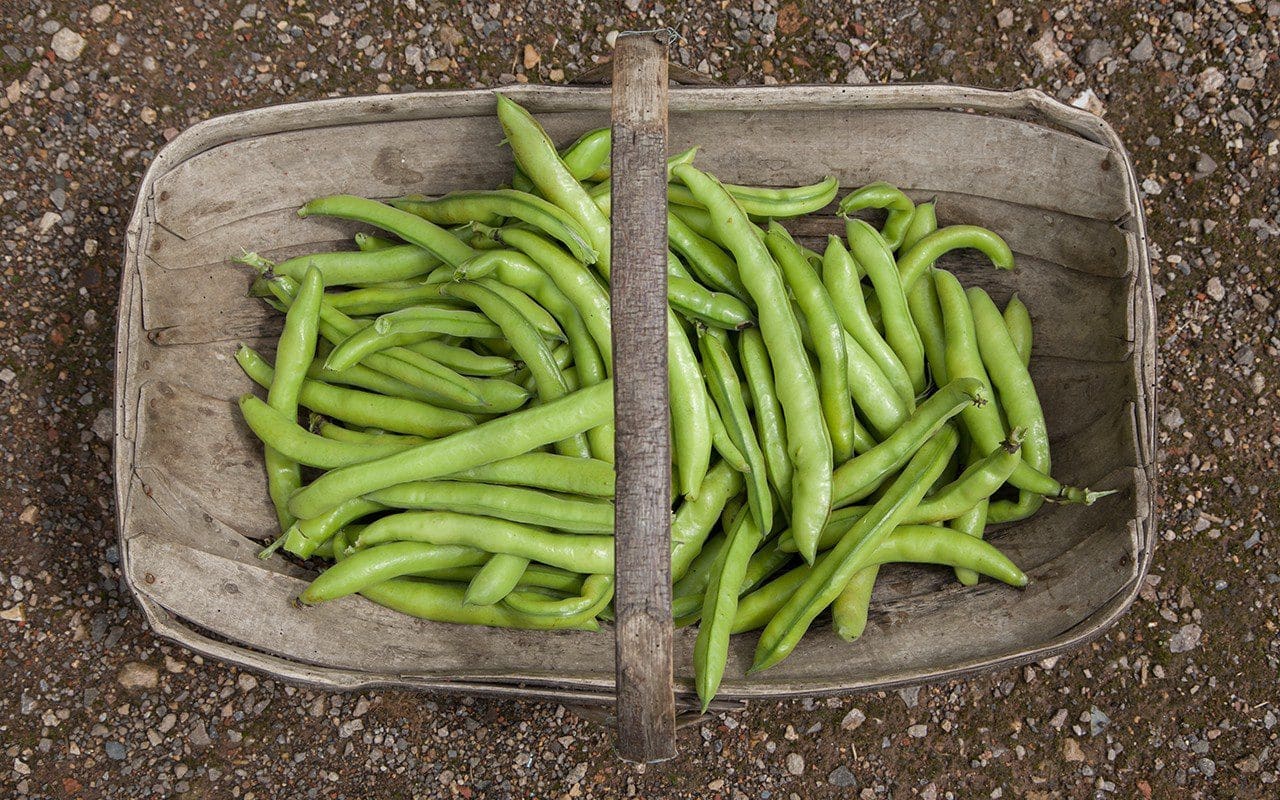
At this crossover point from the winter to spring sown beans we often end up with a mixed harvest of large and medium sized beans, with their tougher, more bitter skins, and very small, sweet beans which can be eaten straight from the pod. If so I will cook them in two batches, cooking the larger beans for 3 minutes and just blanching the smaller ones for a minute.
This is such a simple recipe and one I return to every year in some shape or form. Who doesn’t like fresh garden vegetables on toast ? It is extremely adaptable and, as the season progresses the broad beans can be replaced with peas, chargrilled courgettes, roasted young beetroot or carrots, wilted chard, chargrilled chicory or blanched french beans. The herb can be substituted with others as available and appropriate – dill, fennel, chervil, basil or parsley. If you can’t find ricotta substitute with goat or sheep’s curd, or a soft young goat’s cheese.
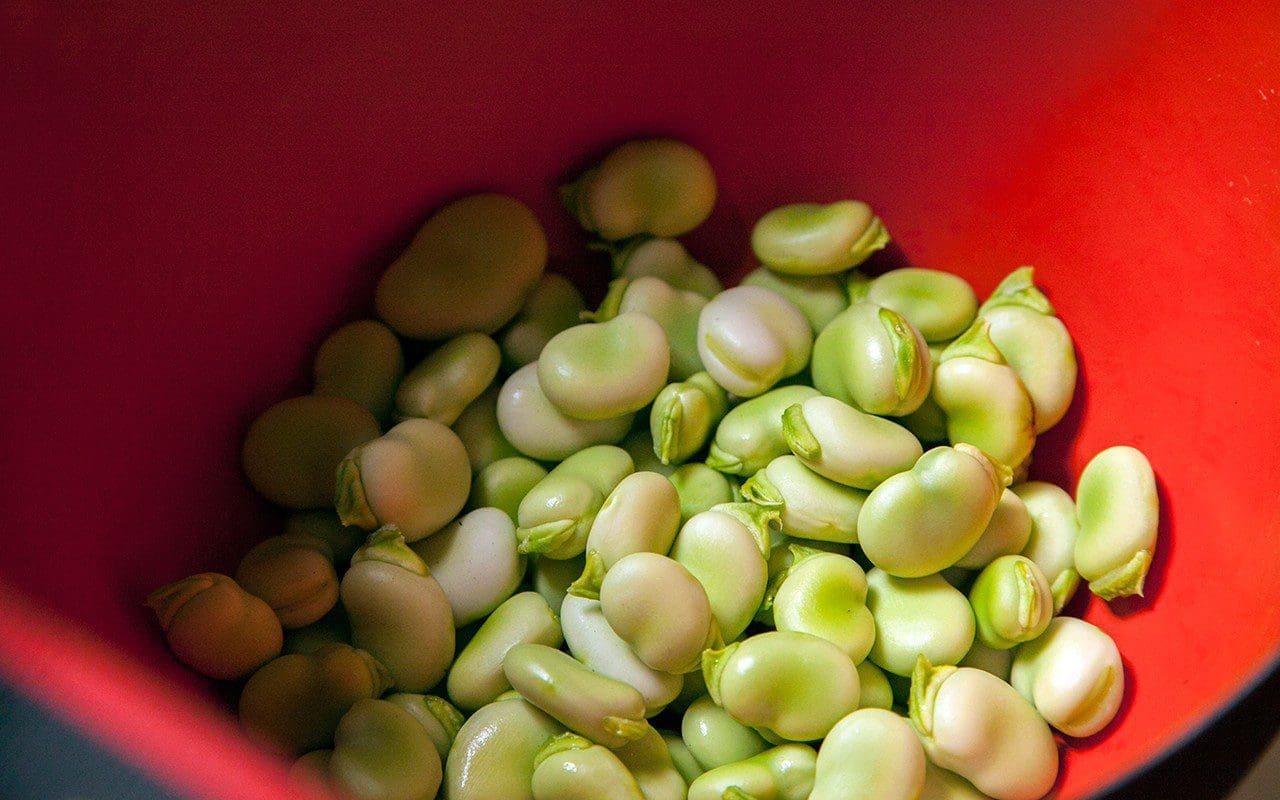
Serves 2
Ingredients
150g podded broad beans
200g ricotta
2 thick slices of sourdough bread
Extra virgin olive oil
A clove of garlic
Zest and juice of 1/2 a large lemon
A handful of mint leaves, coarsely chopped, a few reserved to finish
Salt and ground black pepper
Method
Bring a pan of water to the boil. Cook the beans in batches for 1 – 3 minutes, depending on size. Drain and put into a bowl of cold water to refresh. Drain again.
Remove the large and medium beans from their skins – the very smallest can be left with their skins on – and put into a bowl with the mint, half the lemon zest, the lemon juice and two tablespoons of olive oil. Season to taste and stir.
Season the ricotta with salt and pepper to taste.
Drizzle or brush olive oil onto both sides of the sourdough bread. Grill each side until well browned with some light charring. Alternatively bake in a hot oven (200°C) for 8 to 10 minutes, turning them over at the half way point. When done and while still hot, rub the upper side of each slice of toast with the clove of garlic.
Spread half of the ricotta on each slice of toast. Spoon on the broad beans. Finish with the reserved mint leaves, the remaining lemon zest and a drizzle of olive oil.
Serve immediately.
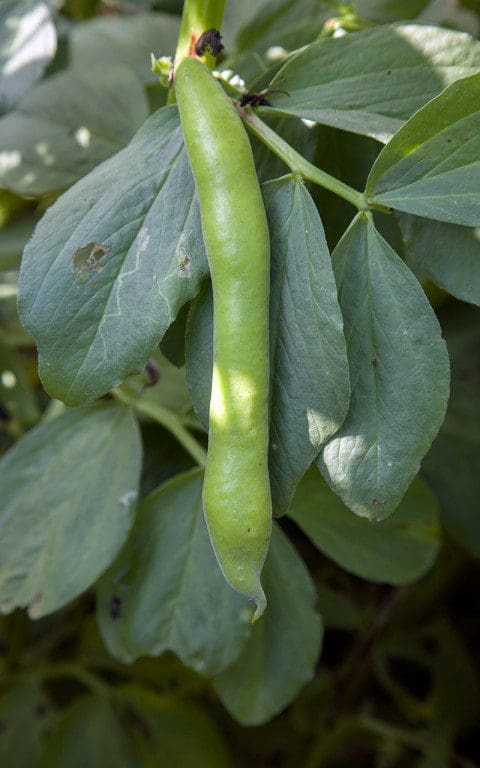
Recipe & photographs: Huw Morgan
When my friend Anna gave me a seedling of ‘Bill Wallis’ a few years ago she said, “You may hate me for giving you that !”. I had admired it seeding about in the gravel that wrapped her house and thought it’s willingness to perform would be good in the rubbly ground at the base of the tin barns. In the early summer, we see Geranium pyrenaicum (Hedgerow or Mountain Cranesbill) clambering up into the cow parsley where it smatters the fresh June greenery with pinpricks of the brightest magenta.
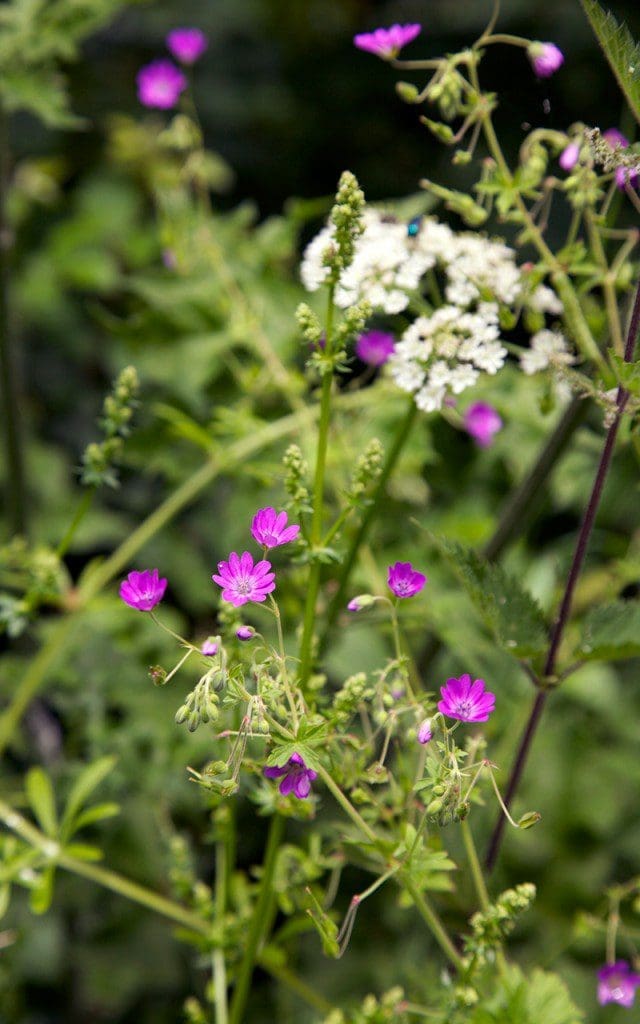 Geranium pyrenaicum
Geranium pyrenaicum
Now so common in southern England that it is considered a native, this geranium was not recorded in the wild in Britain until 1762. As the verges grow out we seem to lose sight of it, but not ‘Bill Wallis’.
Bill Wallis was a passionate plantsman who set up The Useful Plant Company after his retirement in 1979. He chanced upon the original seedling (with flowers of a more electric violet than the wildling’s pinker hue) in a neighbour’s garden, and it was named after him by Joe Sharman of Monksilver Nursery, who propagated the cultivar and launched it at the Chelsea Flower Show.
The earliest flowers, which appear in April, are only about the size of a halfpenny but, by the solstice, they have massed in number clambering through their neighbours to pepper them with colour. A low basal rosette is the origin of this energy and, some time late in June, it is wise to cut them to the base and let them start again. The plentiful seed, like that of all cranesbills, is catapulted far and wide, and it is prudent to diminish the number of volunteers if you find that it likes you. Regrowth brings with it fresh foliage and new flower for the latter half of summer and the seedlings that have got a foothold are easily weeded out when they are young.
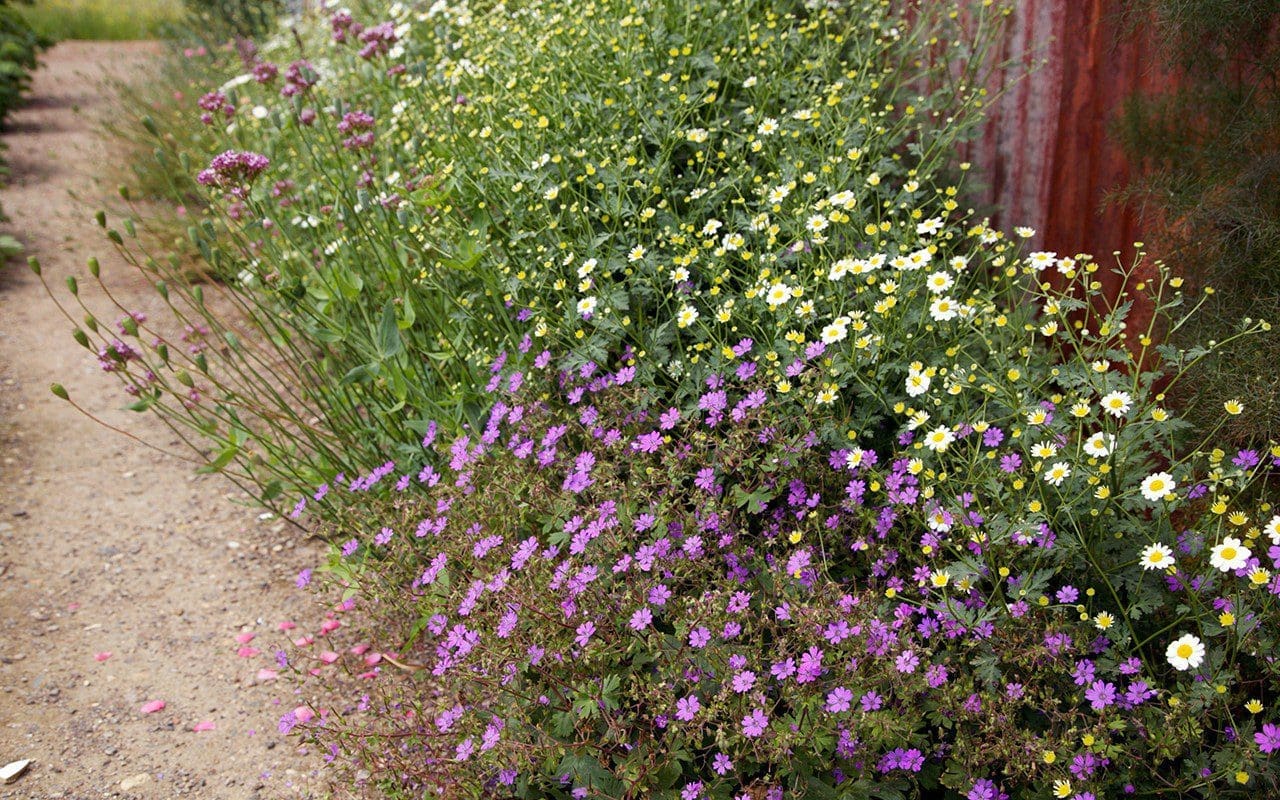
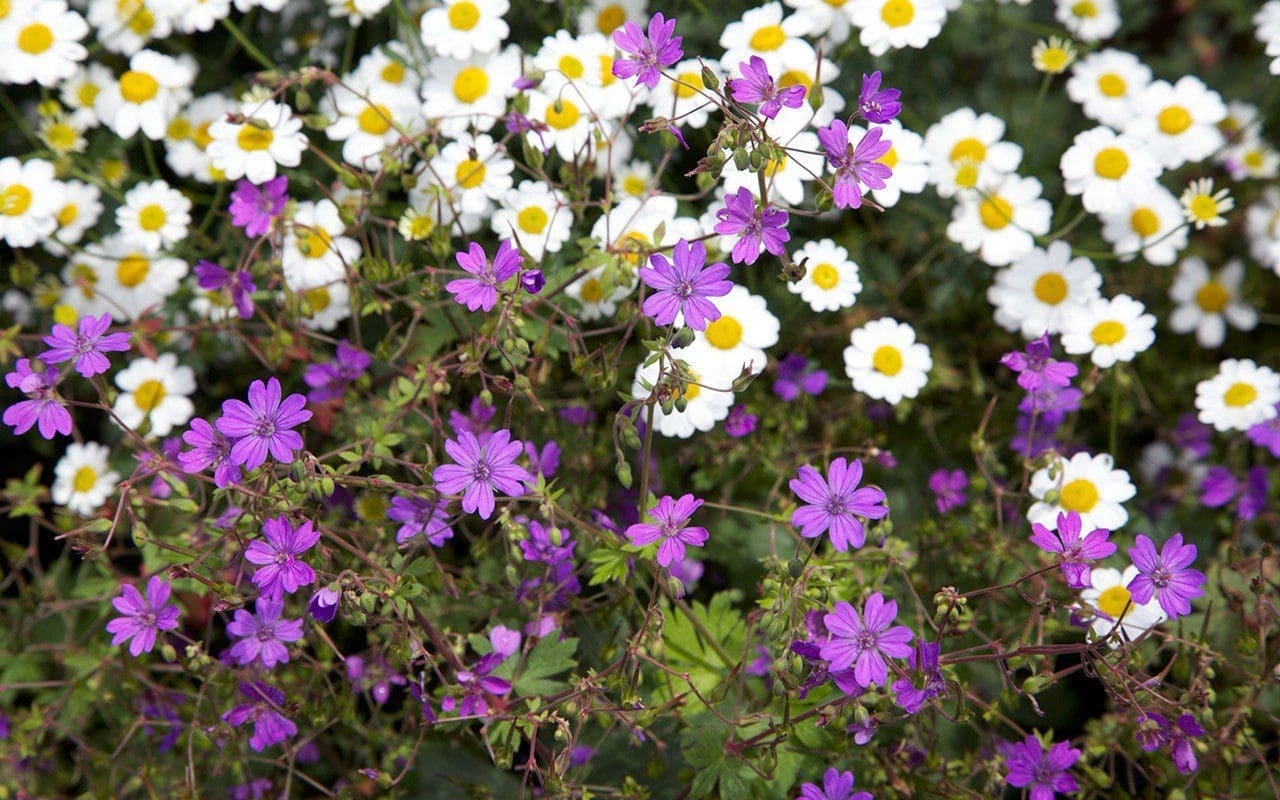 Geranium p. ‘Bill Wallis’ and Tanacetum niveum
Geranium p. ‘Bill Wallis’ and Tanacetum niveum
‘Bill Wallis’ seems happy out in bright sunshine, but you get a little more out of it, and the colour is more luminous, when grown in a little shade, as if on a verge or popping out from beneath a hedge. It is not averse to dry ground, so for now I have it growing up into the limbs of white tree lupin and Tanacetum niveum, where it spills out to soften the edges of the path. Competing for the open ground with Papaver rupifragum, Erigeron karvinskianus and Matthiola perennis ‘Alba’ these self-seeding pioneers provide me with chance combinations that I can then call my own. We will see where it ends up next year.
I may find that, in time, I will concur with Anna’s warning, but for now I am prepared to manage its spontaneity. Such is the joy of a plant that has a mind of its own.
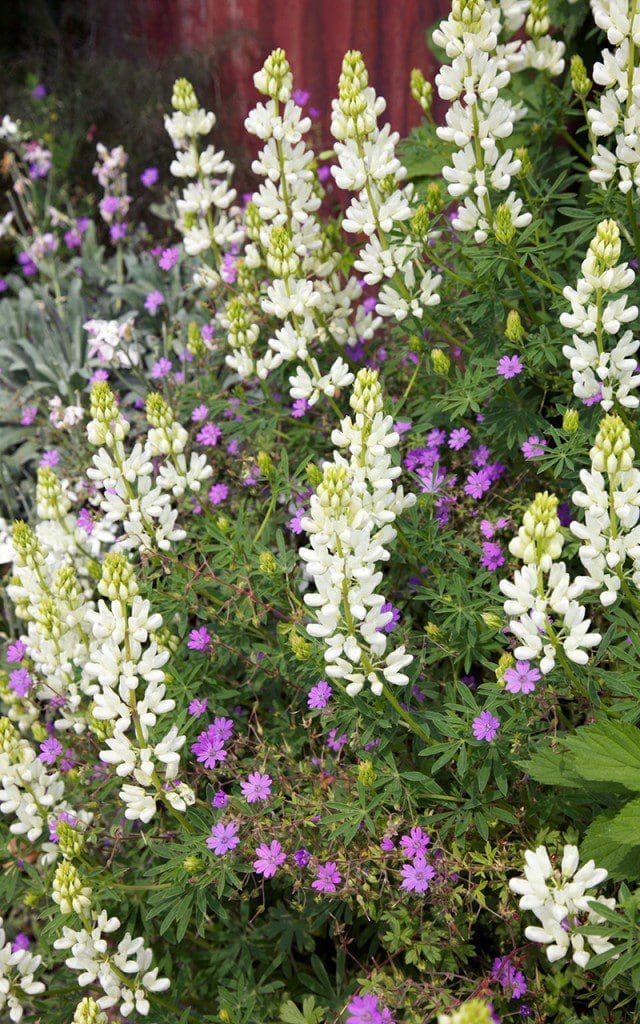 Geranium p. ‘Bill Wallis’ growing through white tree lupin
Geranium p. ‘Bill Wallis’ growing through white tree lupin
Words: Dan Pearson/Photographs: Huw Morgan
We are sorry but the page you are looking for does not exist. You could return to the homepage